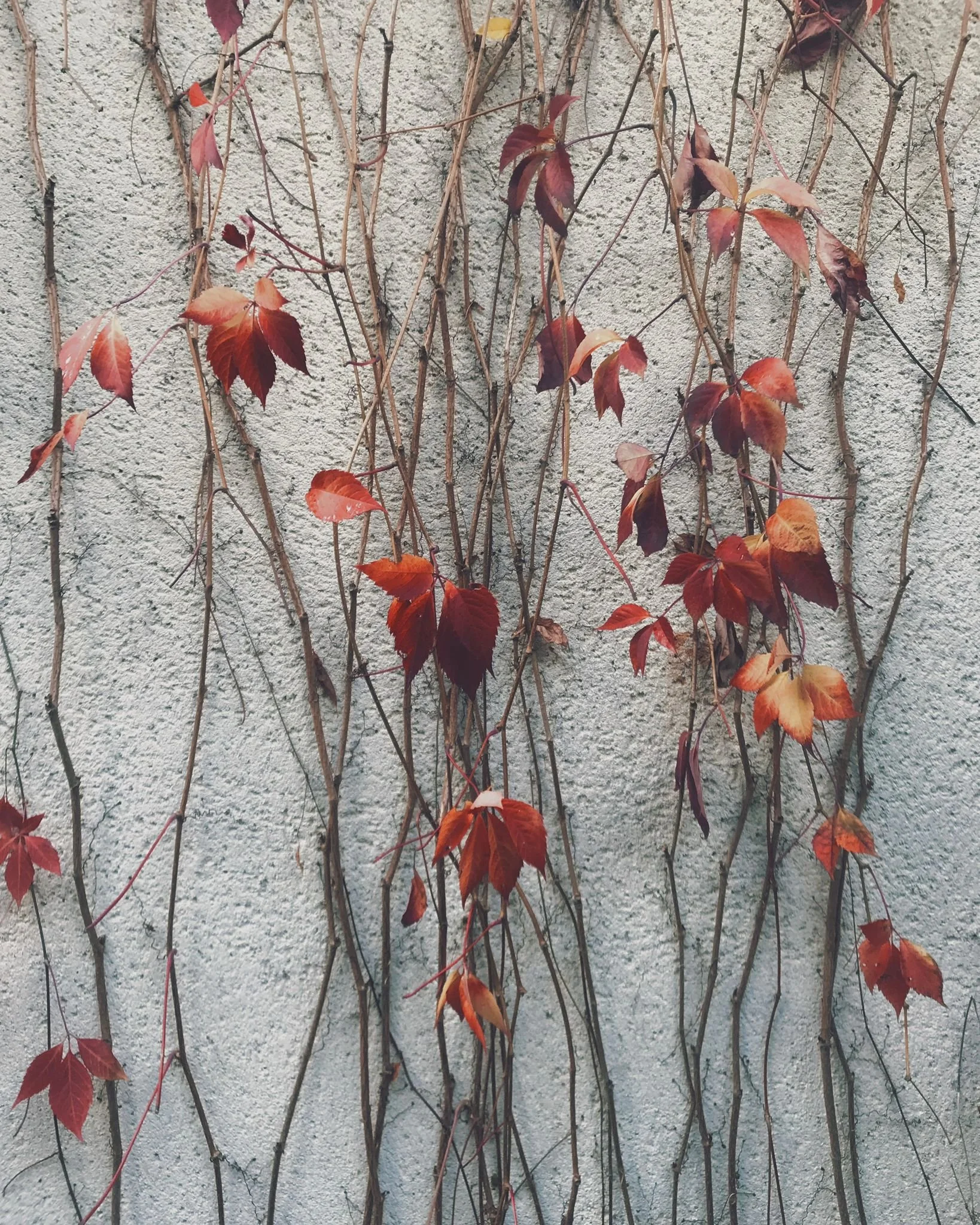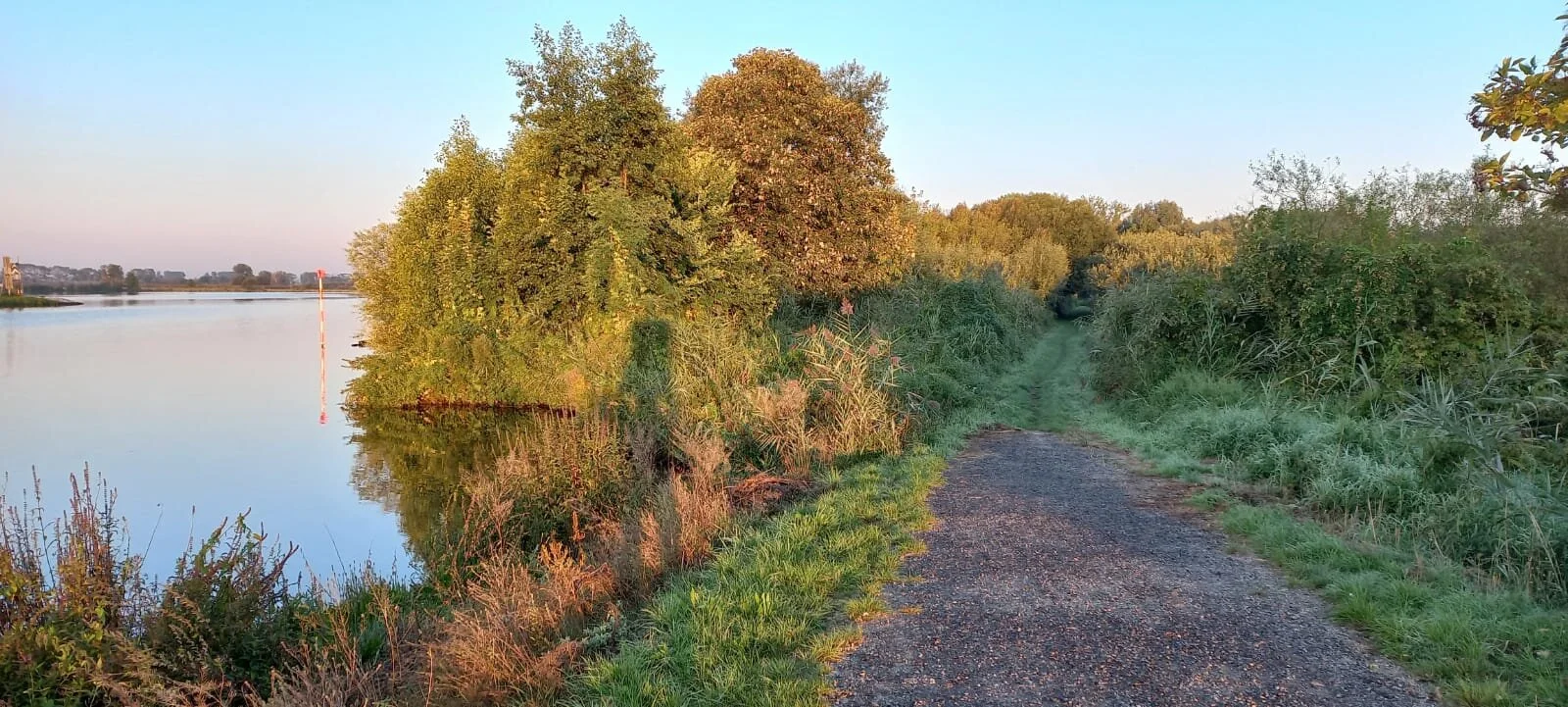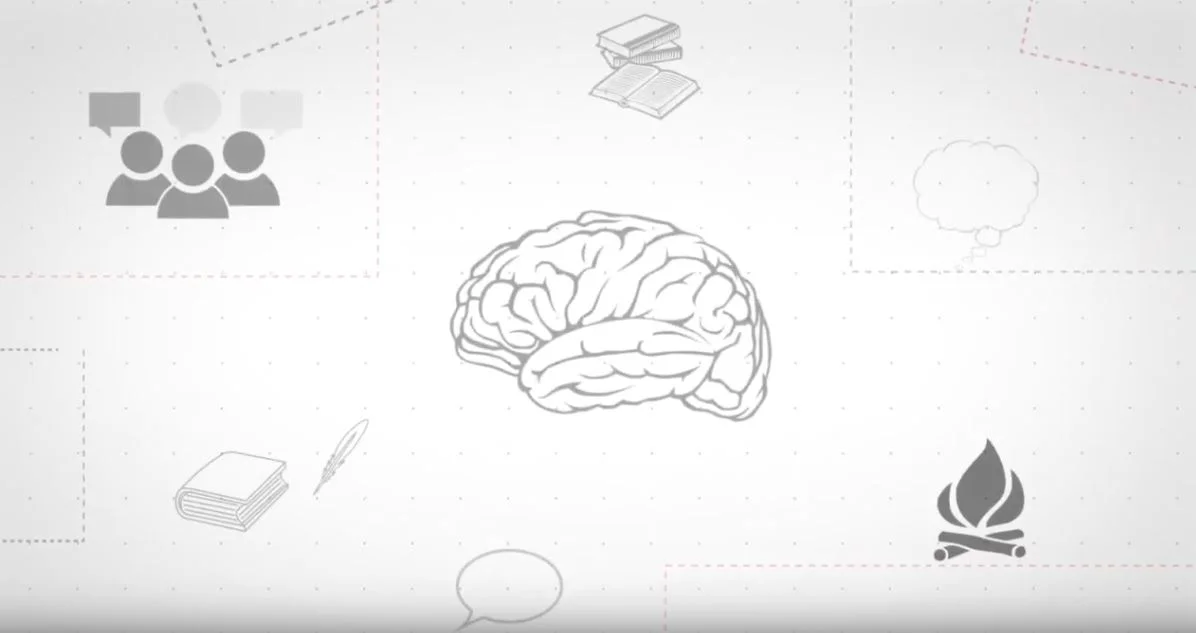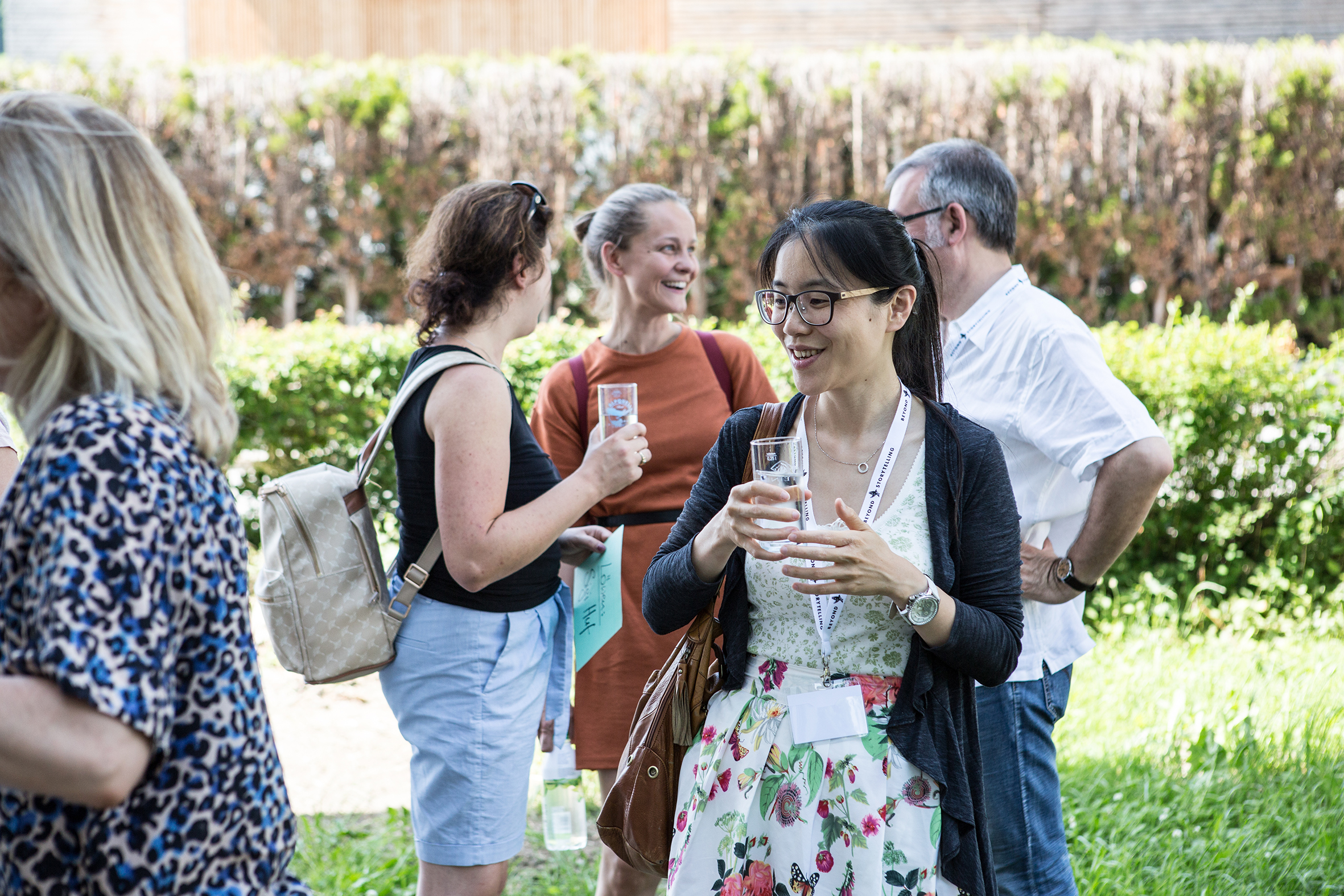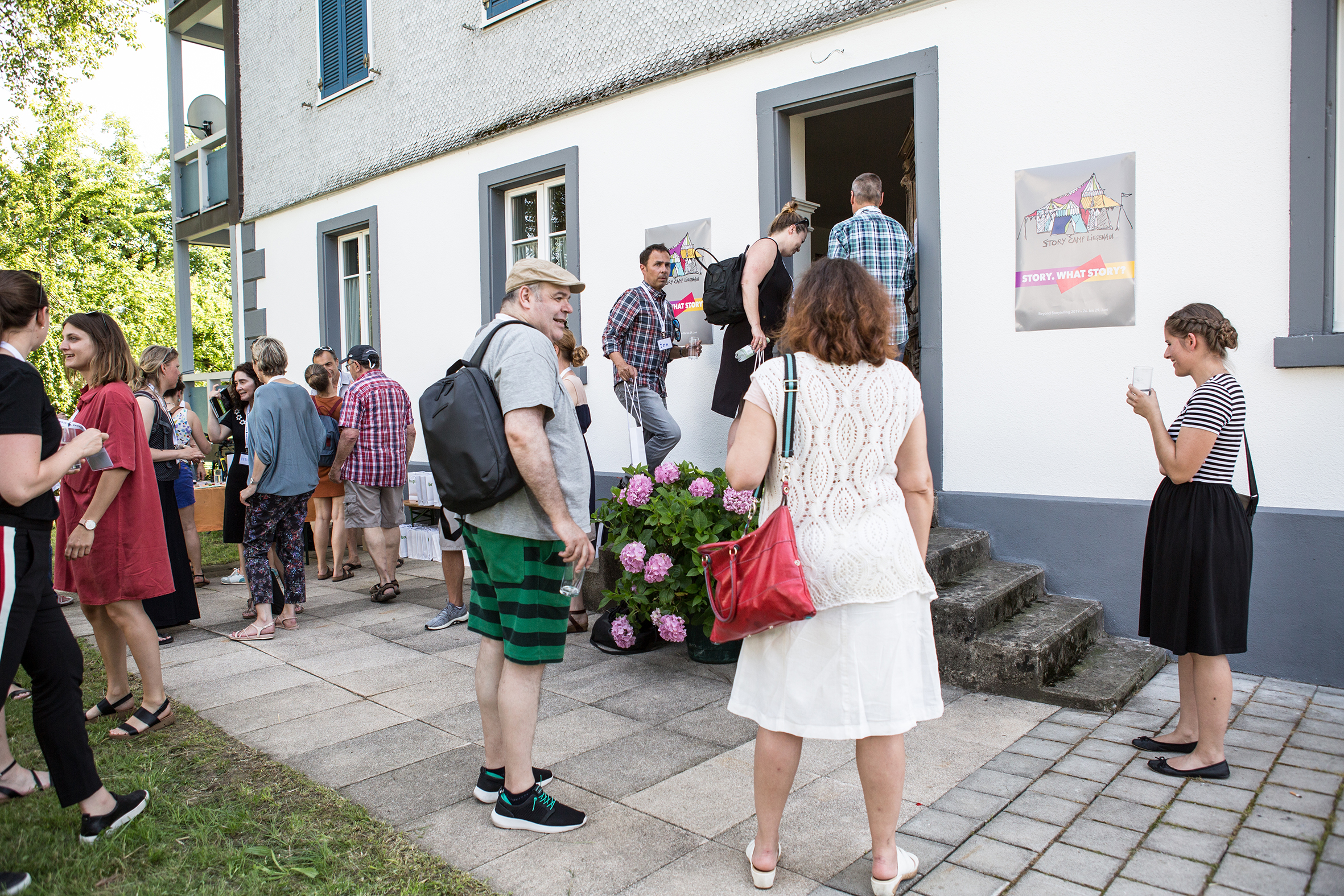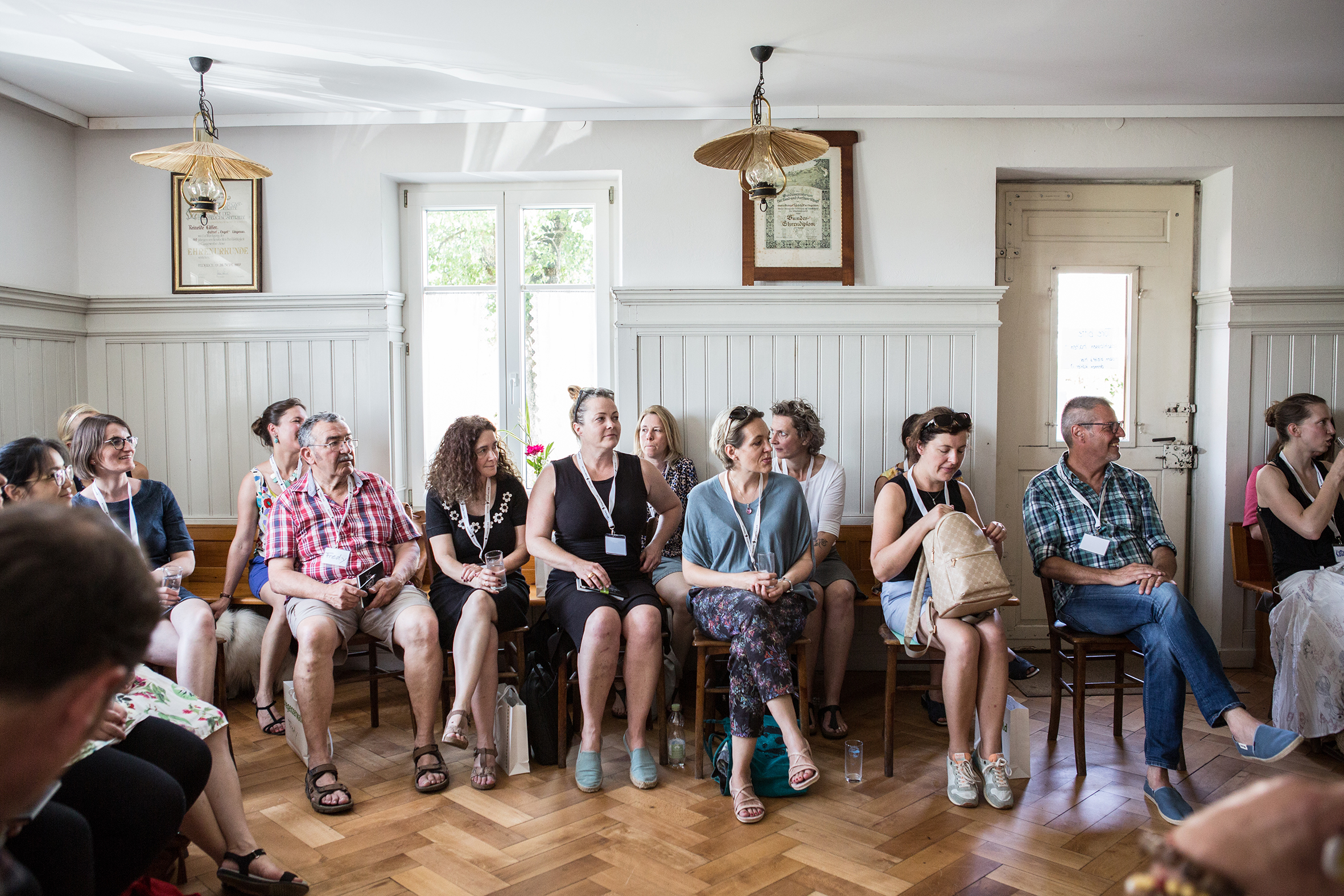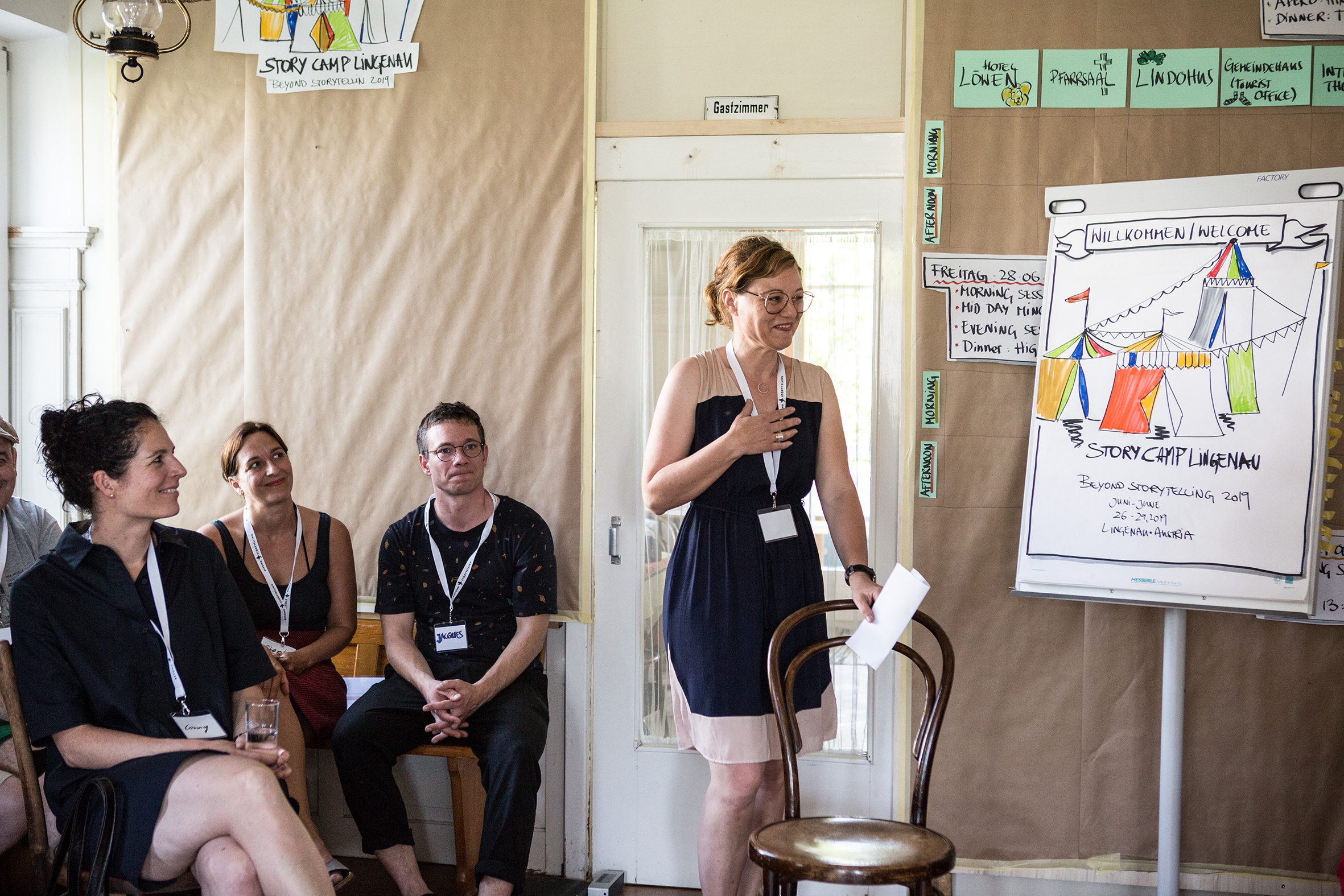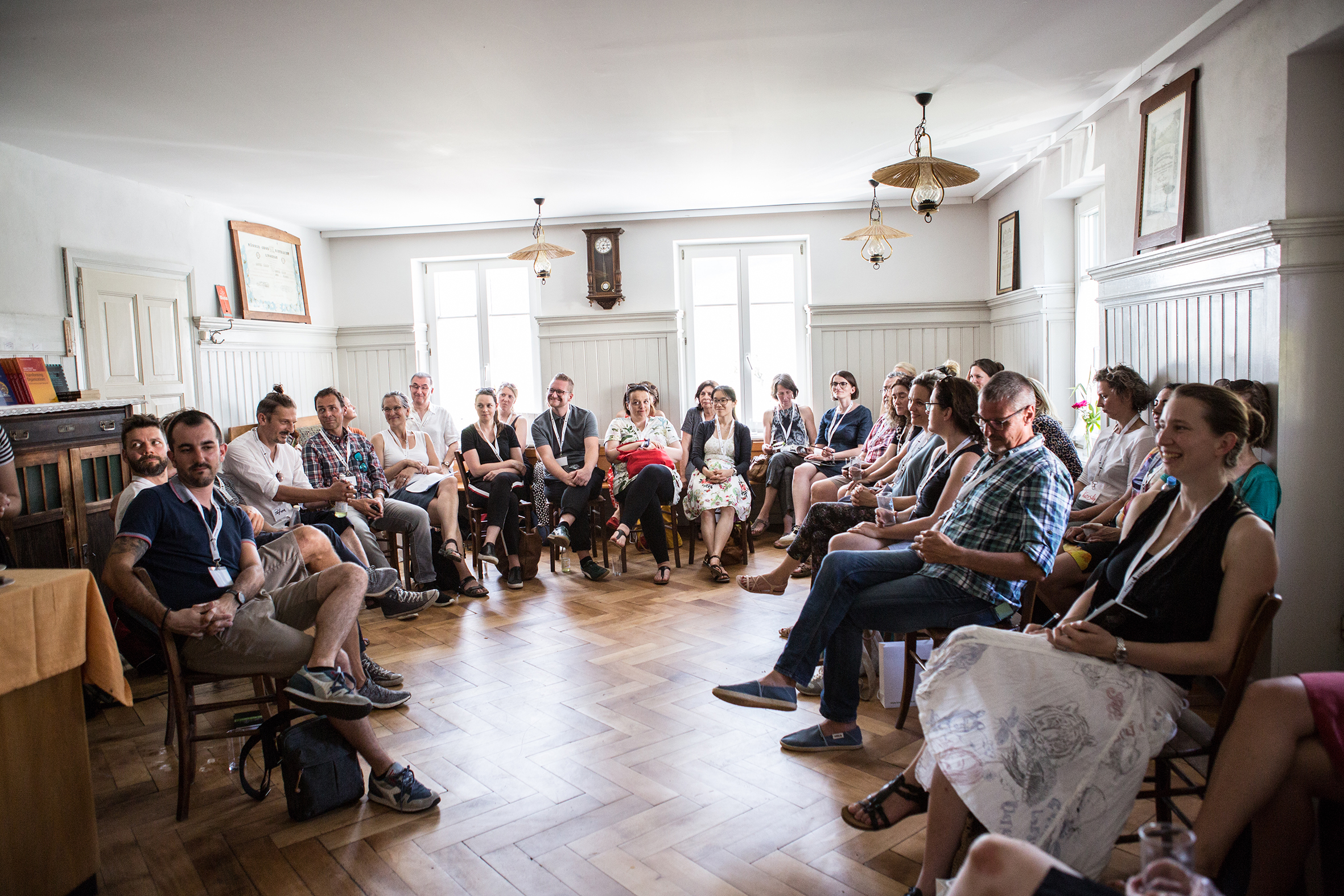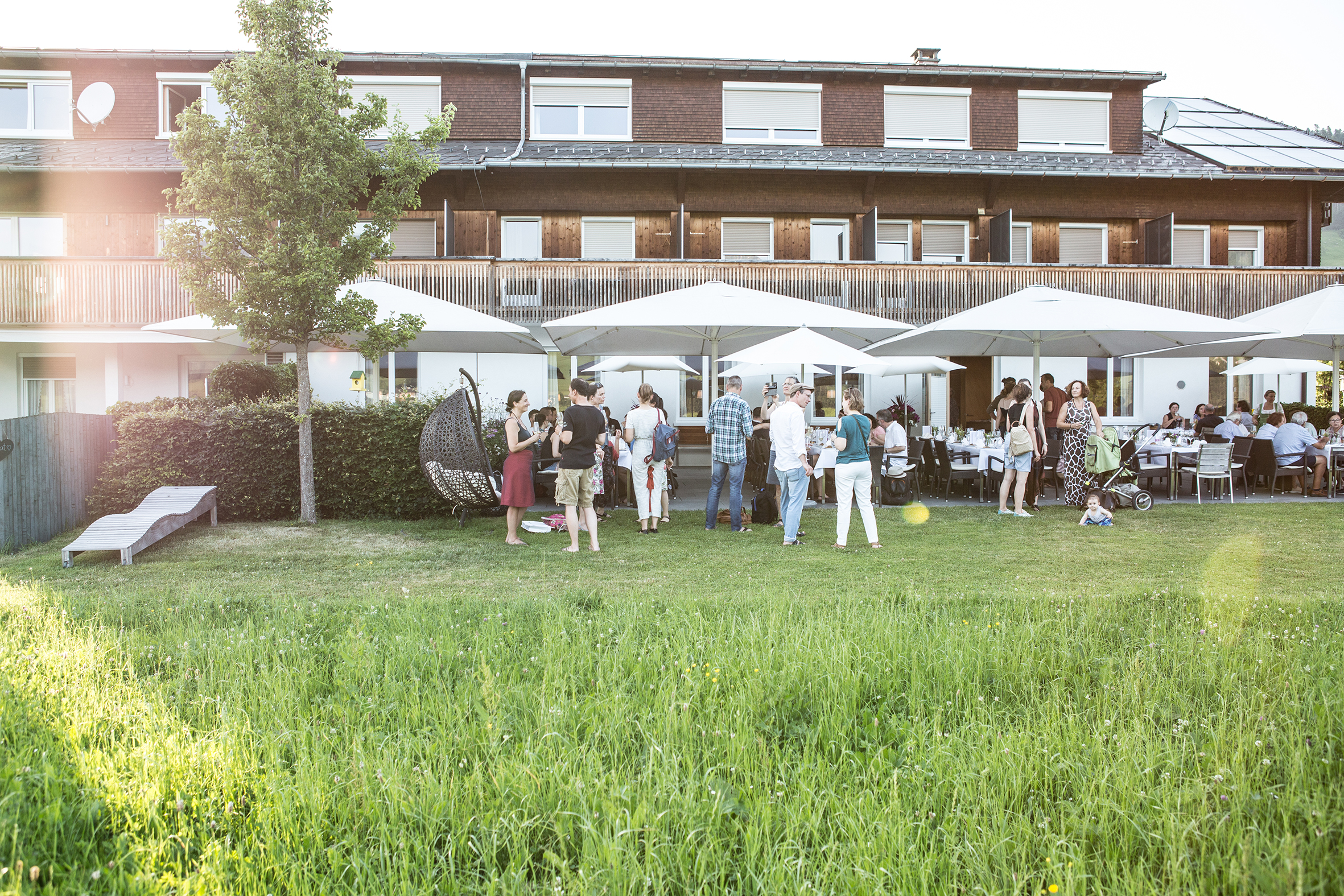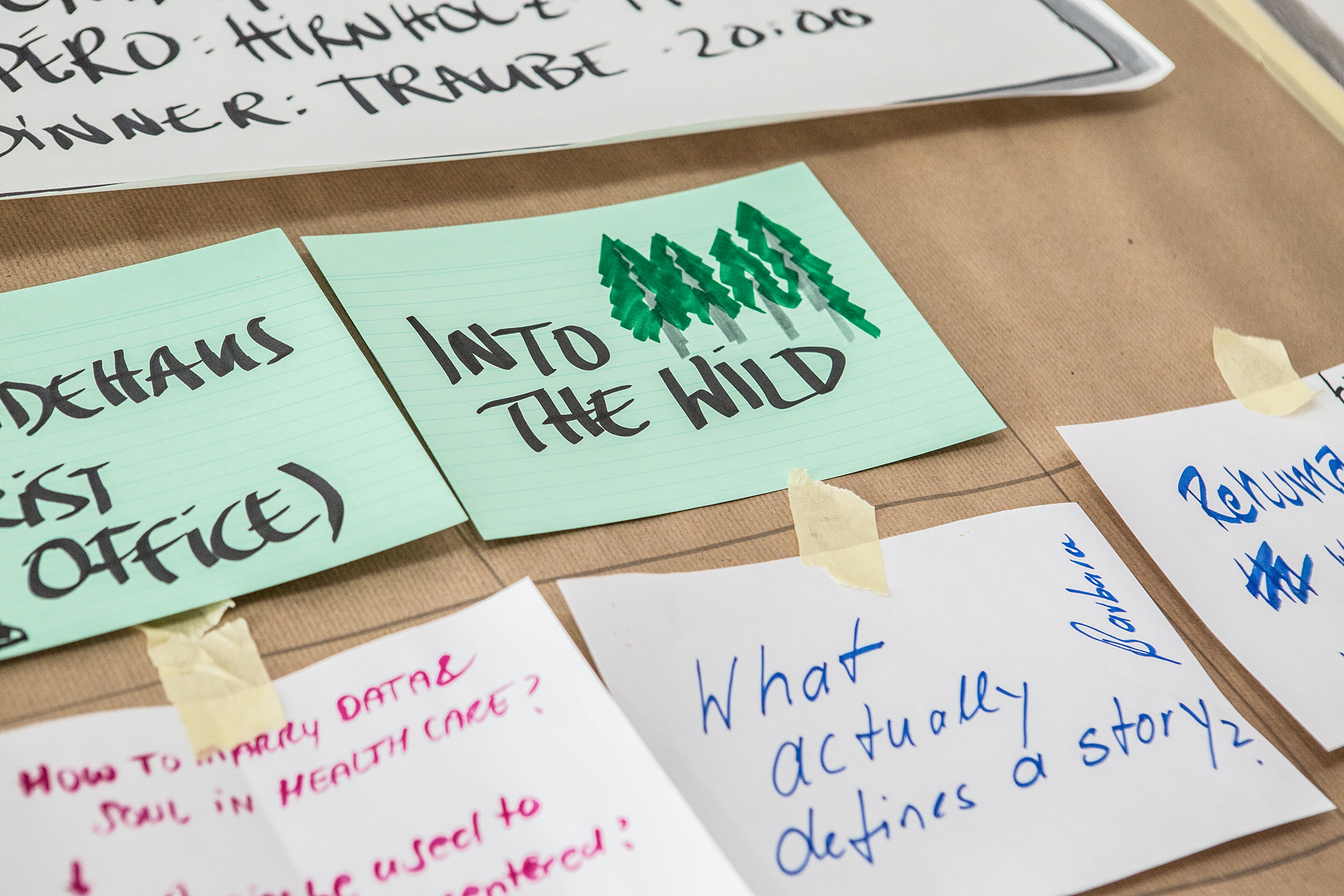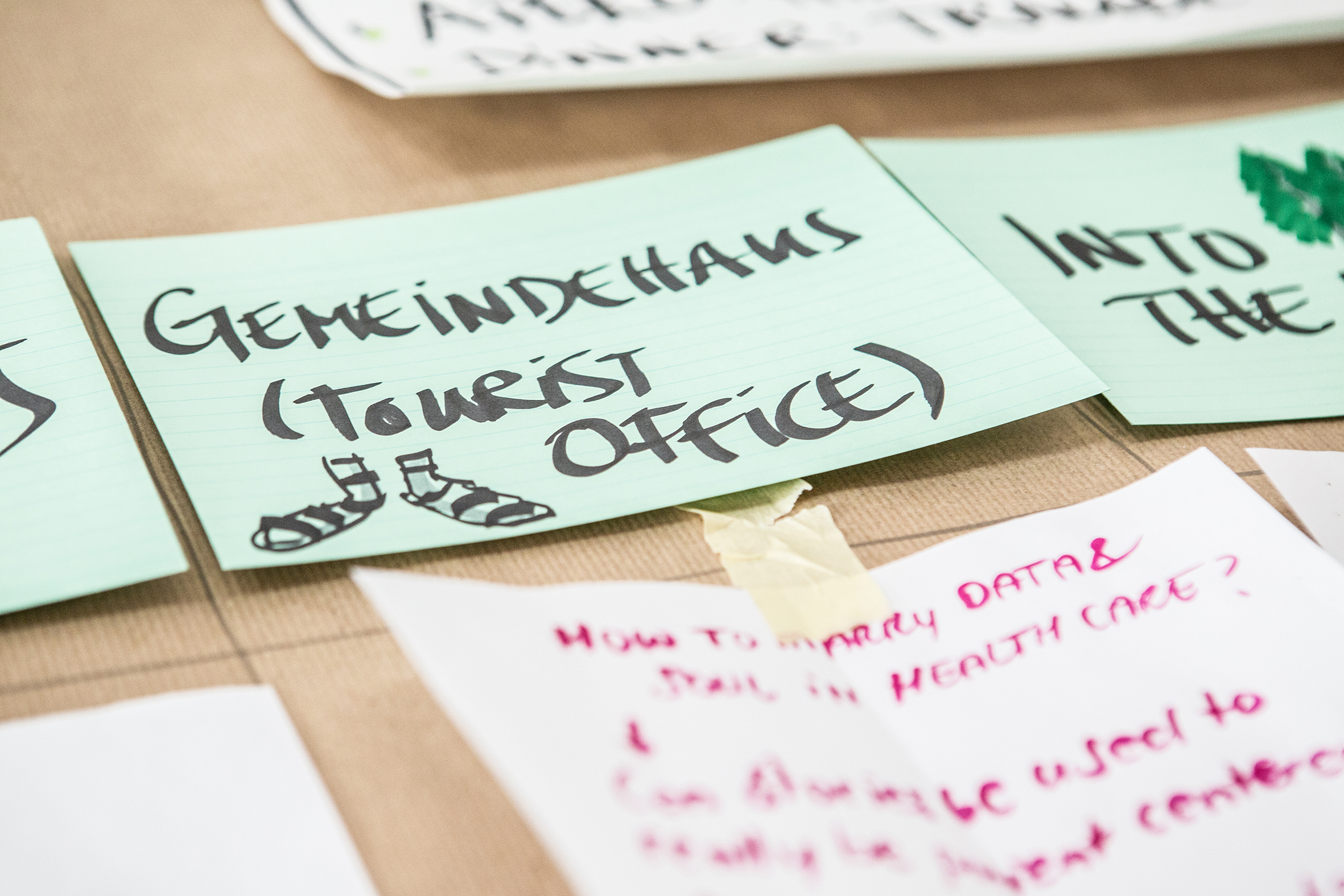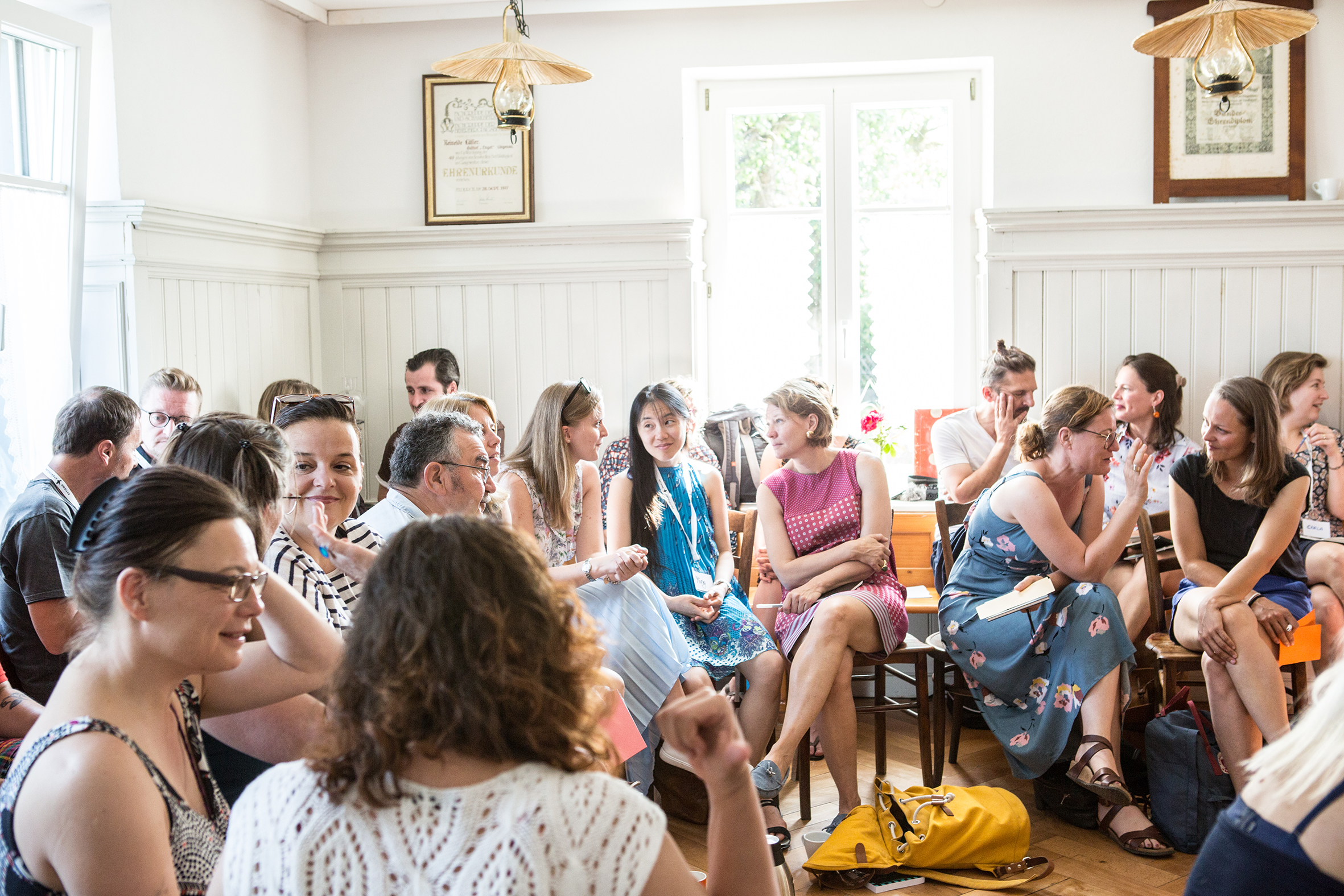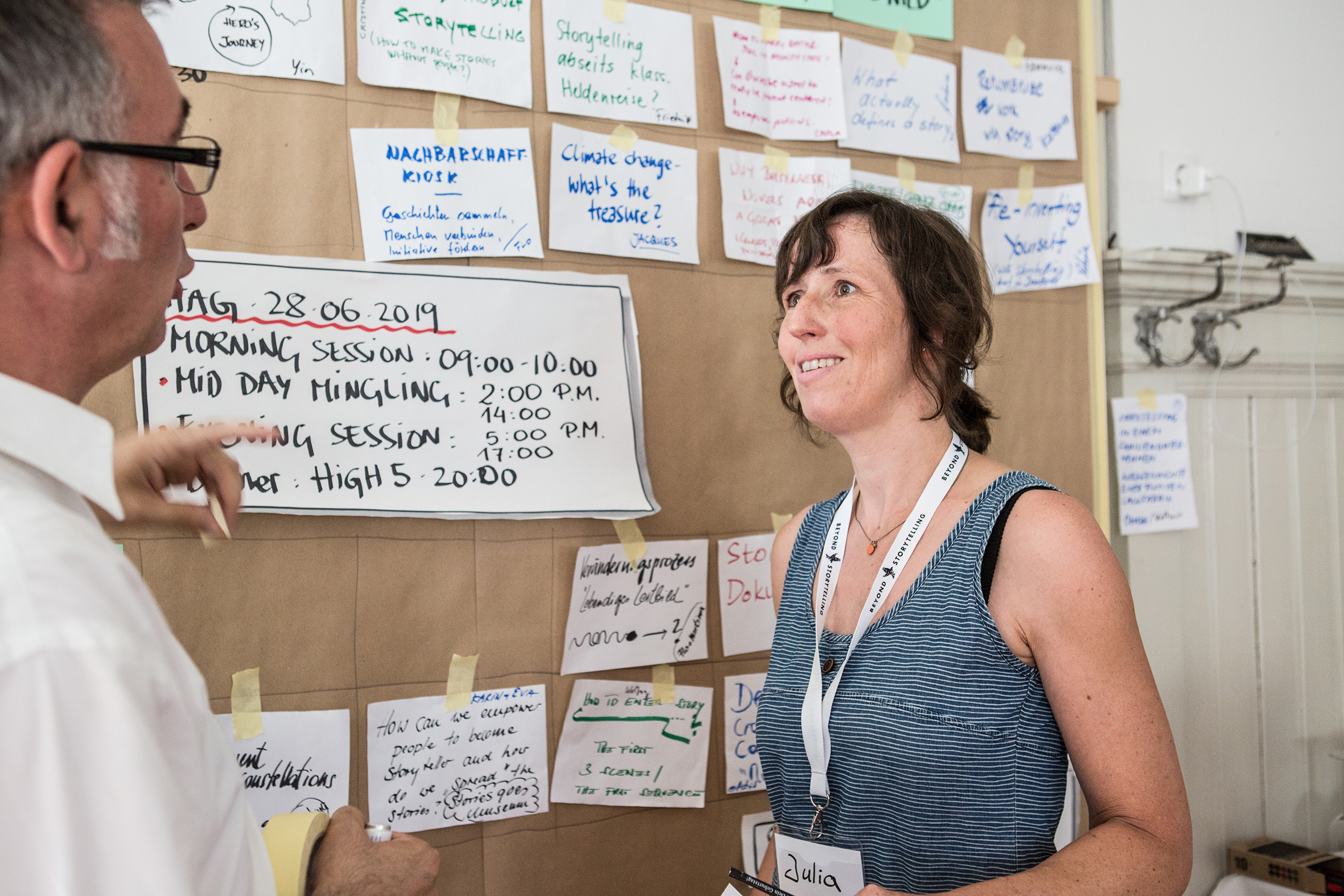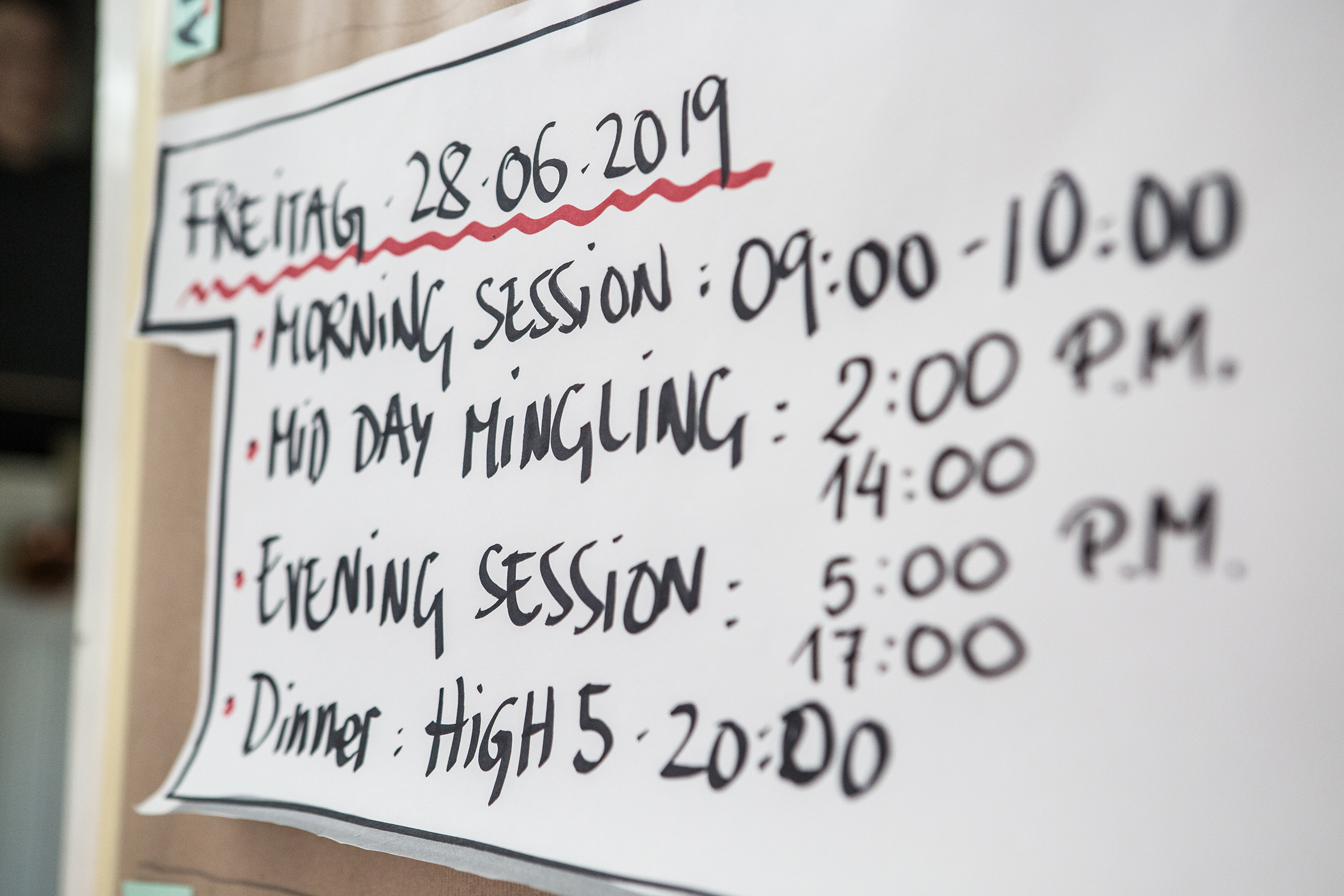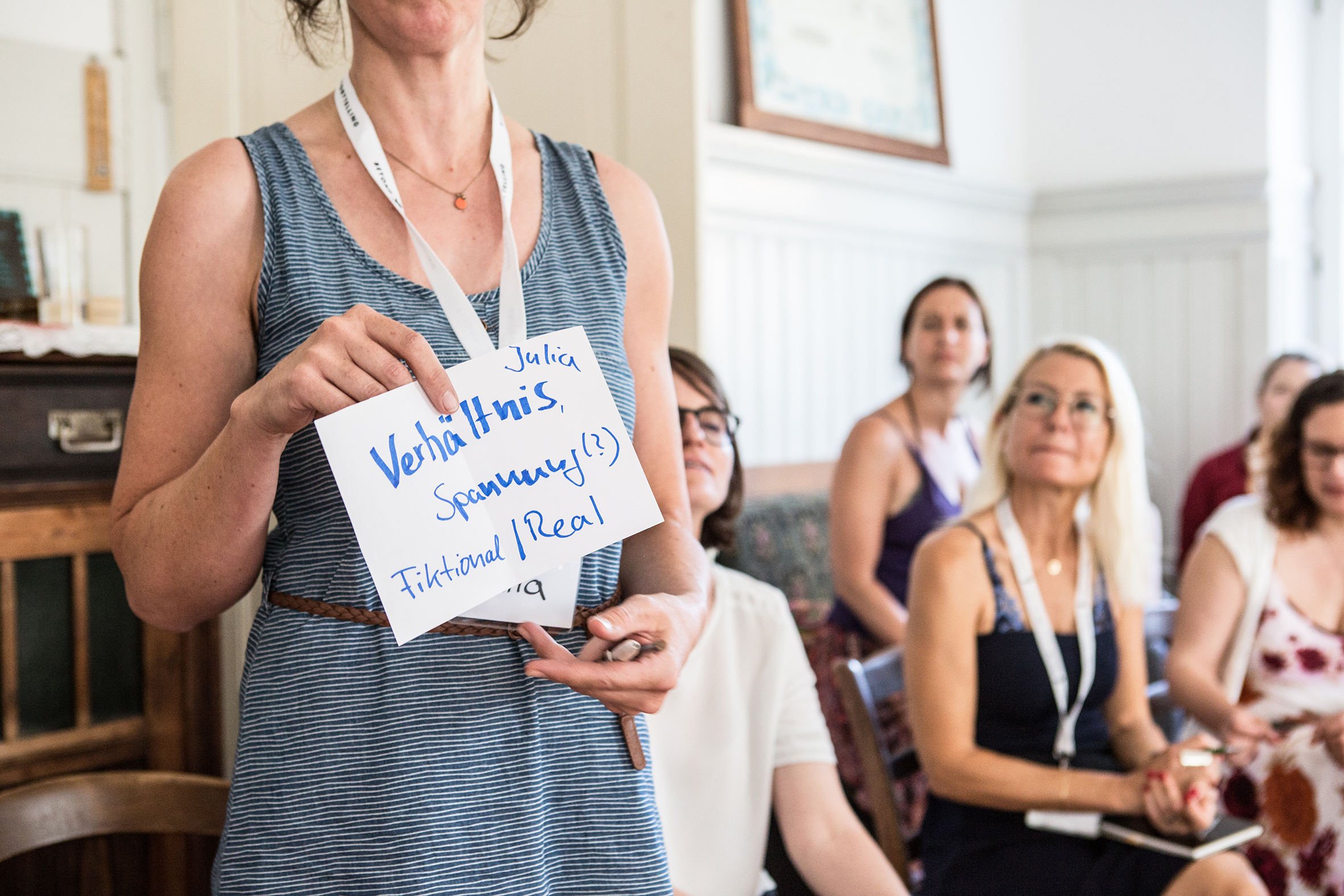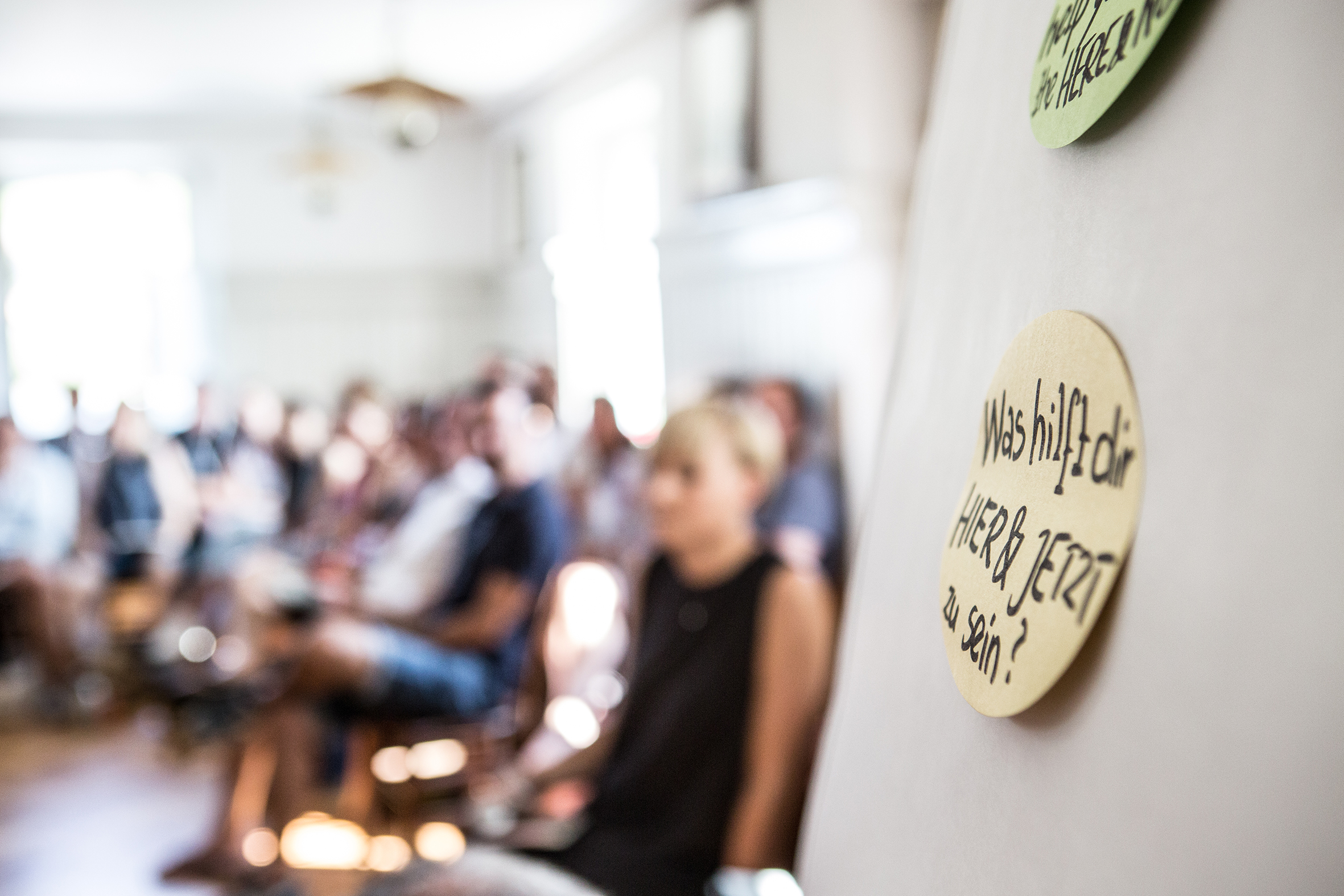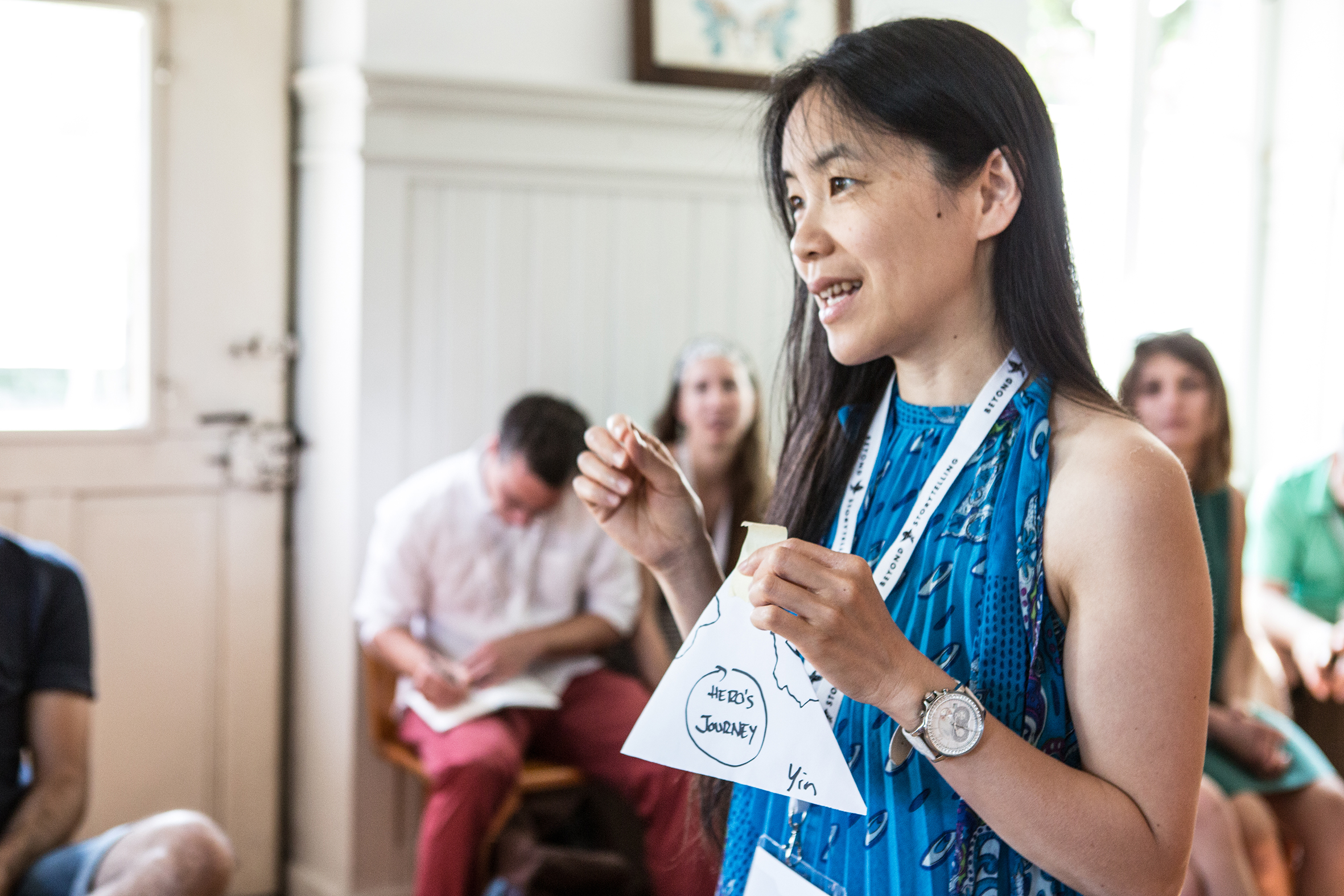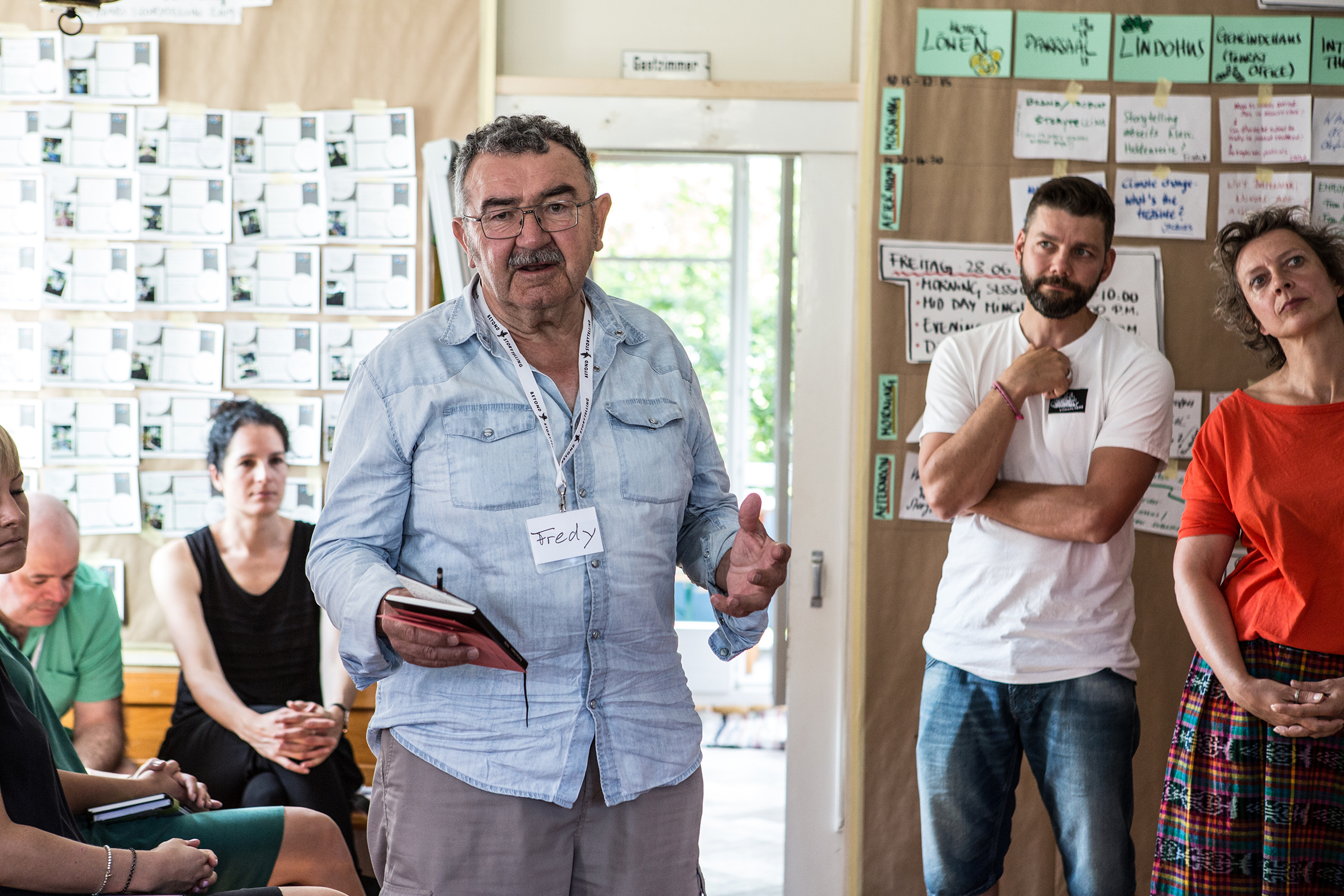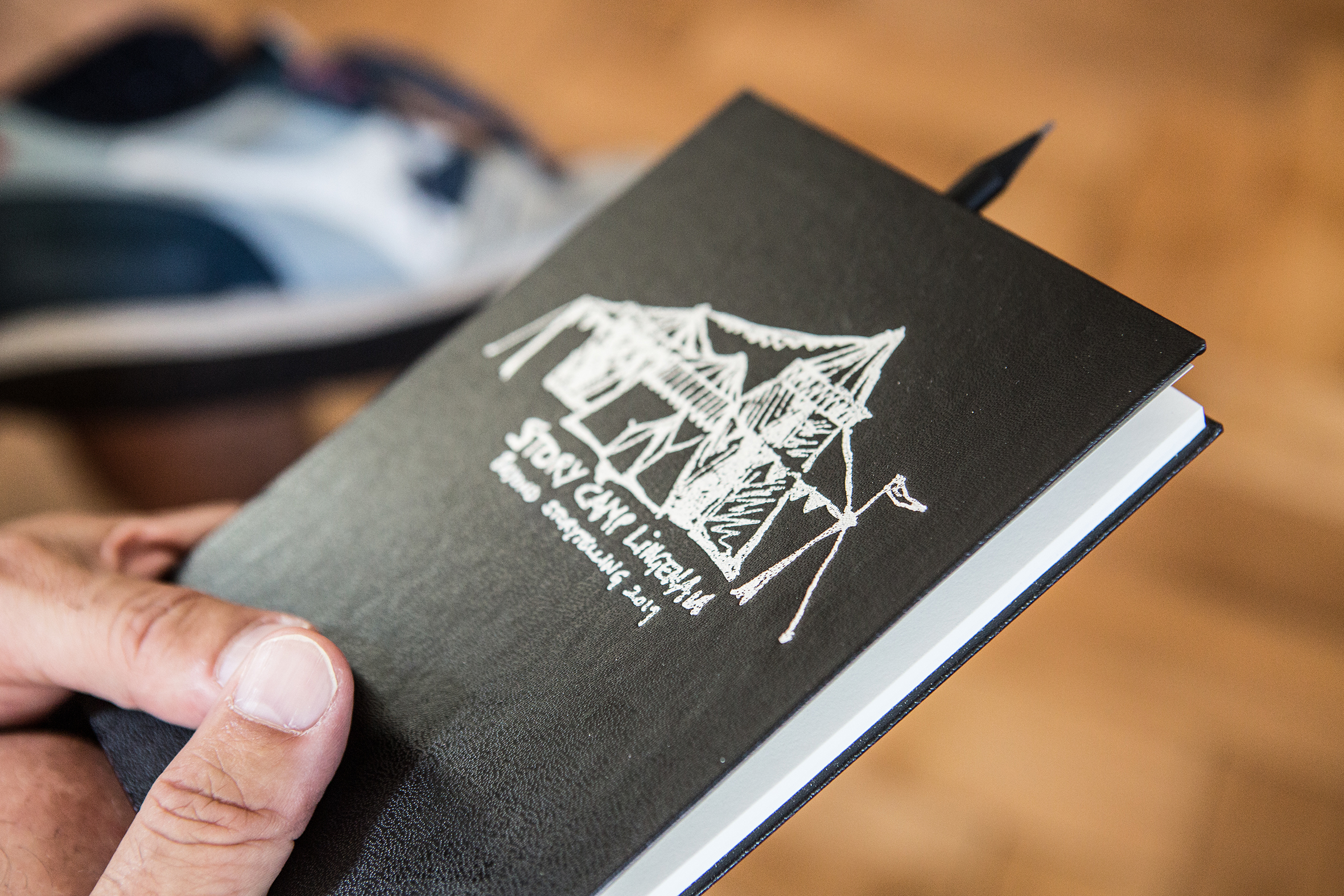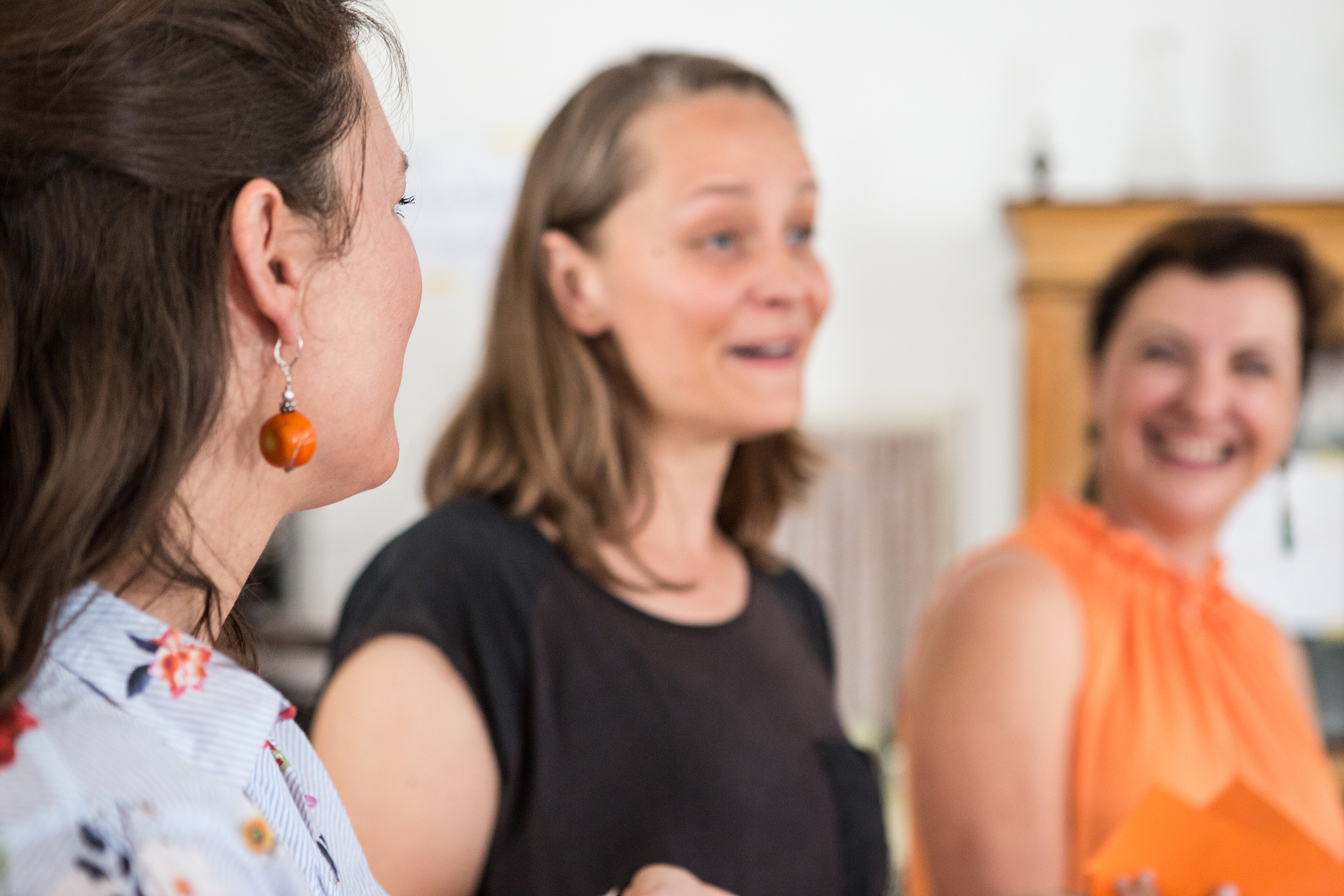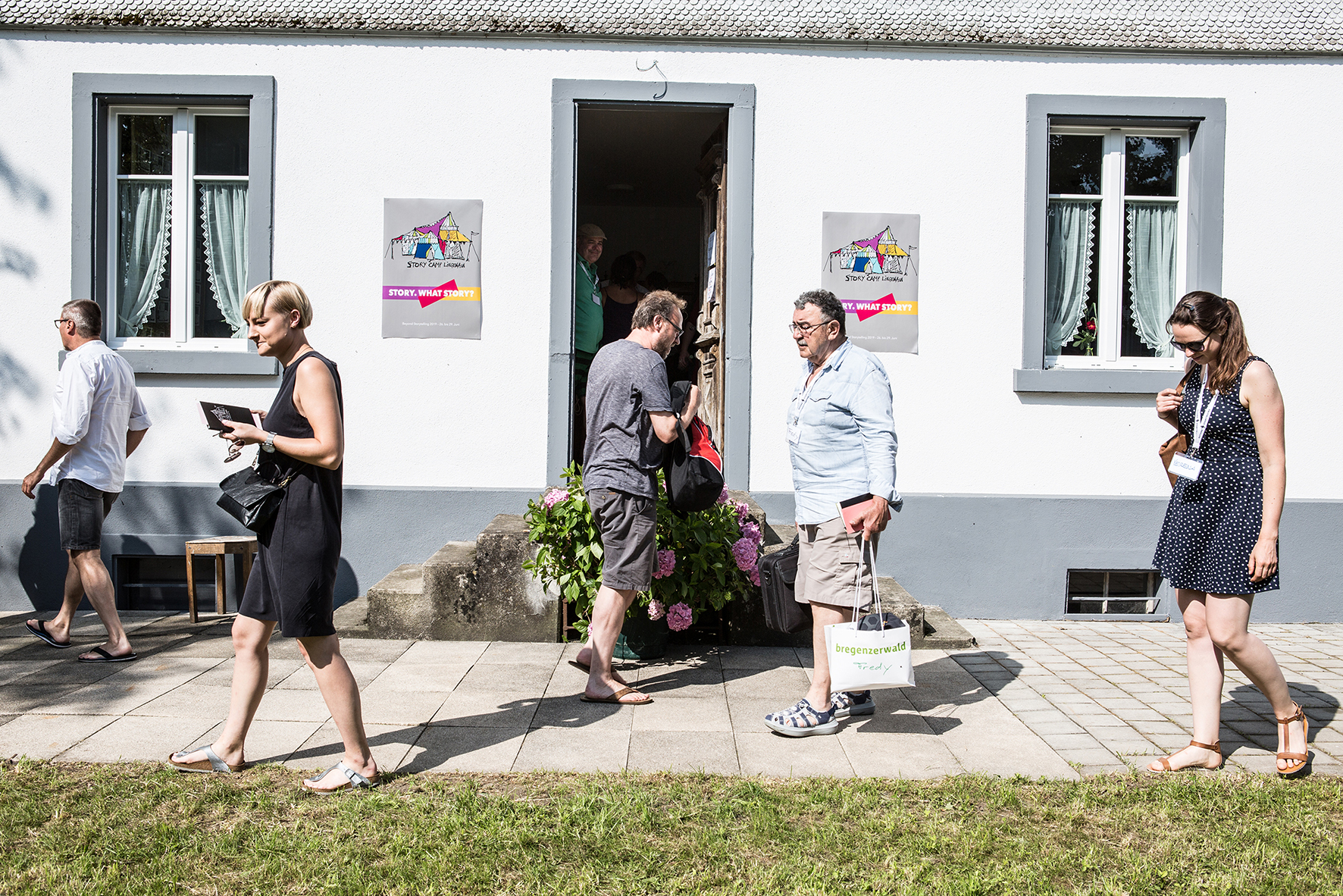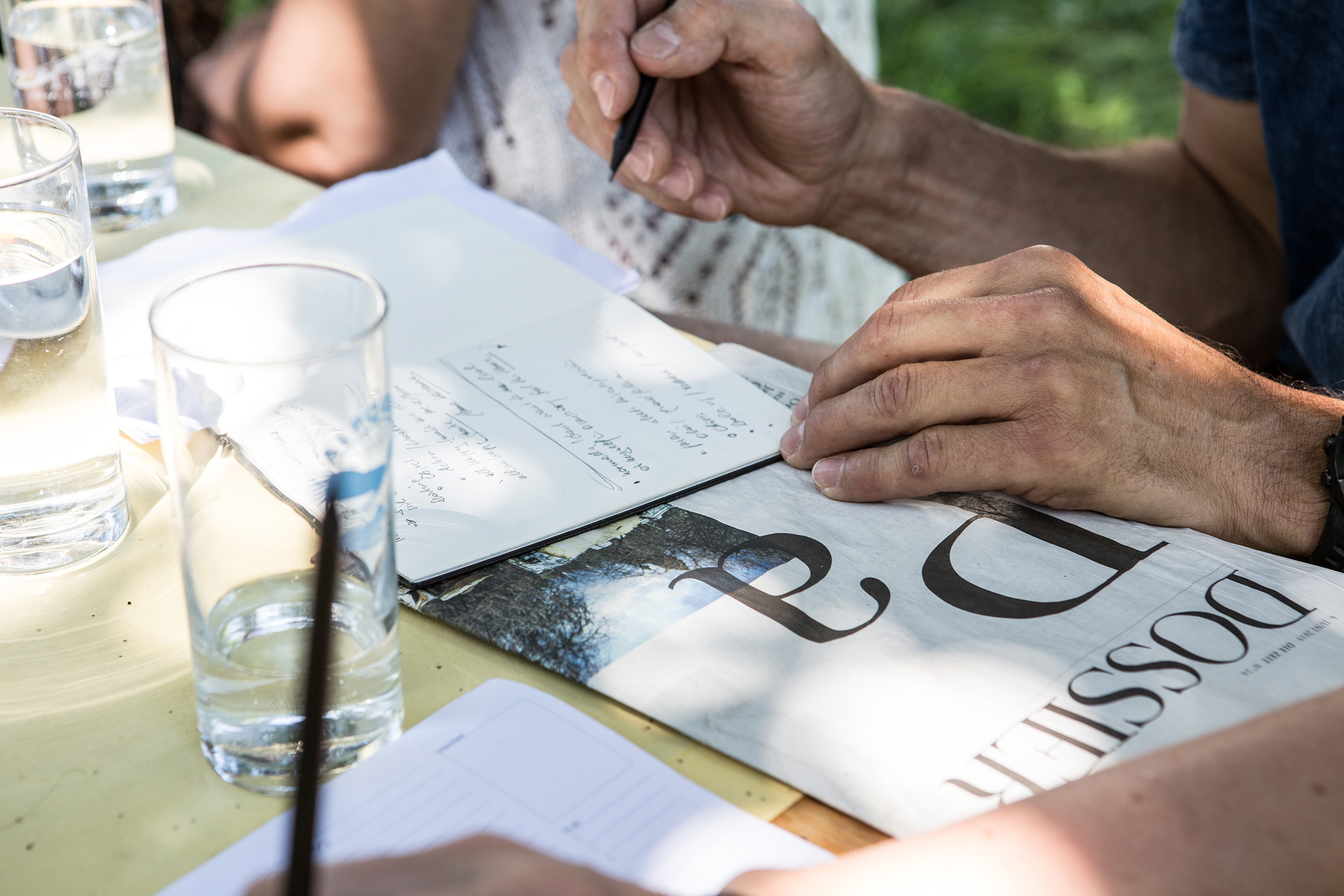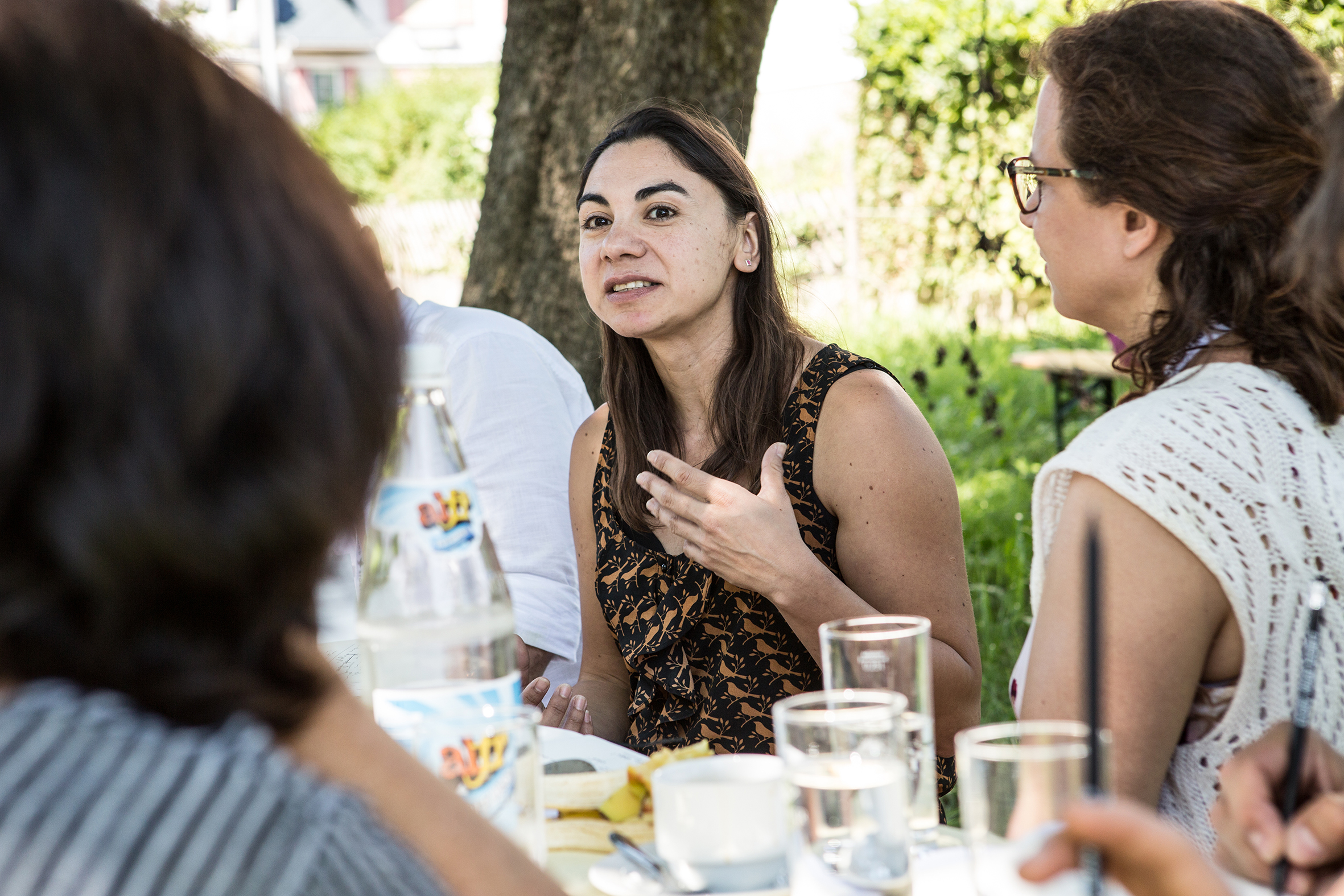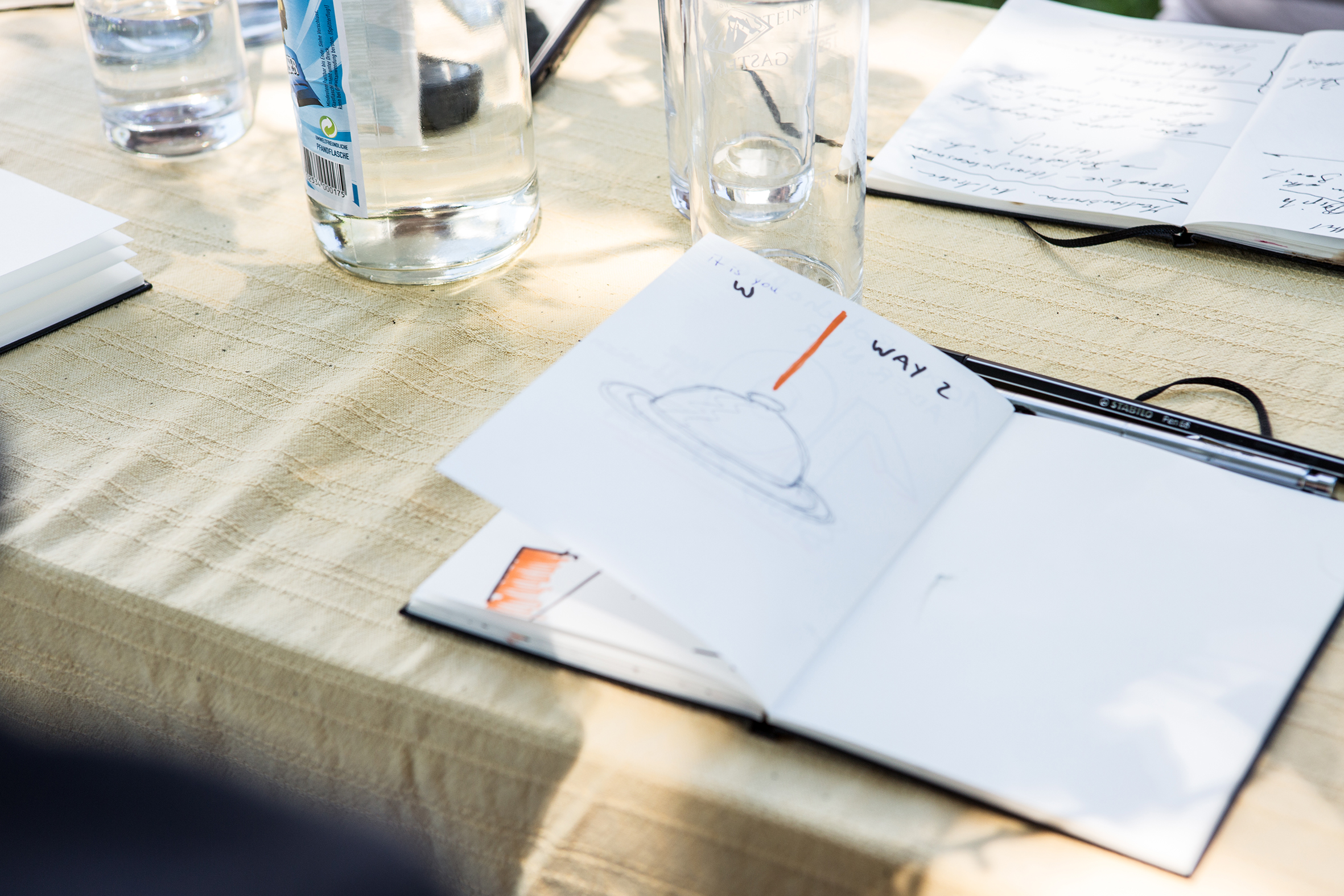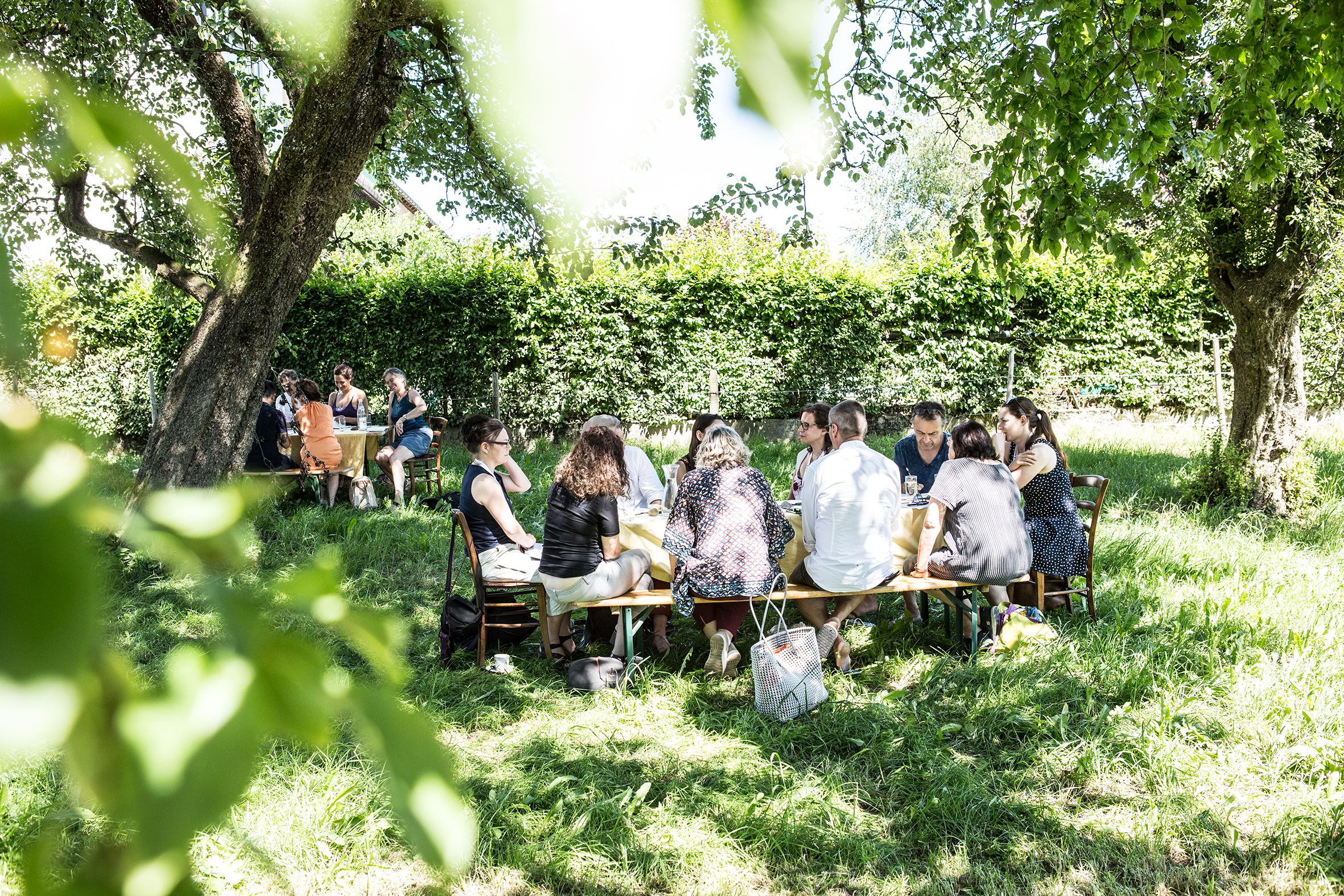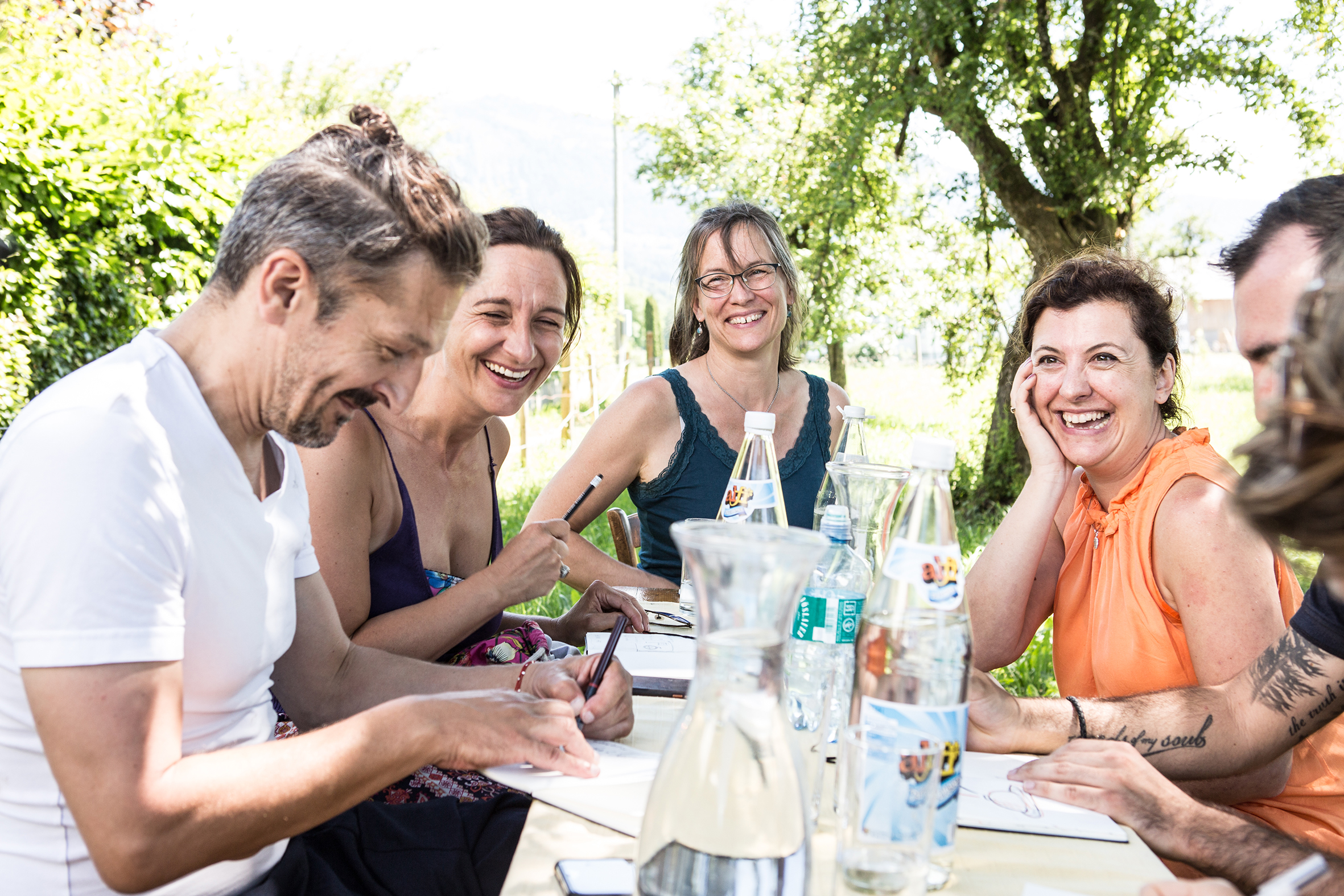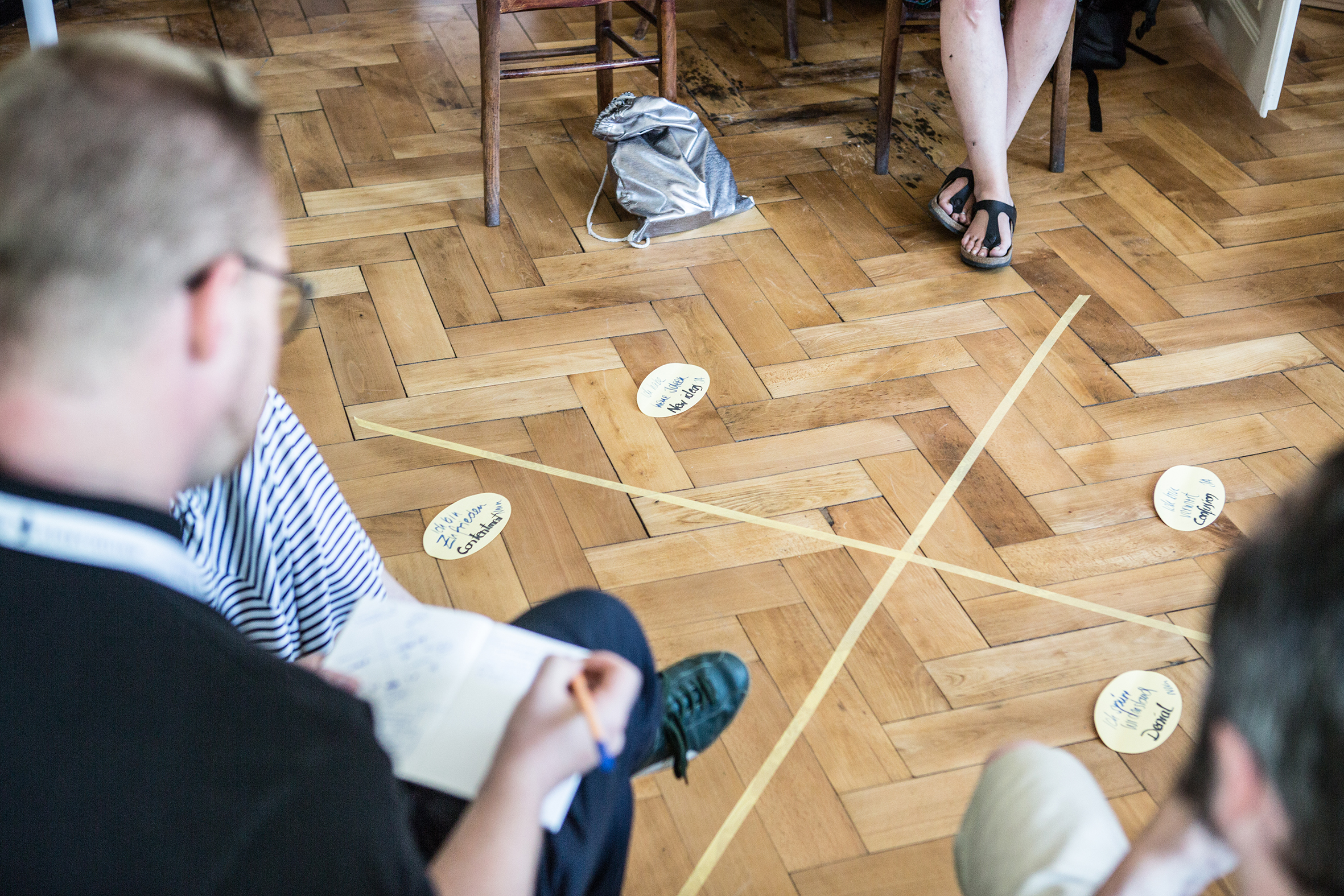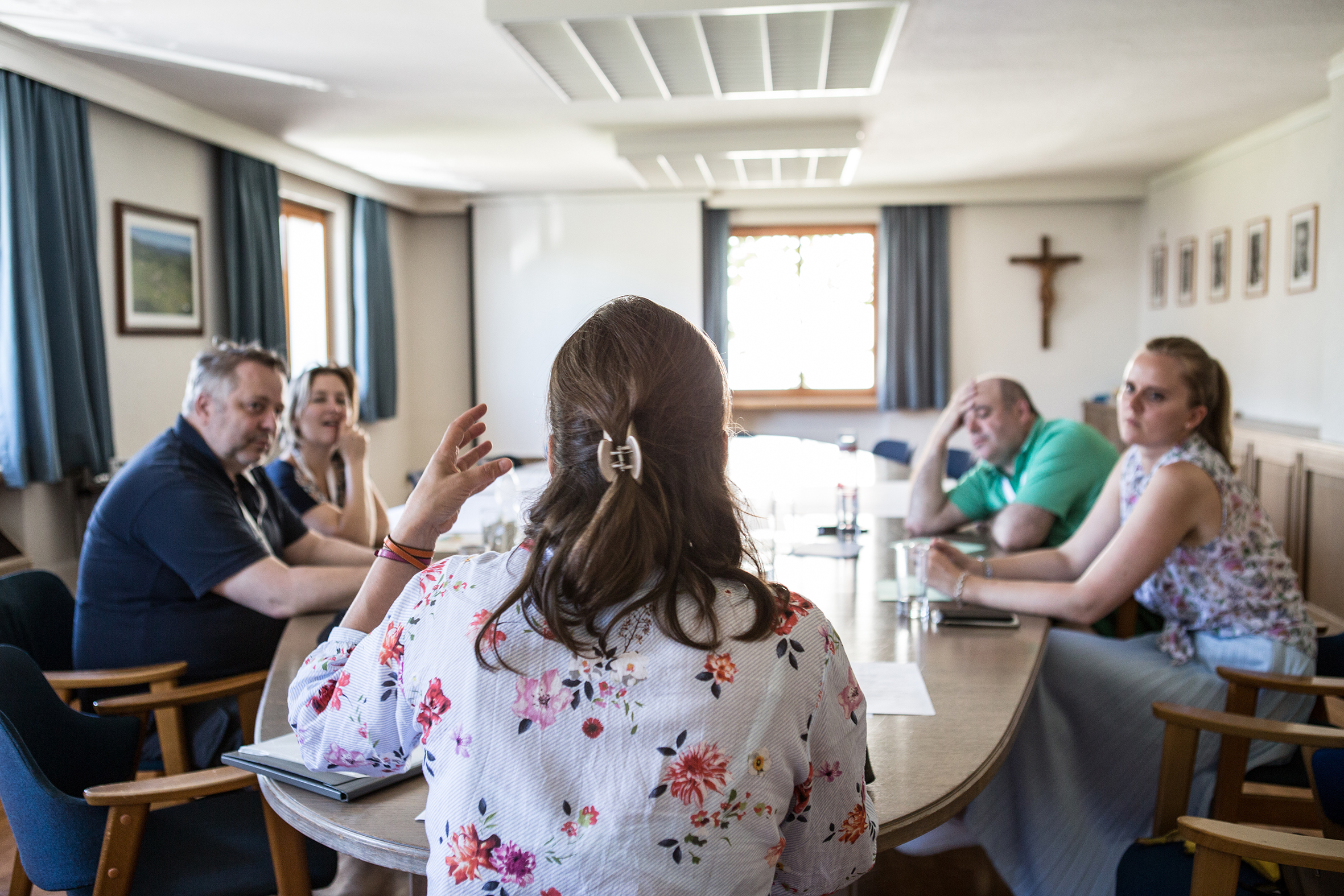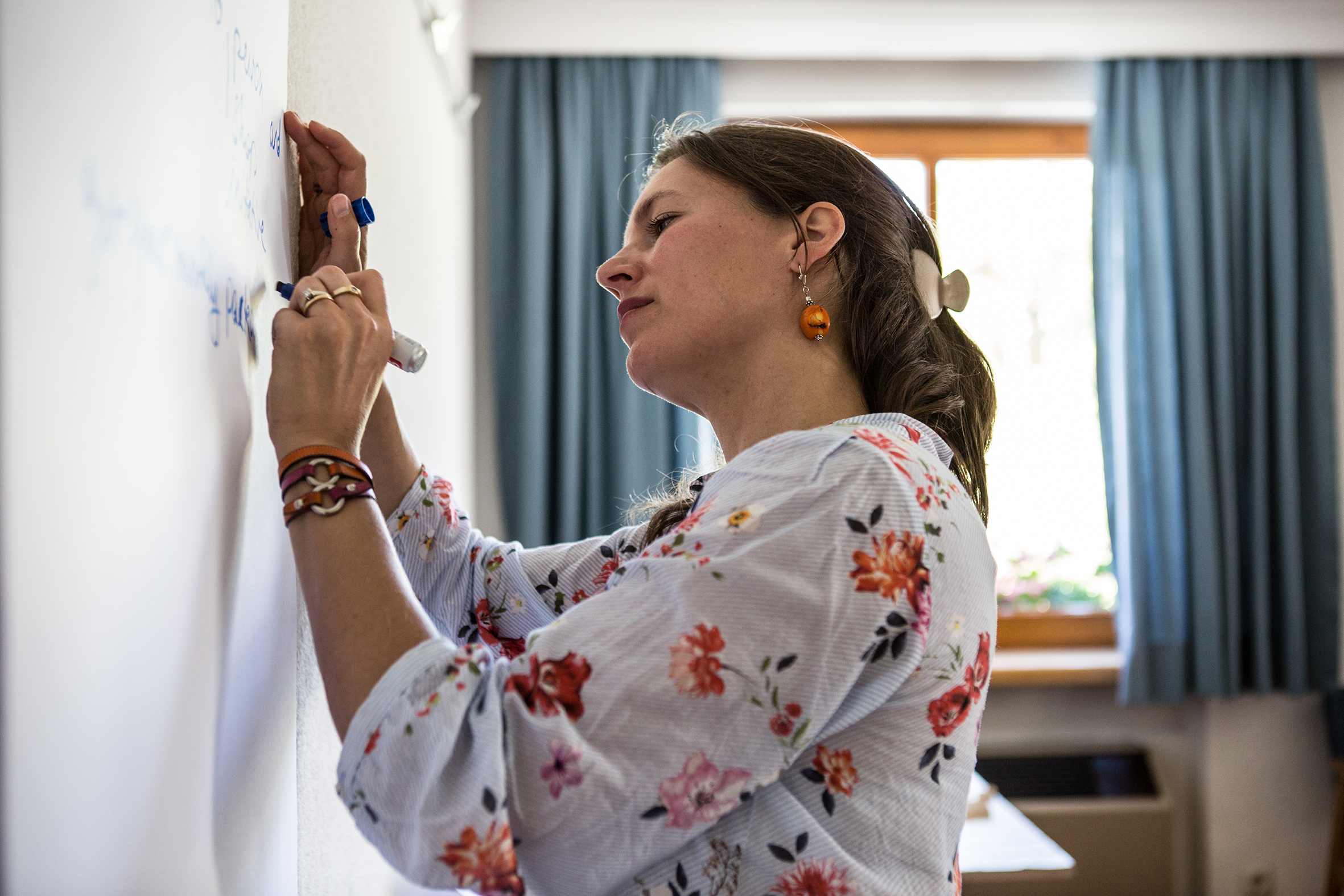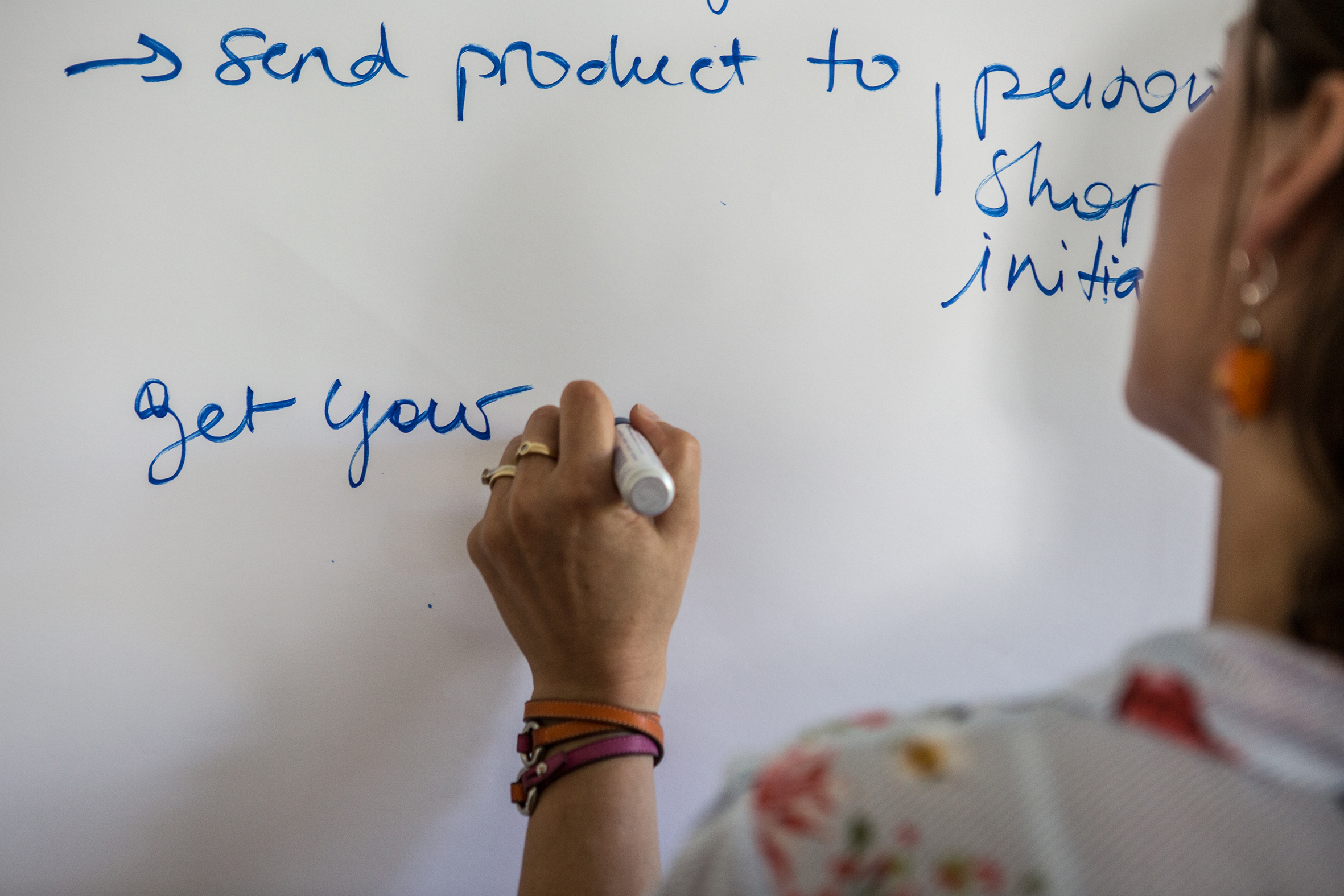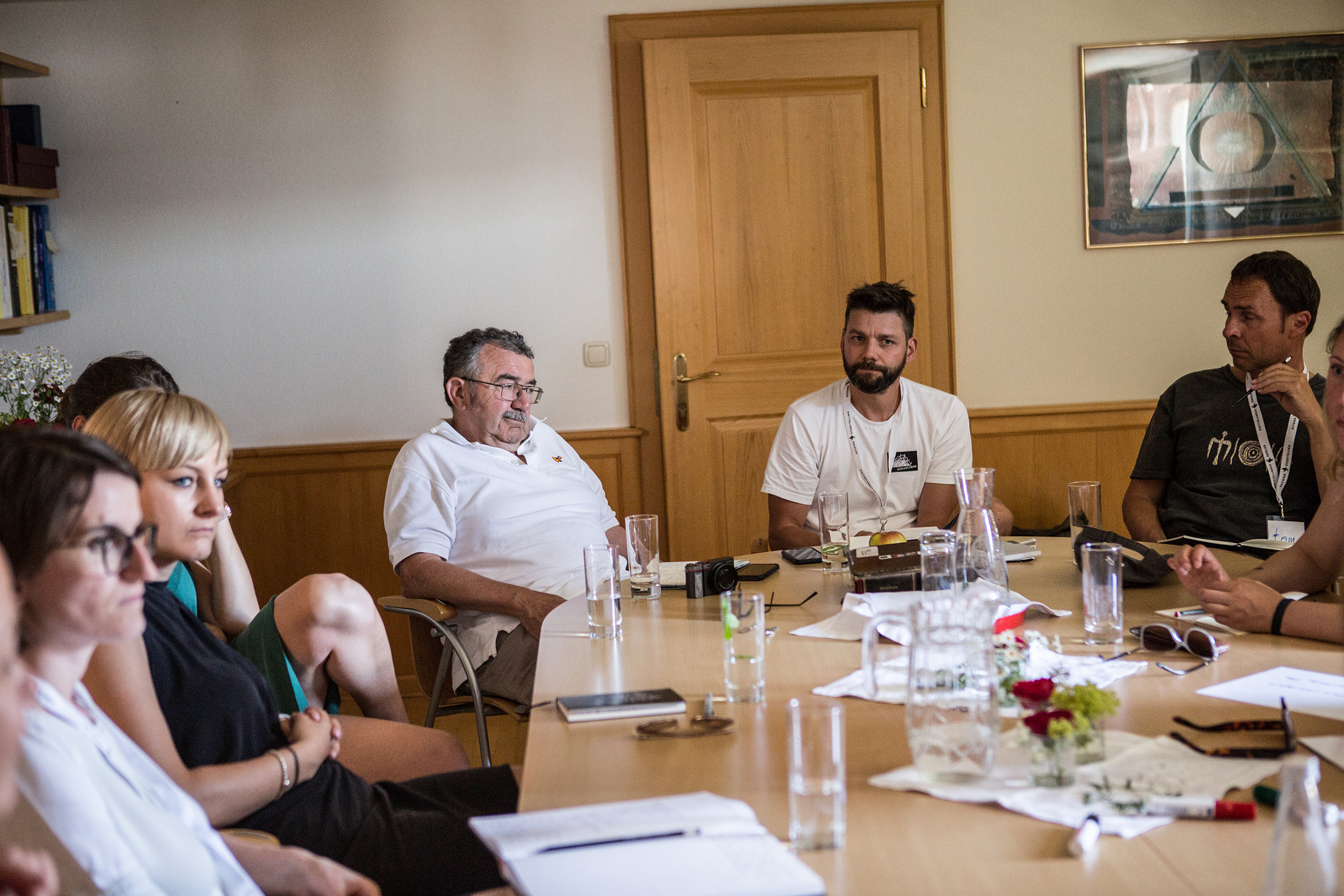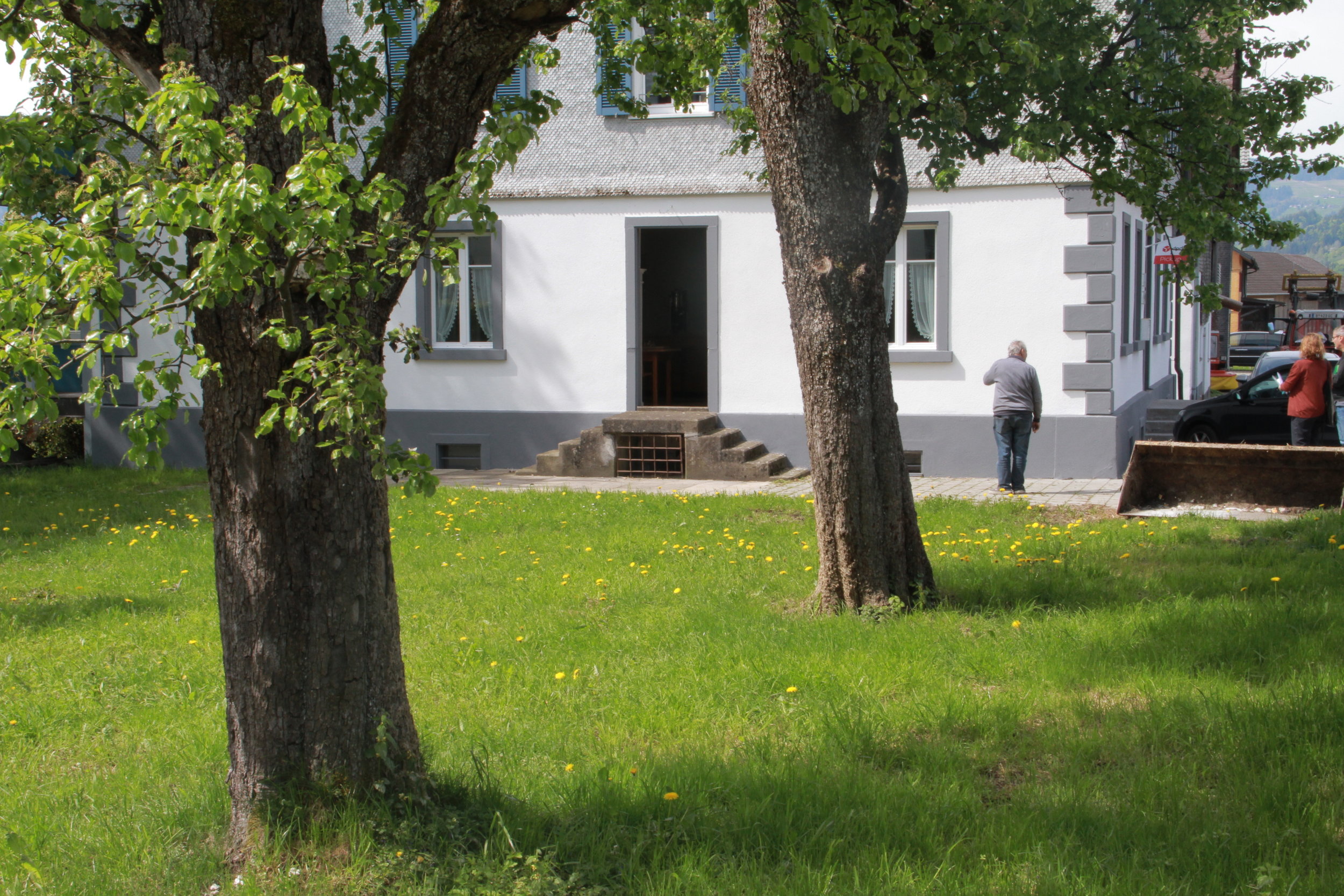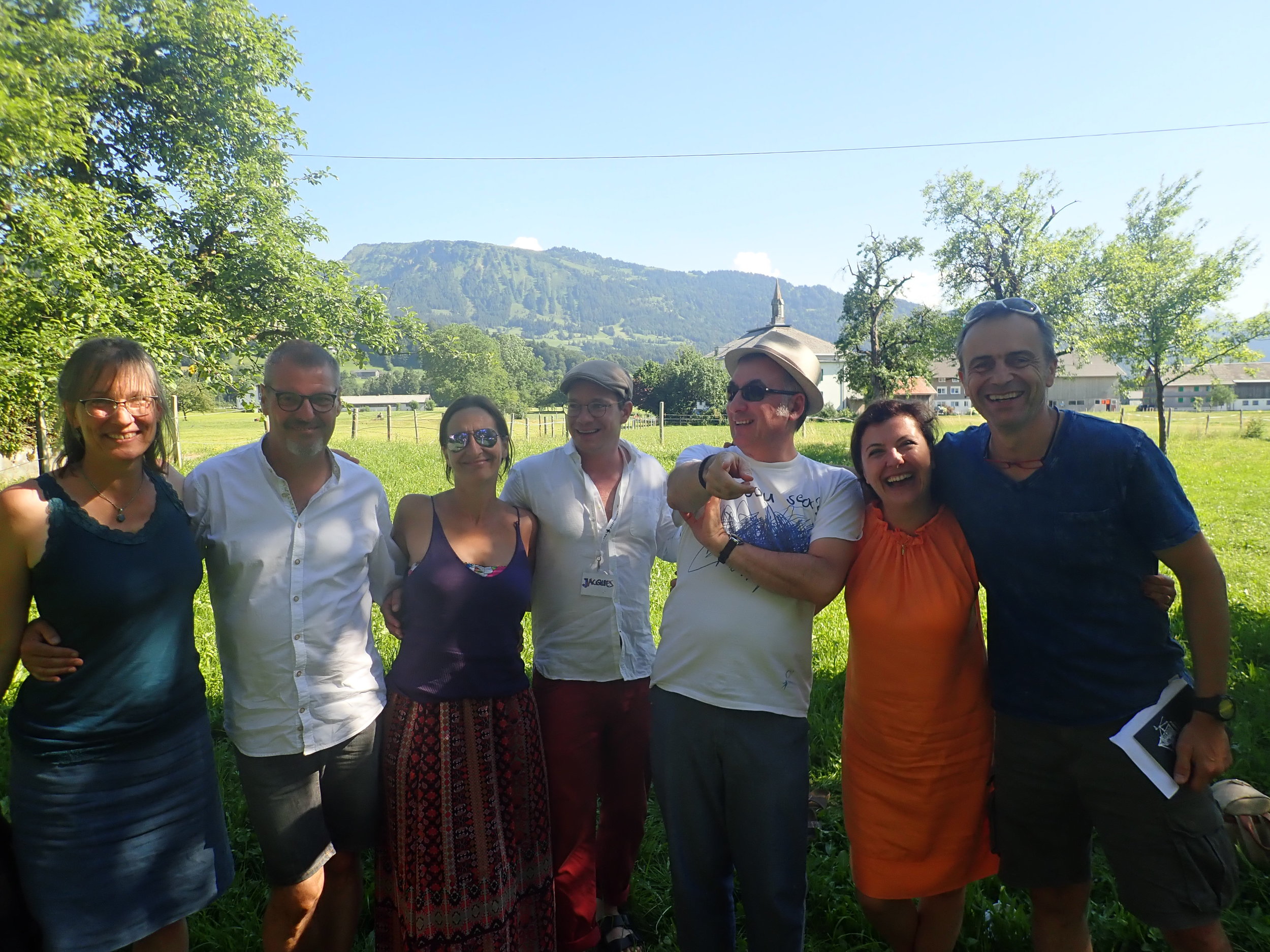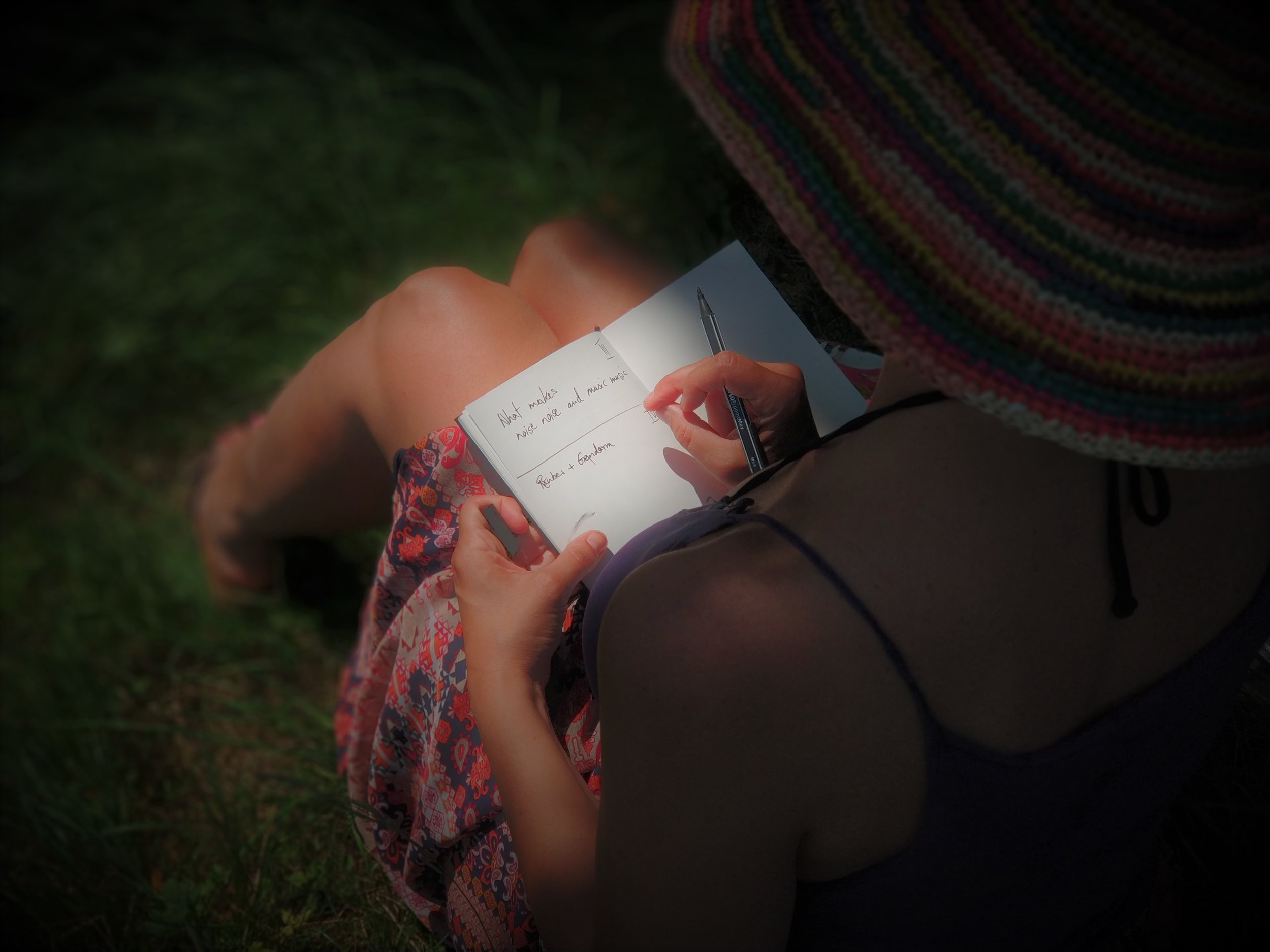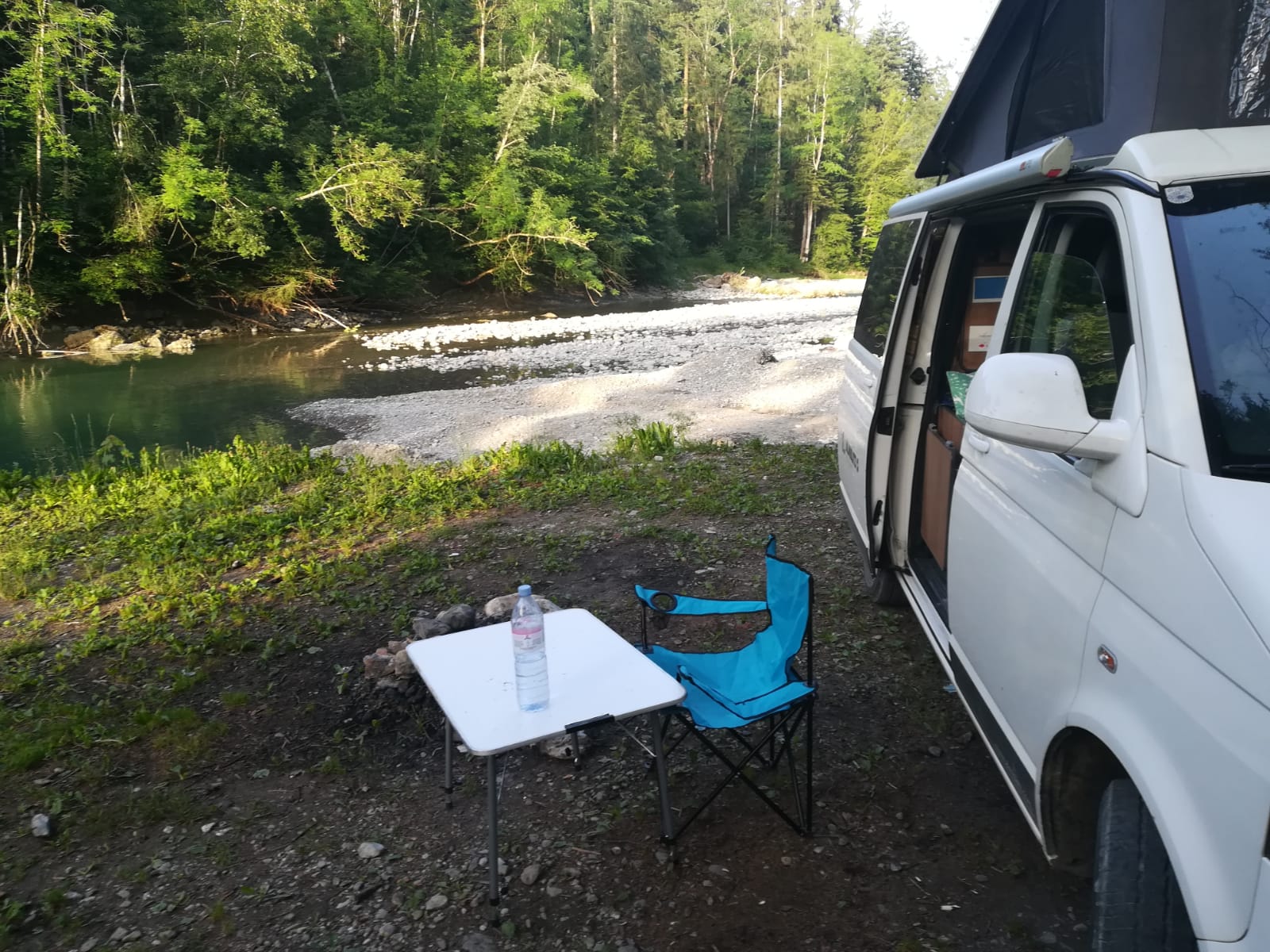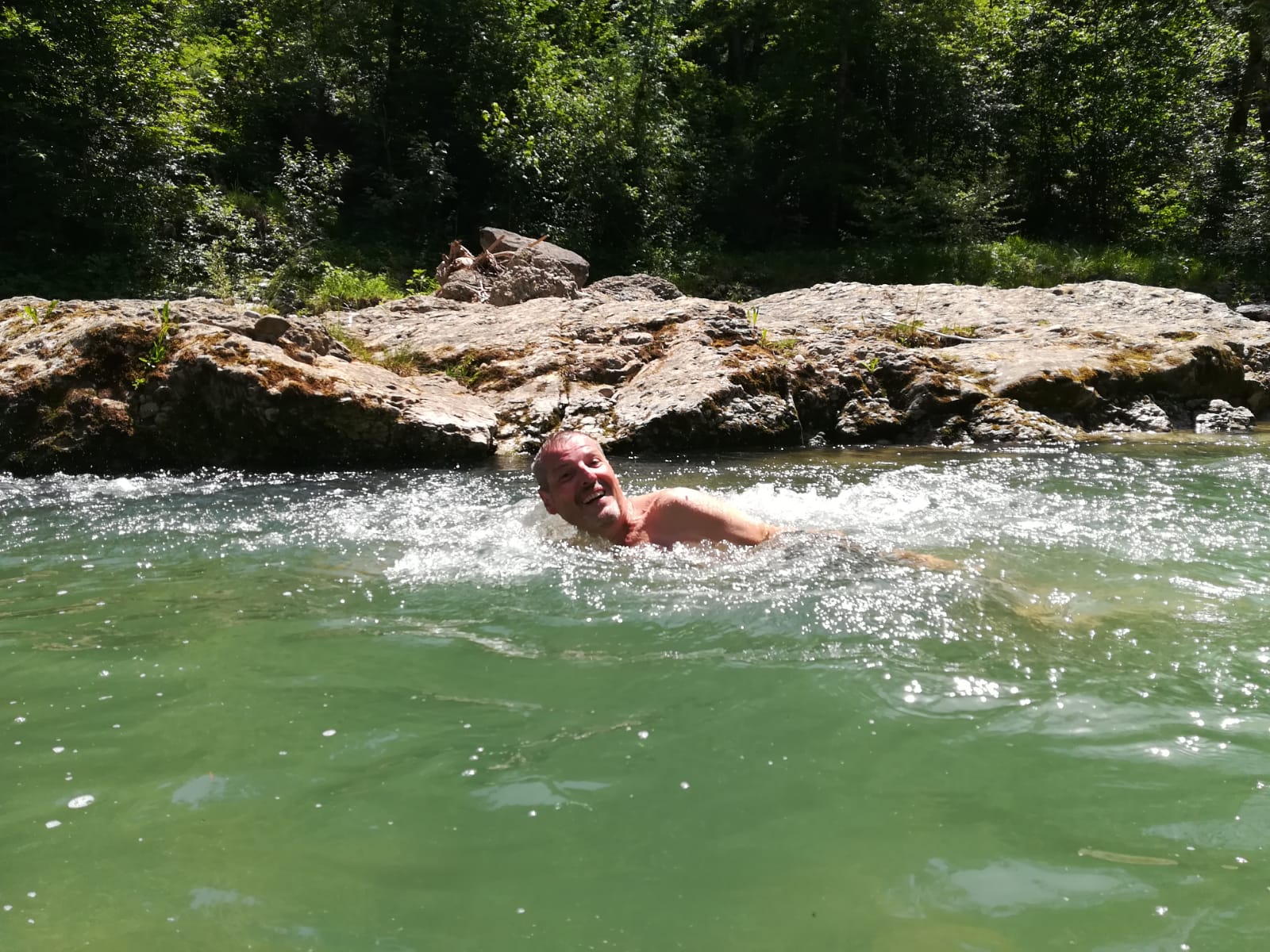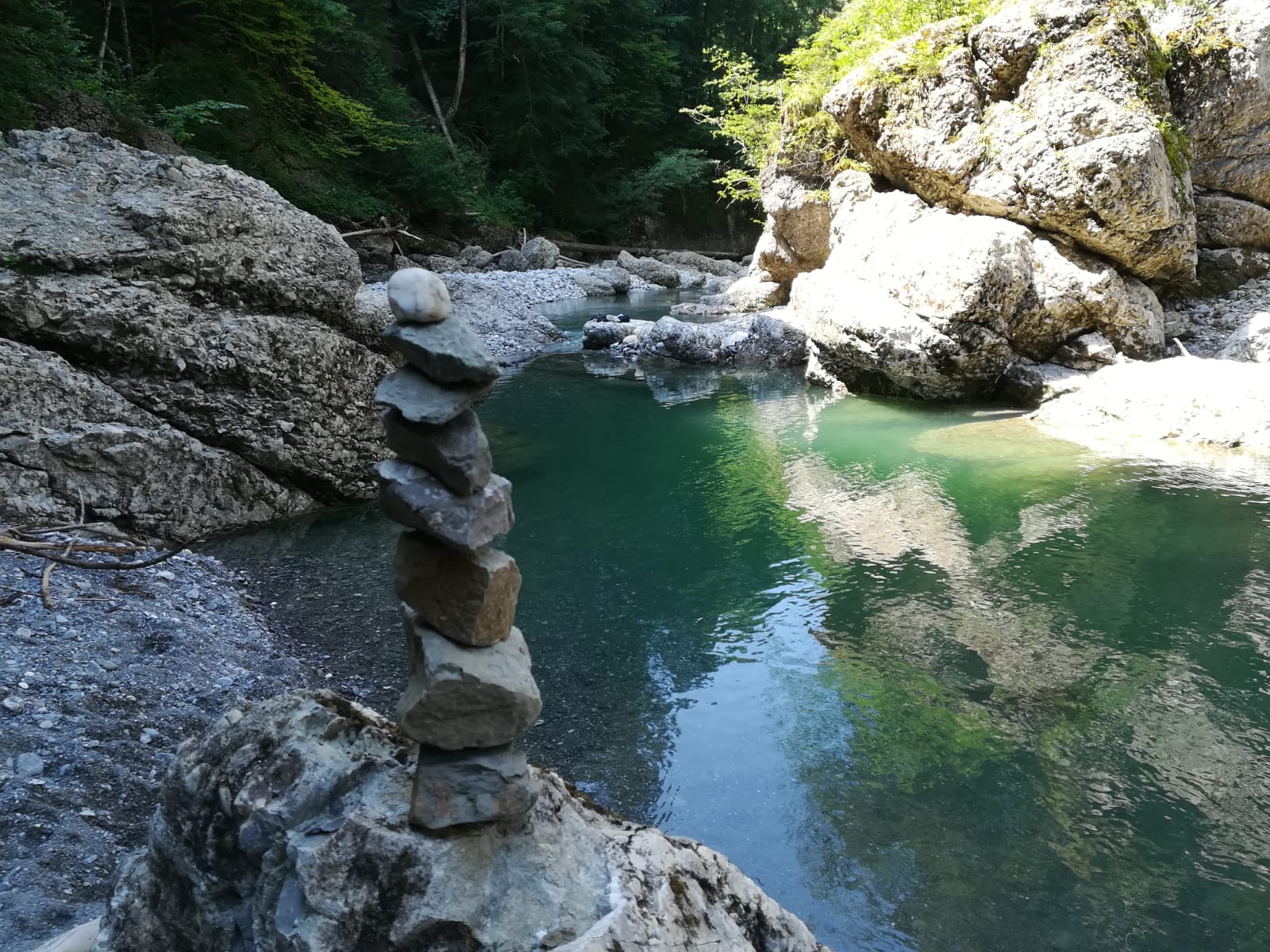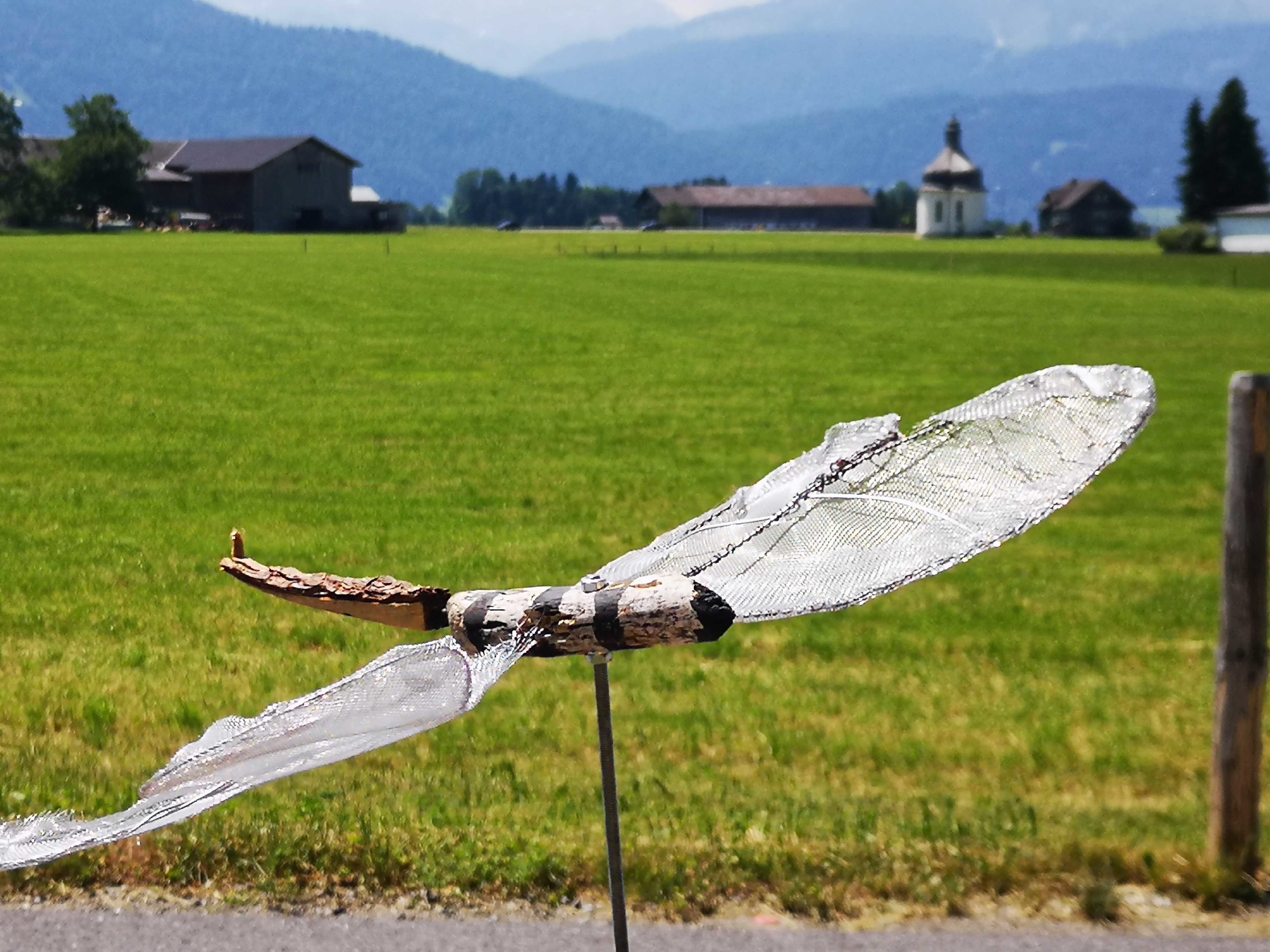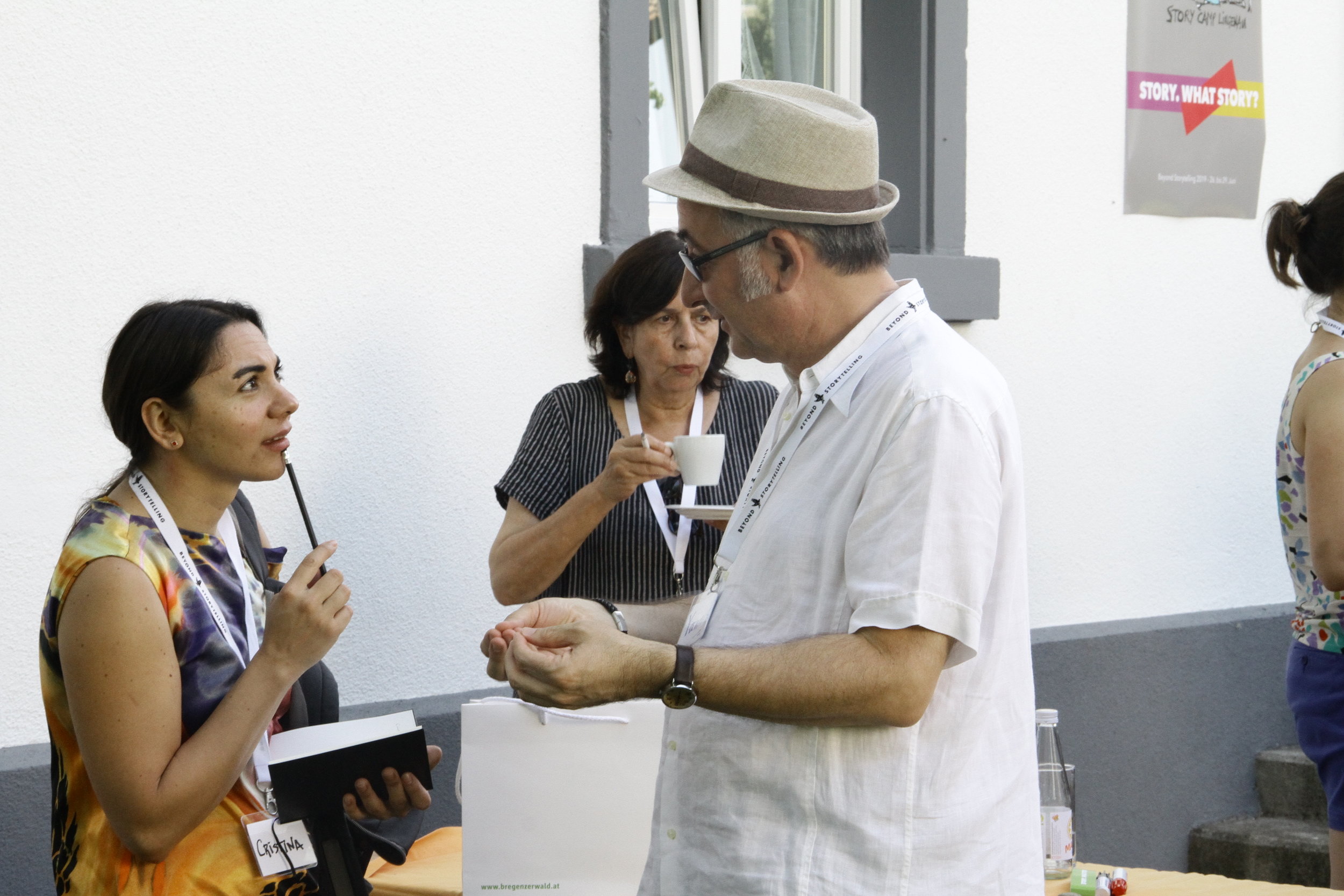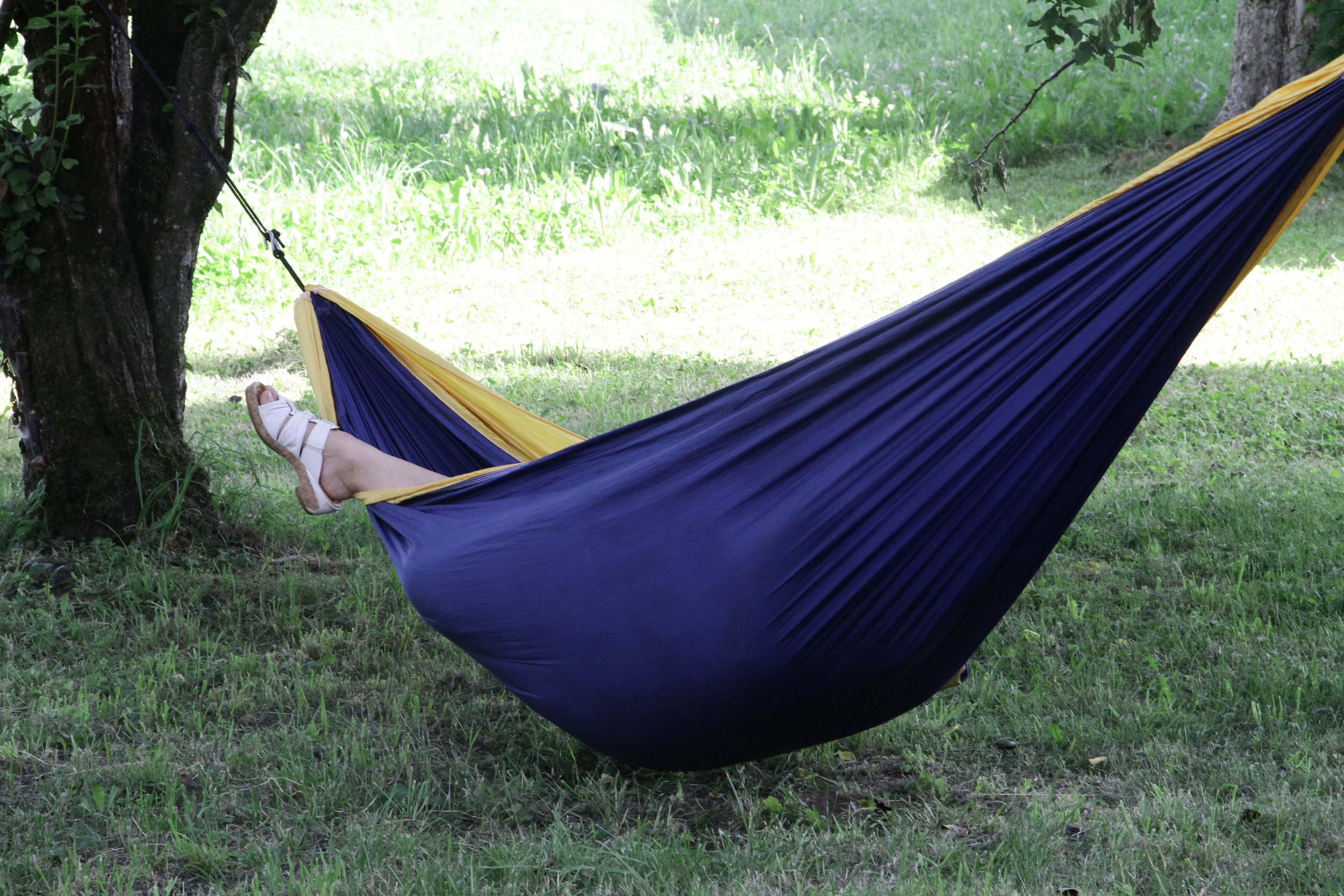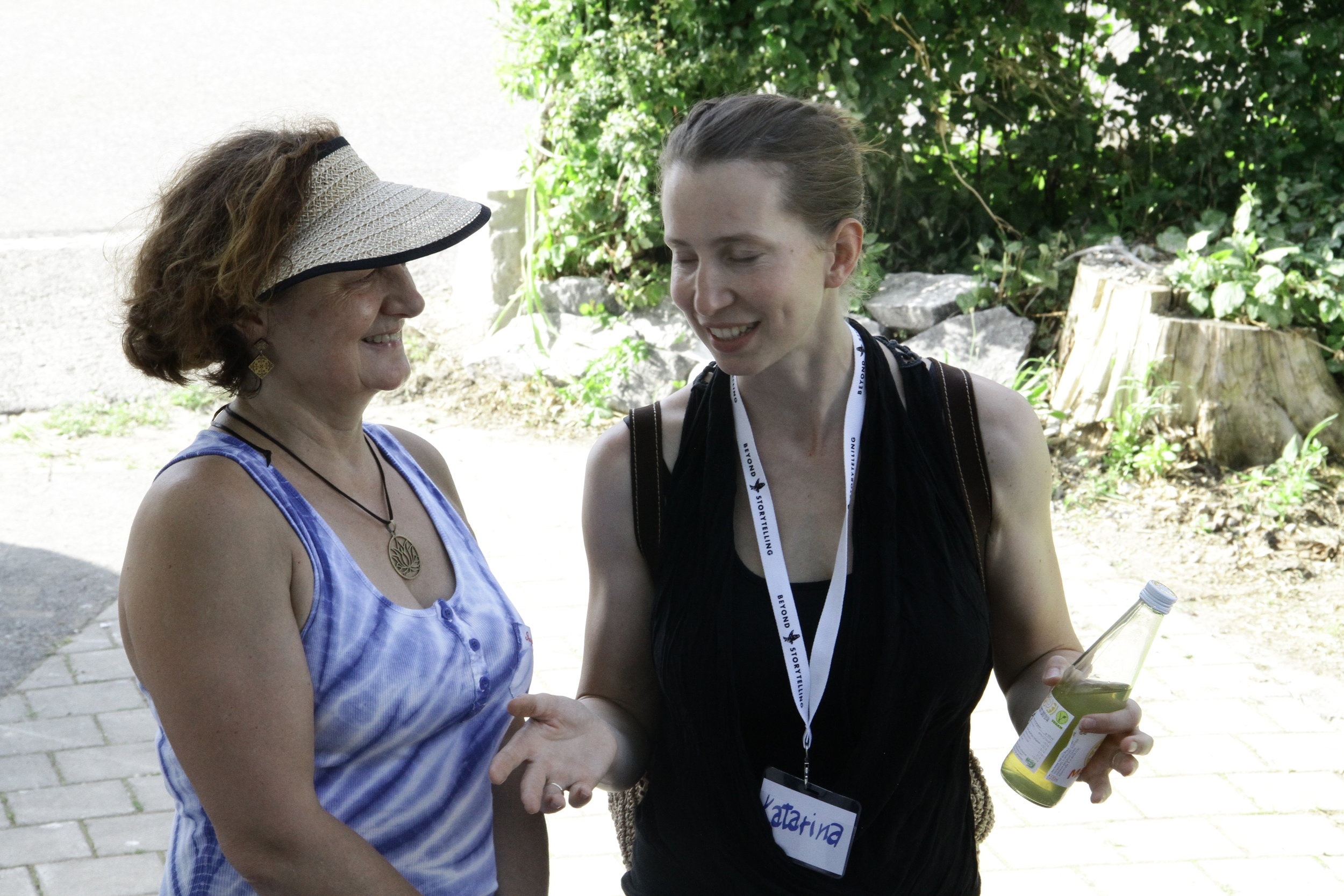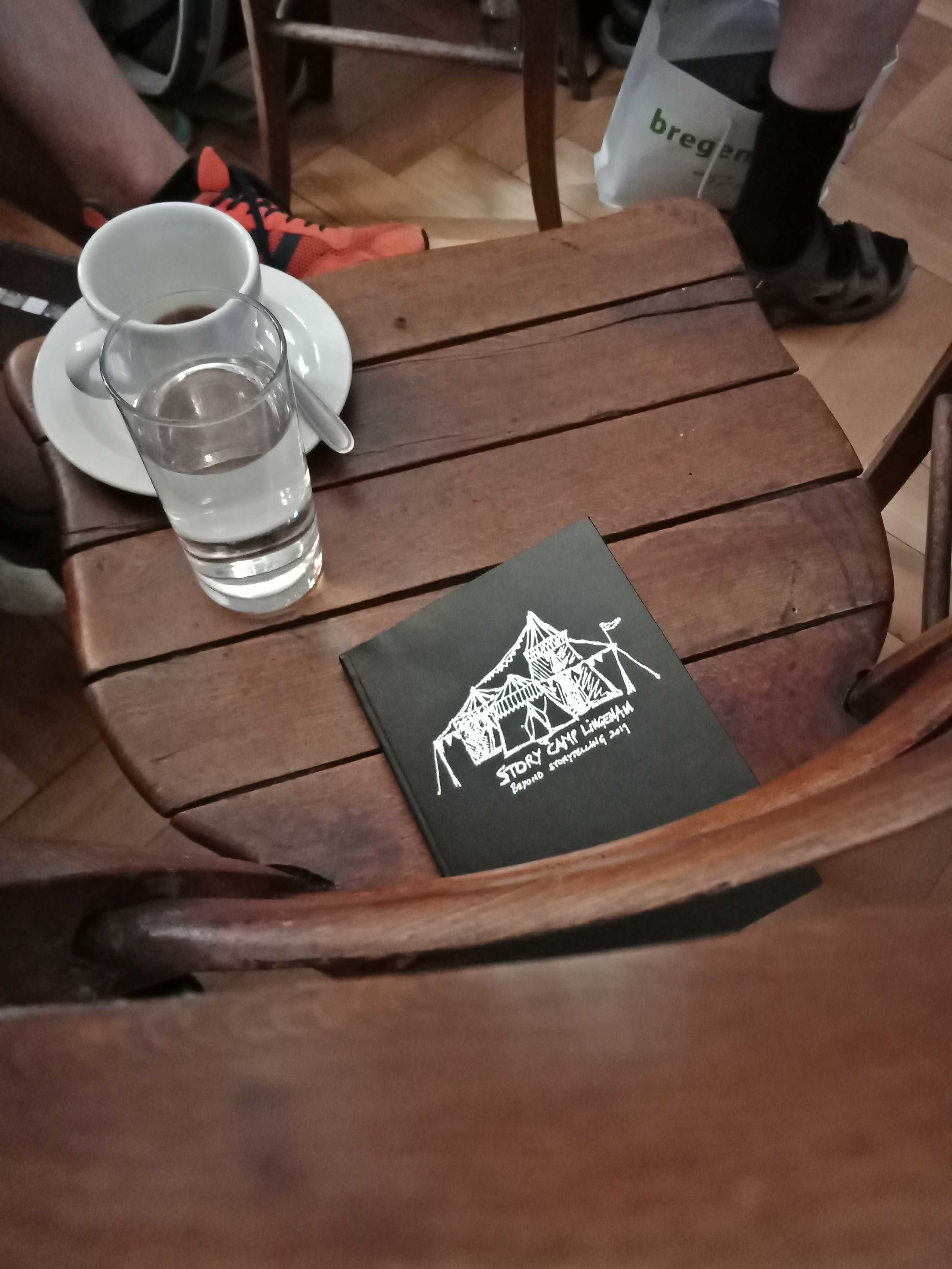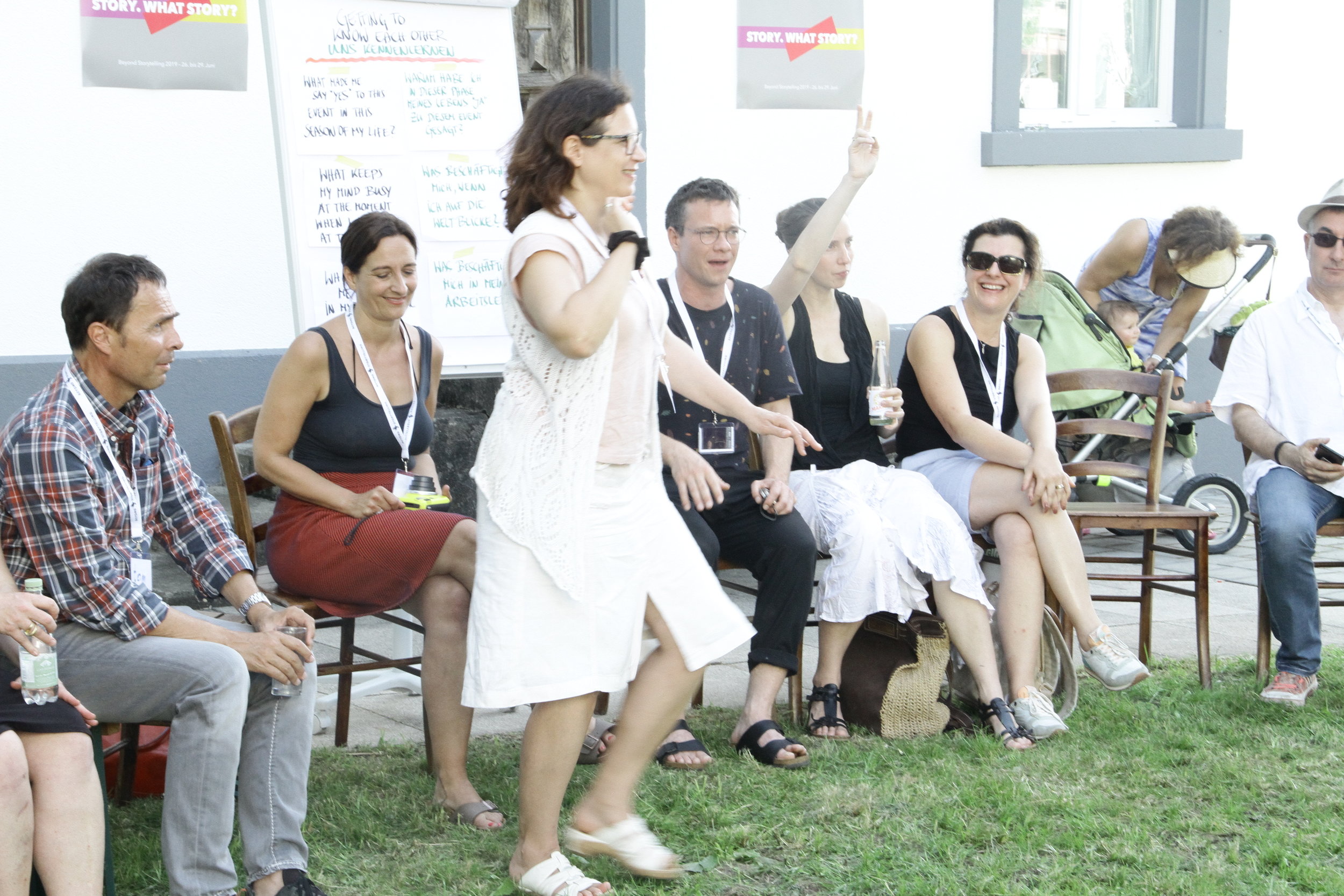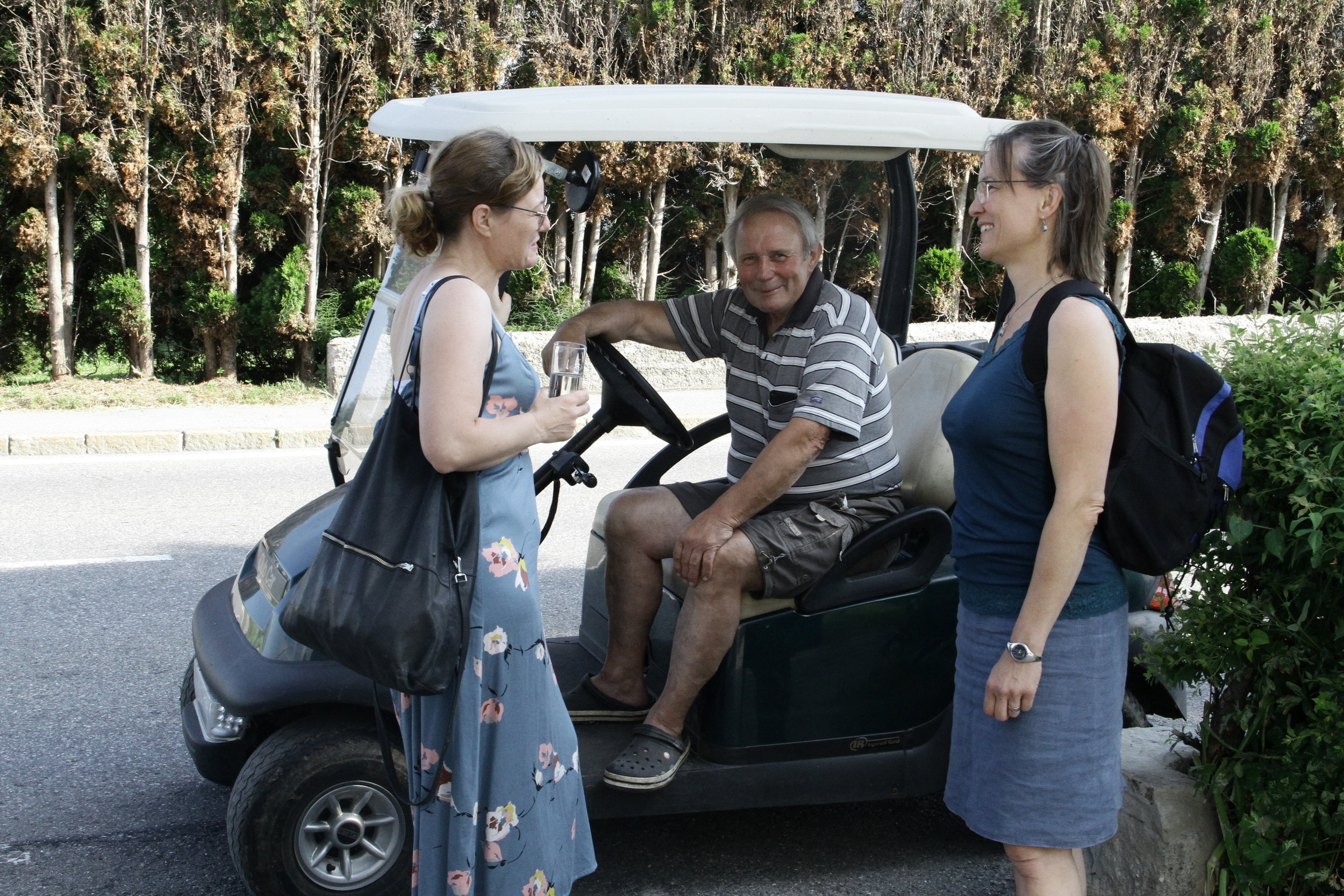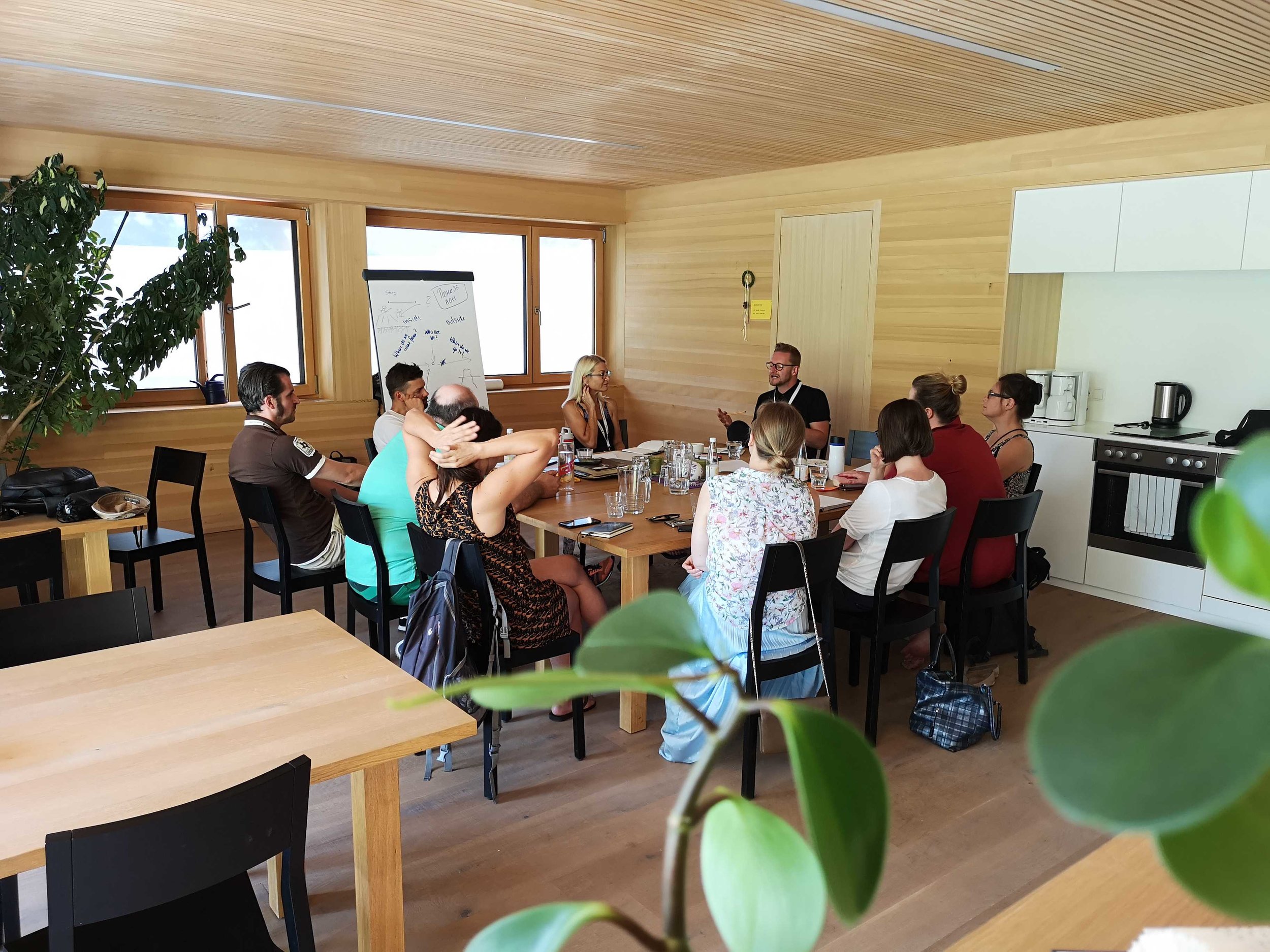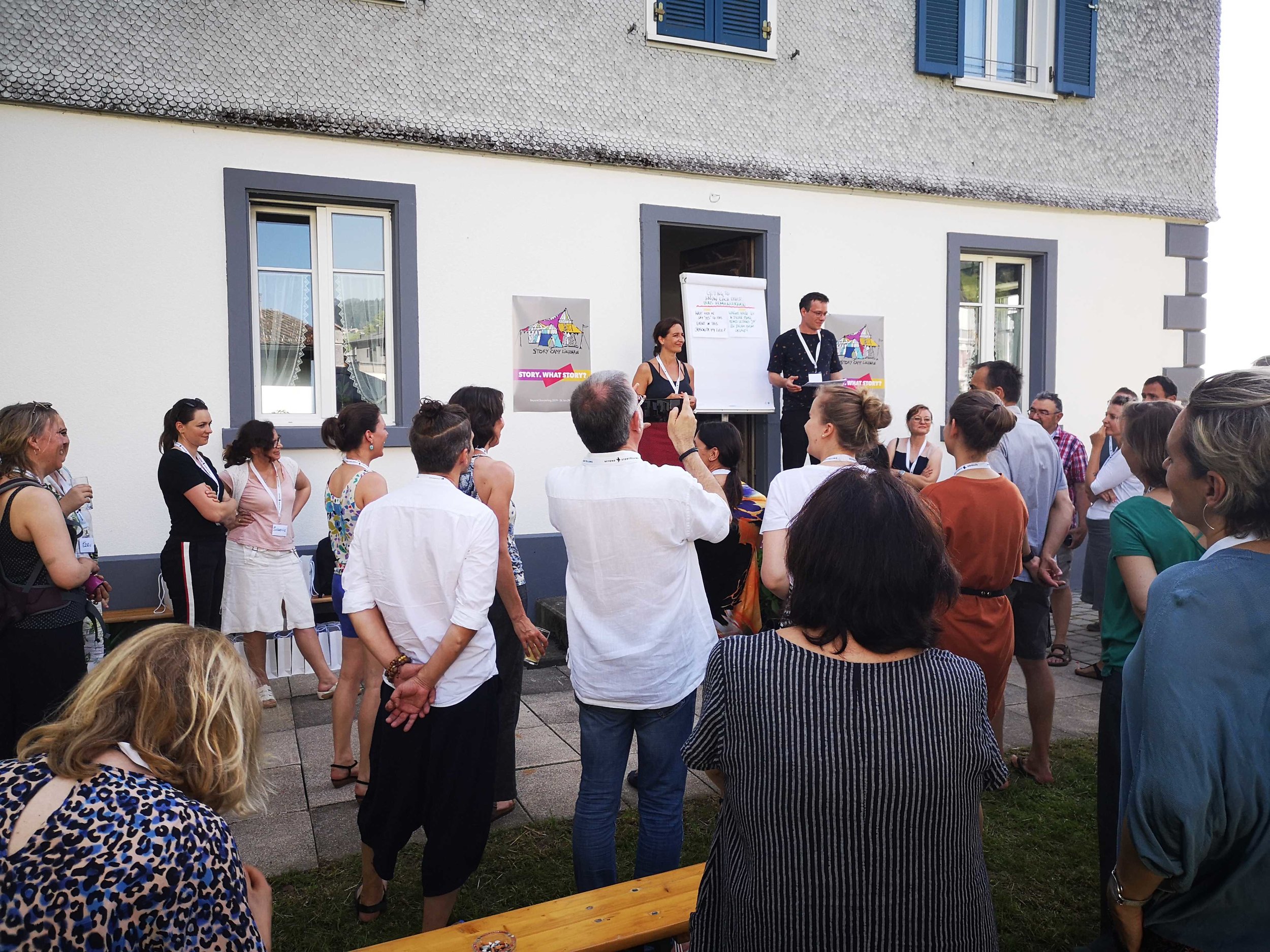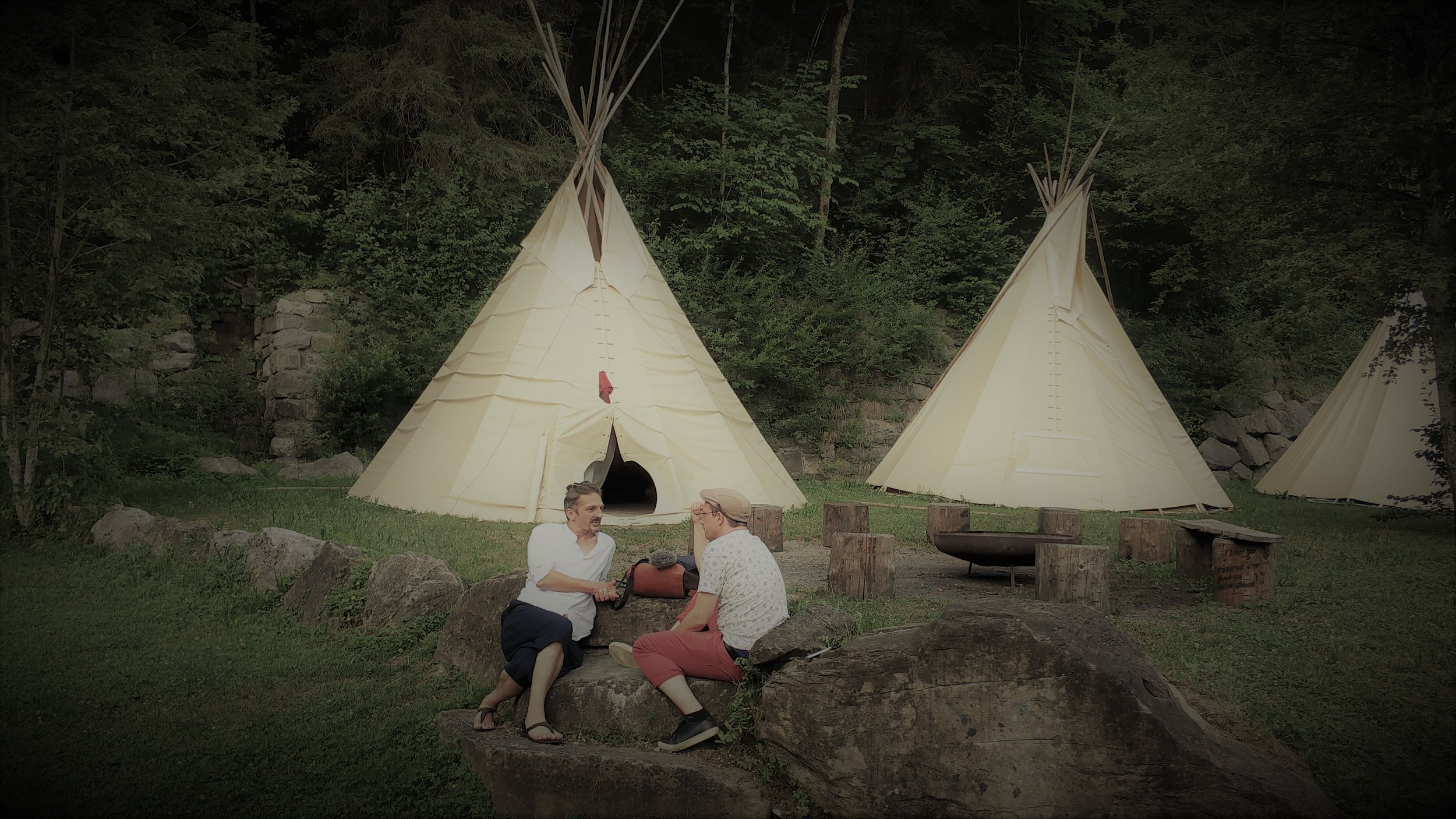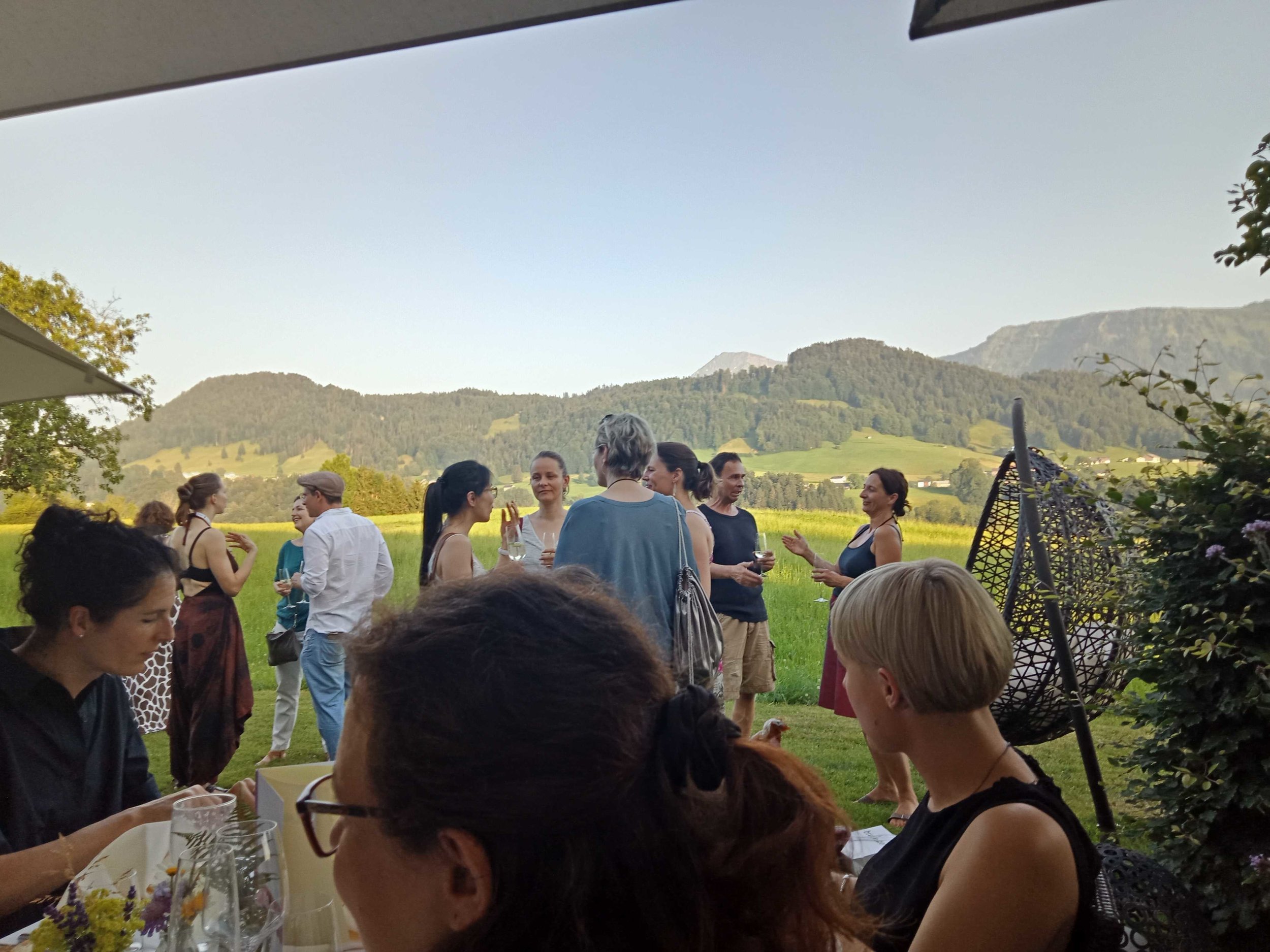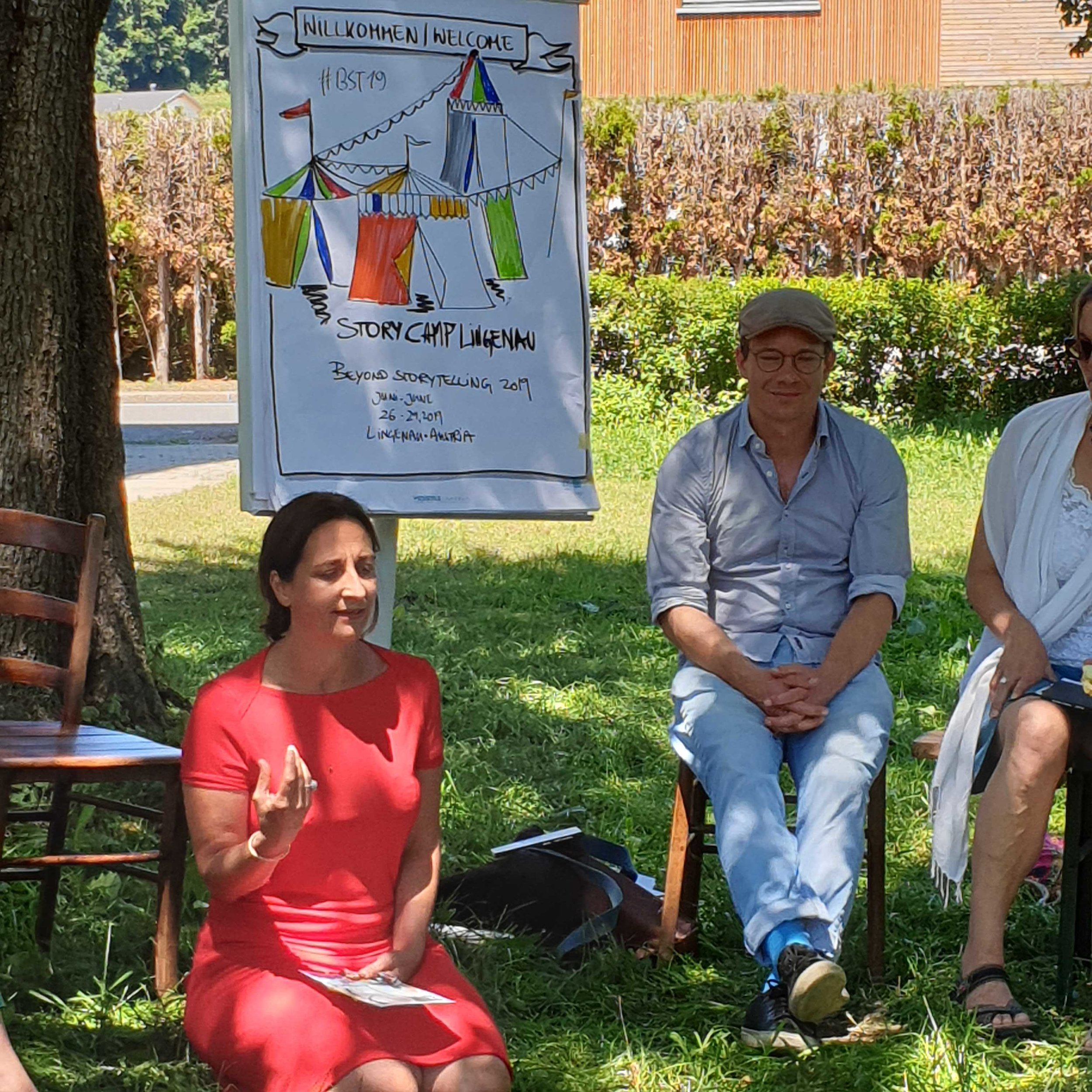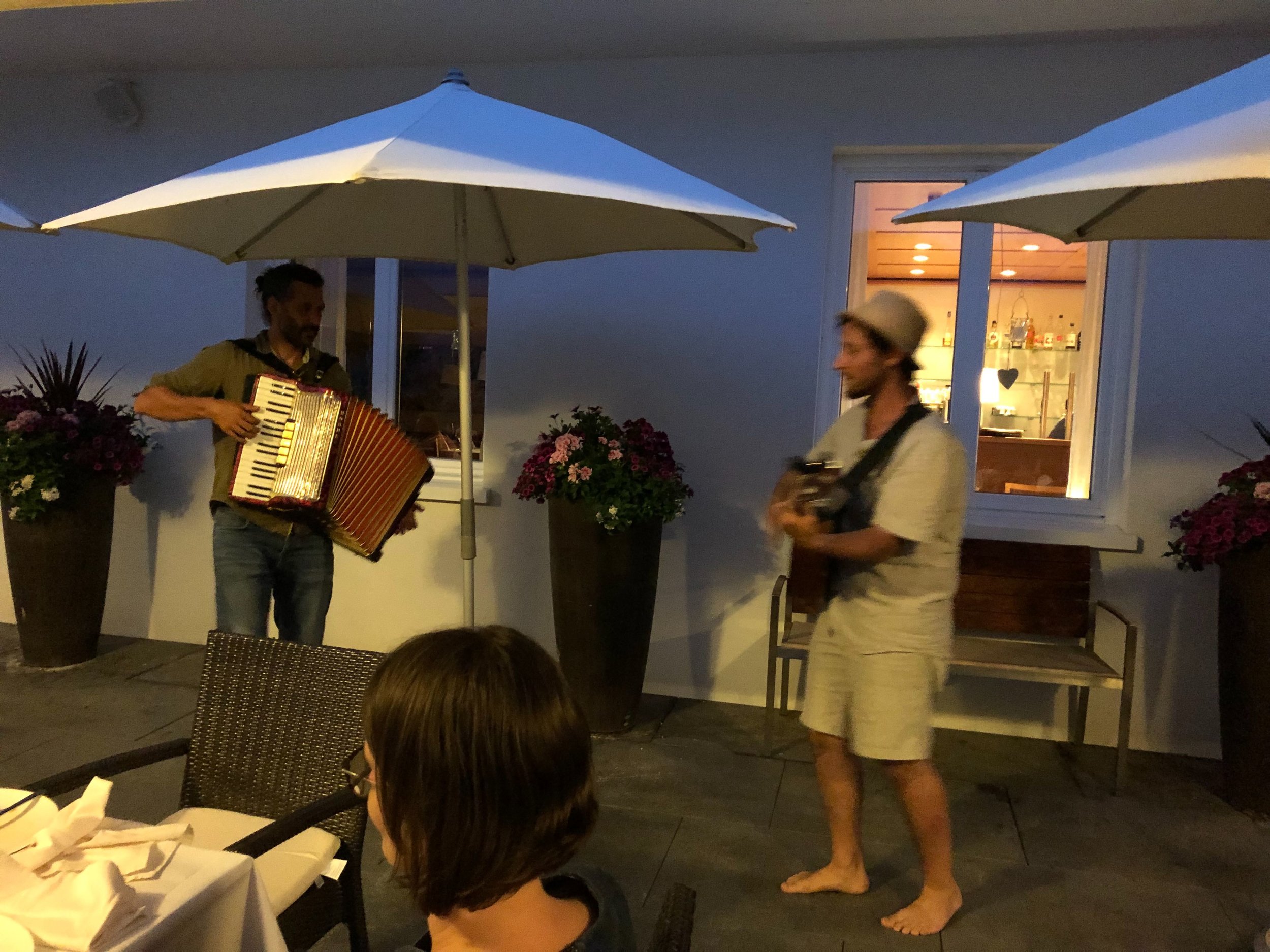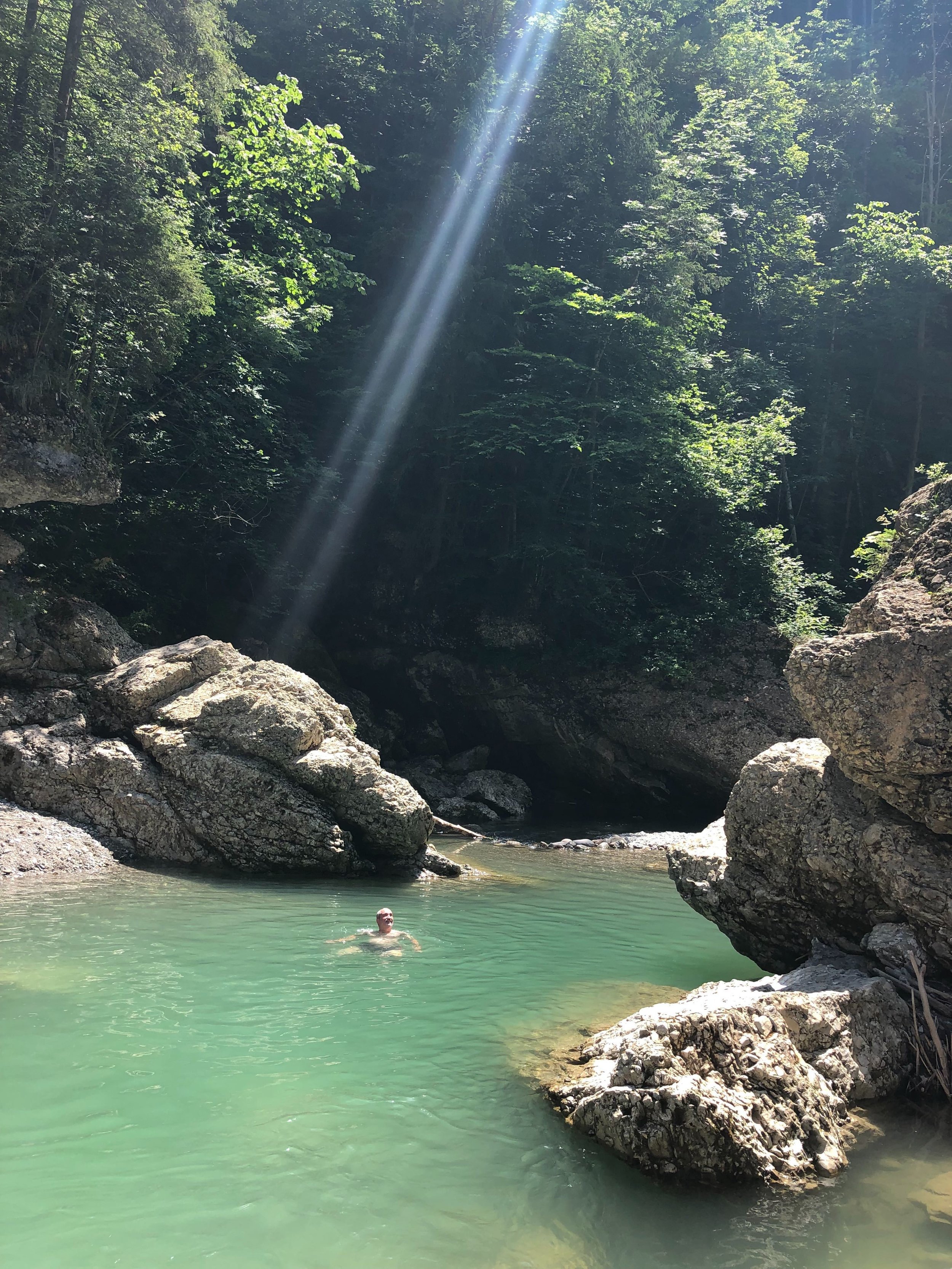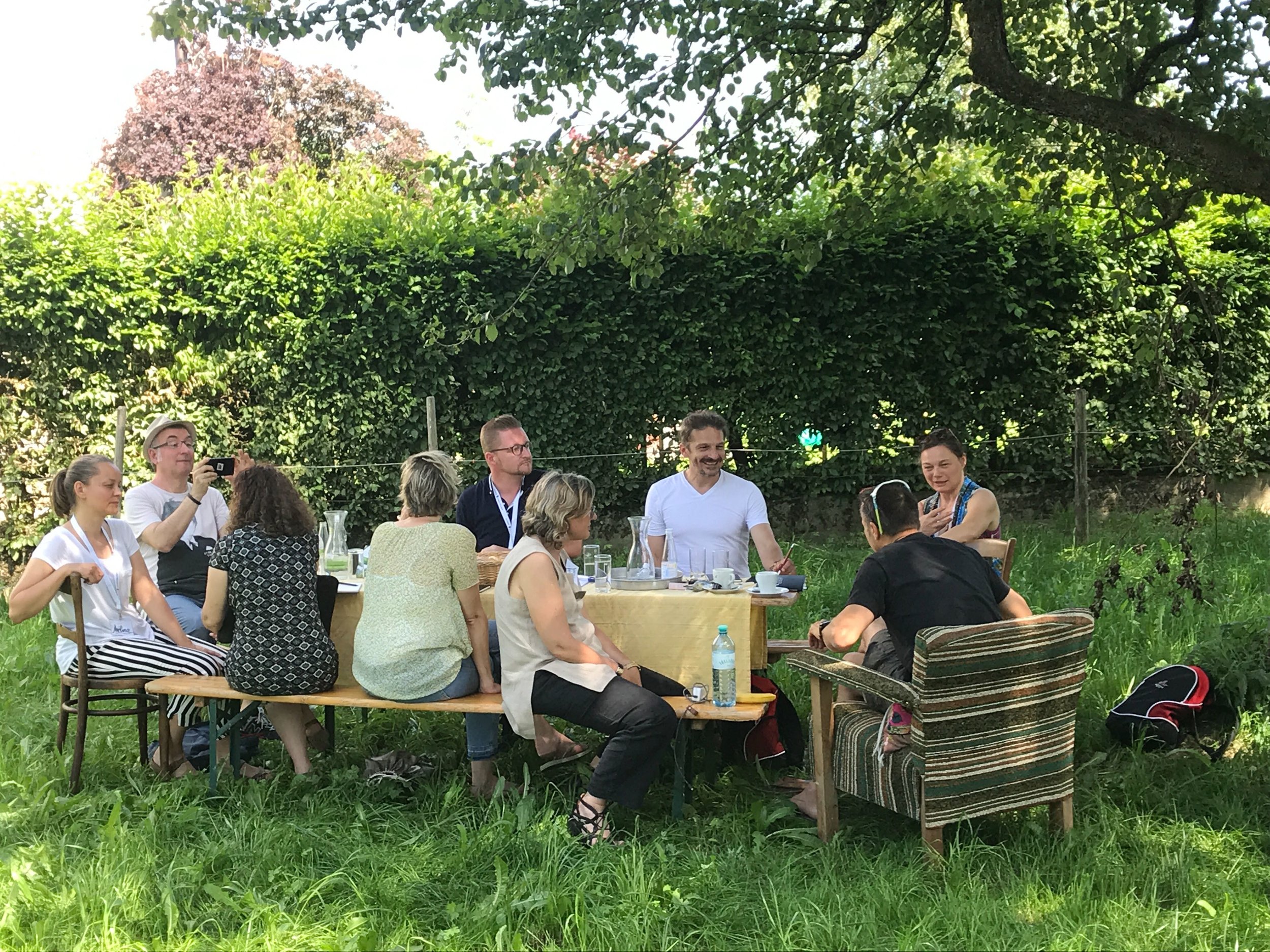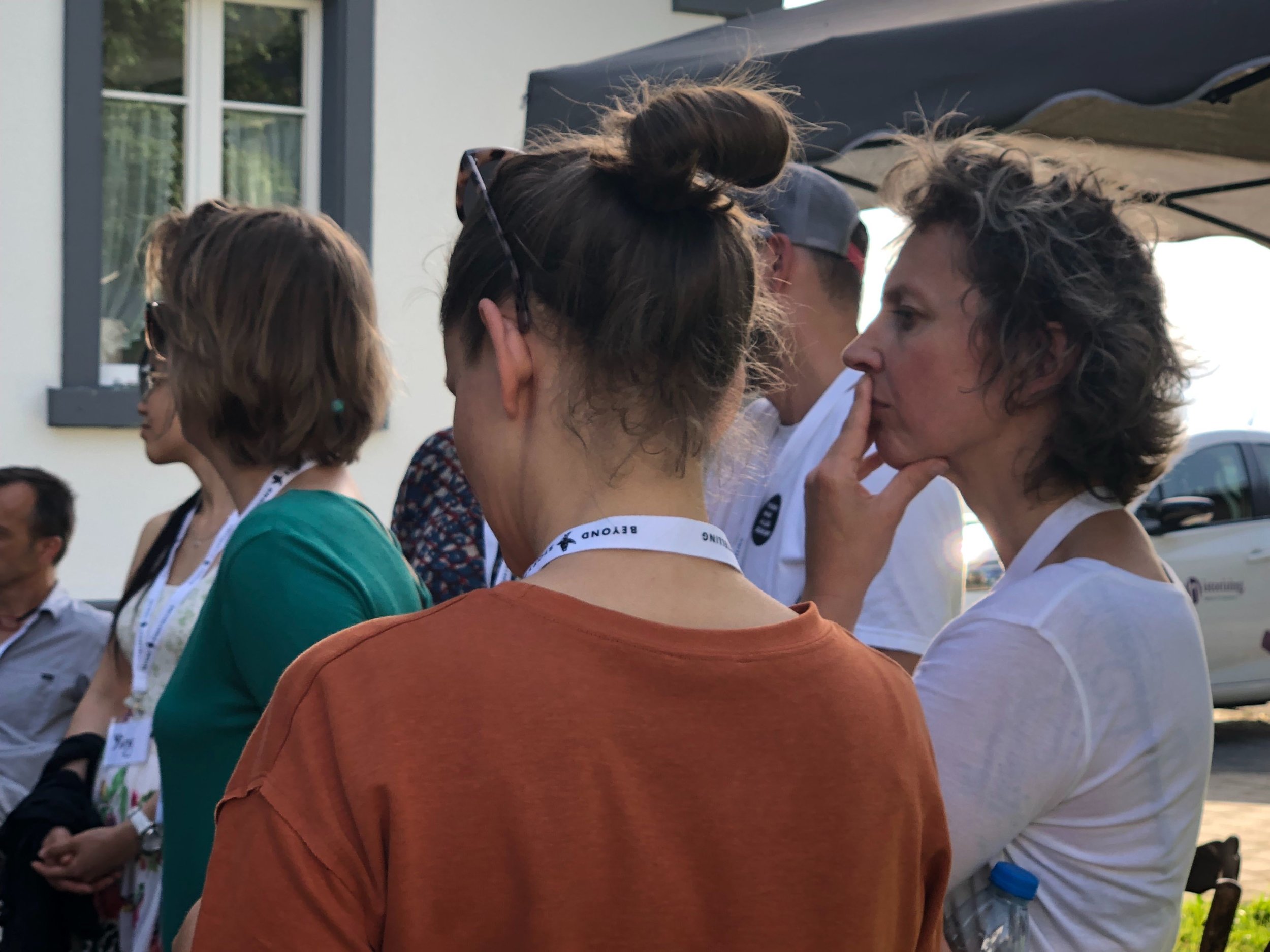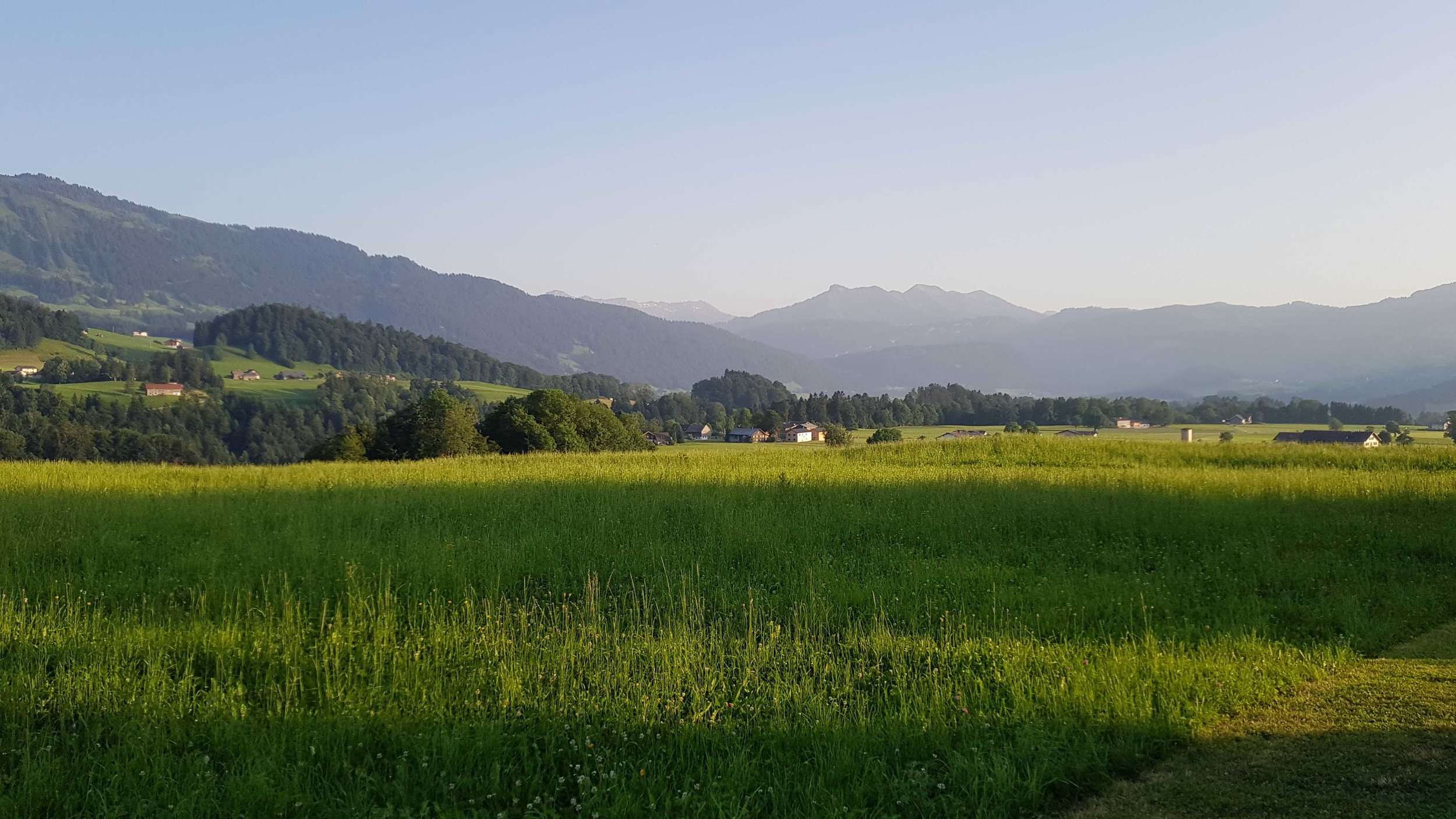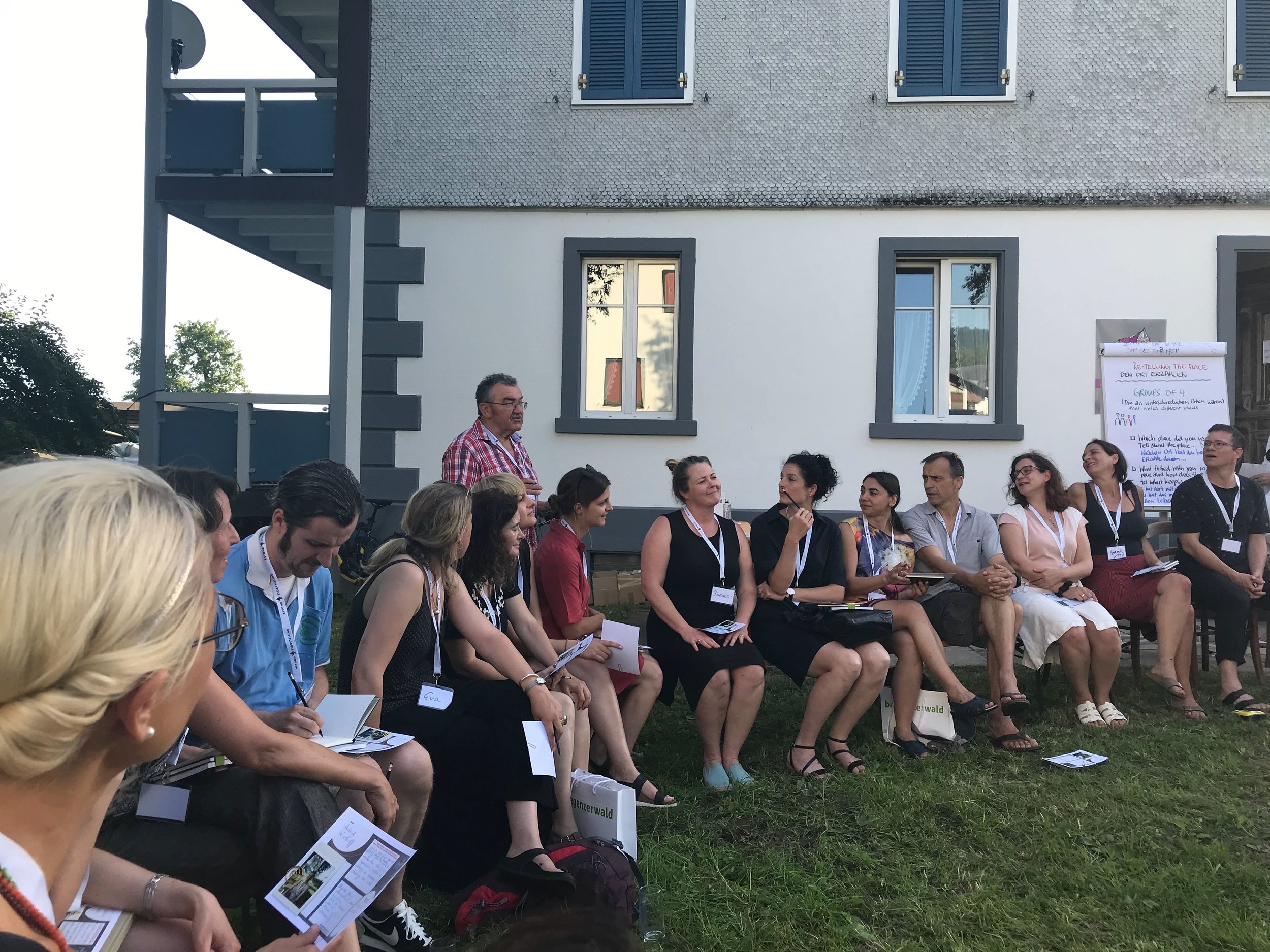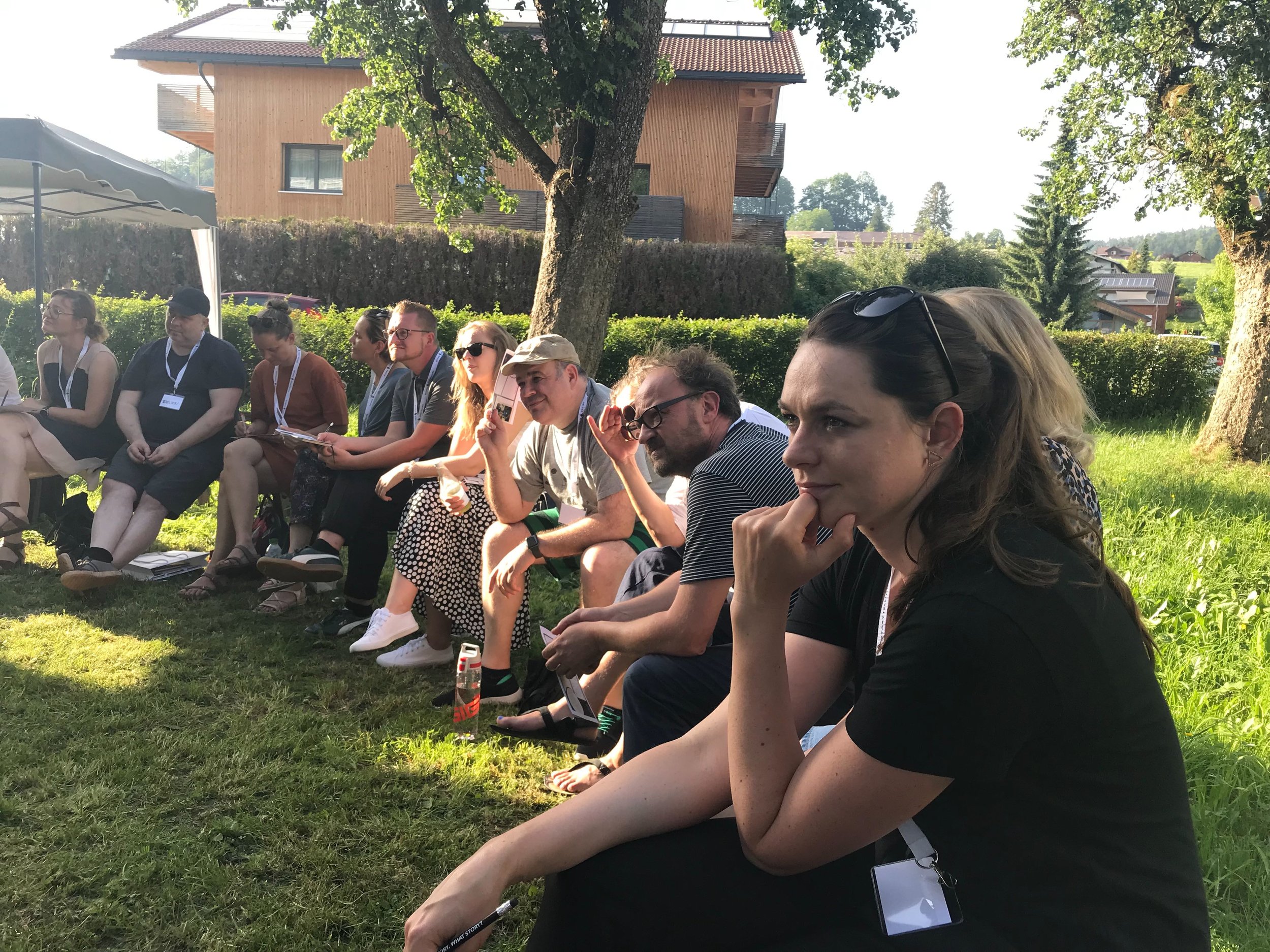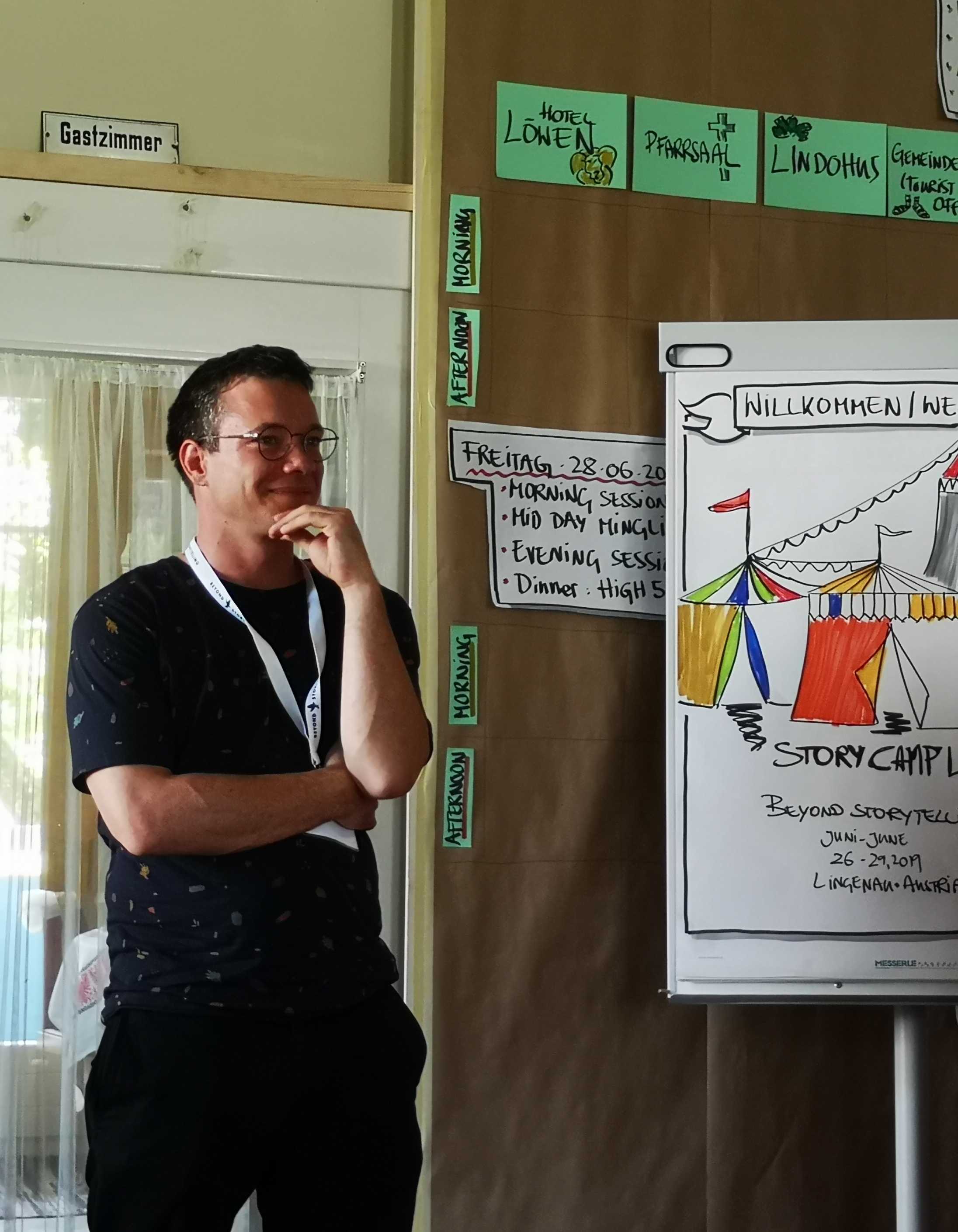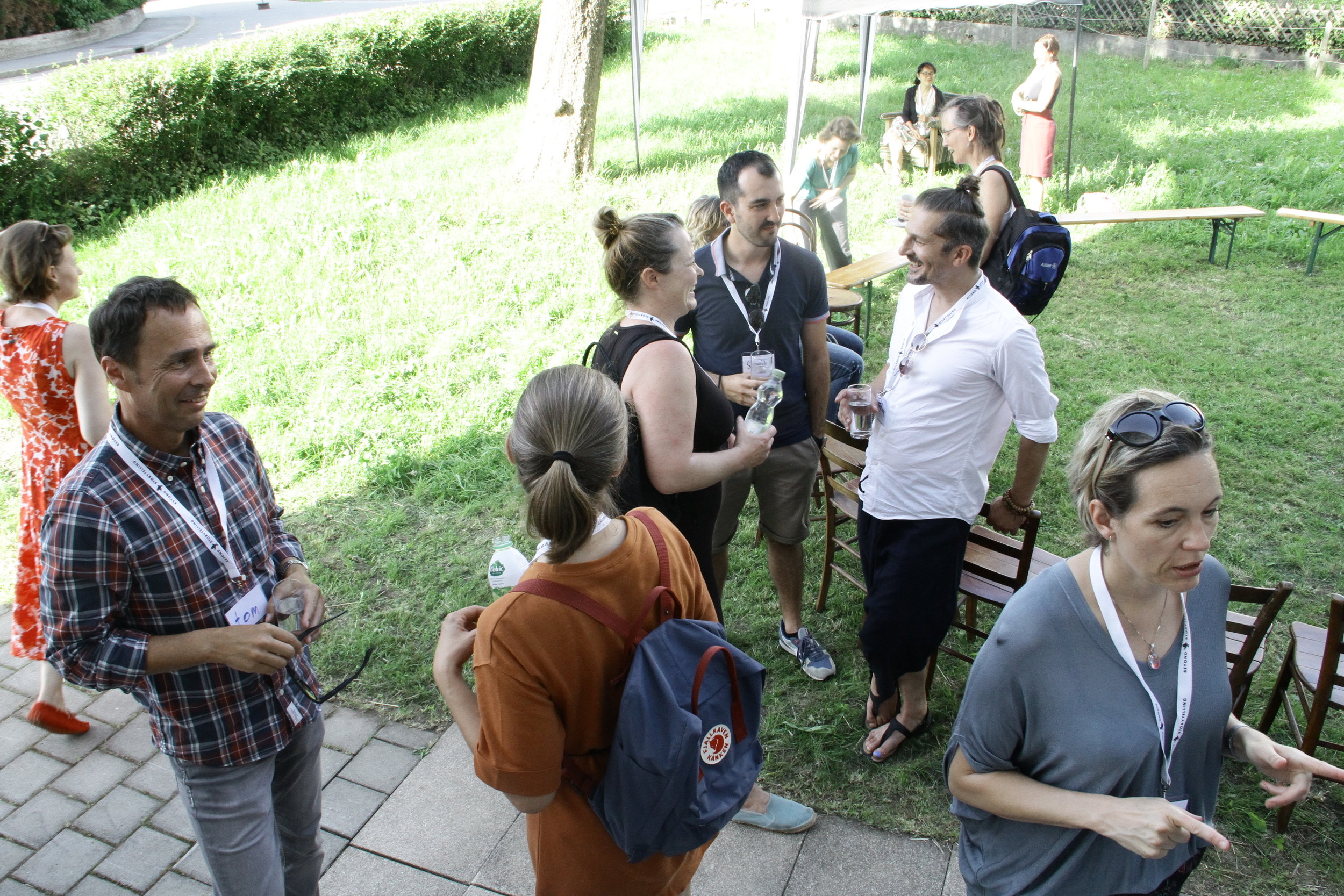Europas erste zertifizierte Fortbildung zur Narrativen Organisationsberatung startet im Februar 2020. Wolfgang Tonninger wird die Fortbildung mit seiner Expertise zum Narrativen Coaching bereichern.
VON WO ICH MICH SEHE – ein Erzählprojekt von fairMATCHING
Wir von fairMATCHING, die wir seit 2016 geflüchtete Menschen bei der Arbeitssuche begleiten, sehen es jeden Tag: dass die Geschichten, die andere über uns erzählen, beflügeln aber auch lähmen können. Und wie wichtig es ist, die Autorschaft über seine eigene Geschichte einzufordern, um nicht den Festschreibungen der anderen hinterherzulaufen, ein Leben lang.
Daraus ist, im Zusammenspiel mit dem wunderbaren Fotografen Enrique Pasquali, die Idee für die Ausstellung “VON WO ICH MICH SEHE” entstanden. Eine Serie aus Wort-Bild-Collagen, in denen die Portraitierten in ihrer Individualität zu leuchten beginnen und damit den herrschenden Diskurs über Flucht und Heimat herausfordern. Das war die Ausgangsidee. Für das Salzburger Dialogjahr 2019 wurde diese Portraitserie von “Geflüchteten” nun um 8 Portraits von “Einheimischen” erweitert. Das Ergebnis ist eine Wanderausstellung aus 16 Bildern und Zitaten, die nicht nur mit dem Publikum, sondern auch untereinander in Dialog treten. Indem sie Geschichten andeuten, die im Auge und Herzen der Betrachterin weitererzählt werden.
Das Setting war sehr speziell. Anstatt jedem Portraitierten die gleiche Frage zu stellen, ließen wir uns mit jedem Gegenüber auf ein Gespräch ein und erkundeten gemeinsam und sehr individuell das Terrain, in dem Identität geformt wird. Und ließen uns überraschen. Wie von Randa Abdulla (siehe erstes Bild der Gallerie), die lange über die Suche nach ihrer Rolle als Frau hier in Österreich sprach, ehe sie einen Moment lang innehielt, um mit einem Leuchten in den Augen festzuhalten, dass sie eigentlich gar keine Syrerin sei. Und dann erzählte sie von Palästina, vom See Genezareth und dem Ort Tiberias, wo ihre Großmutter lebte. Sie beschrieb die rotbraune Erde ihrer Heimat, die so fruchtbar war, dass alles, was sie fallen ließ, zu wachsen begann. Daraus entstand dieser eine Satz. Das Leuchten ist im Bild zu sehen.
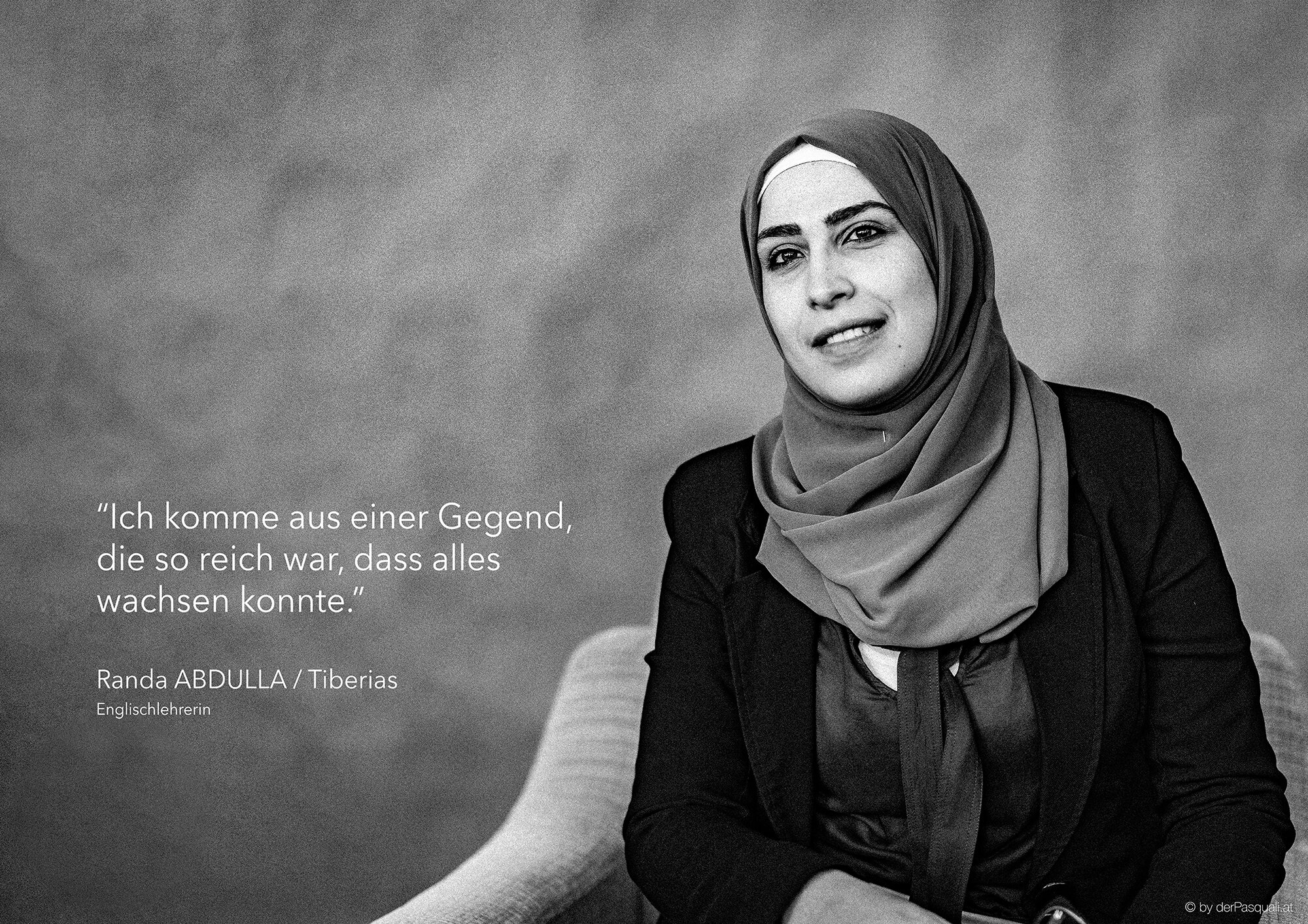

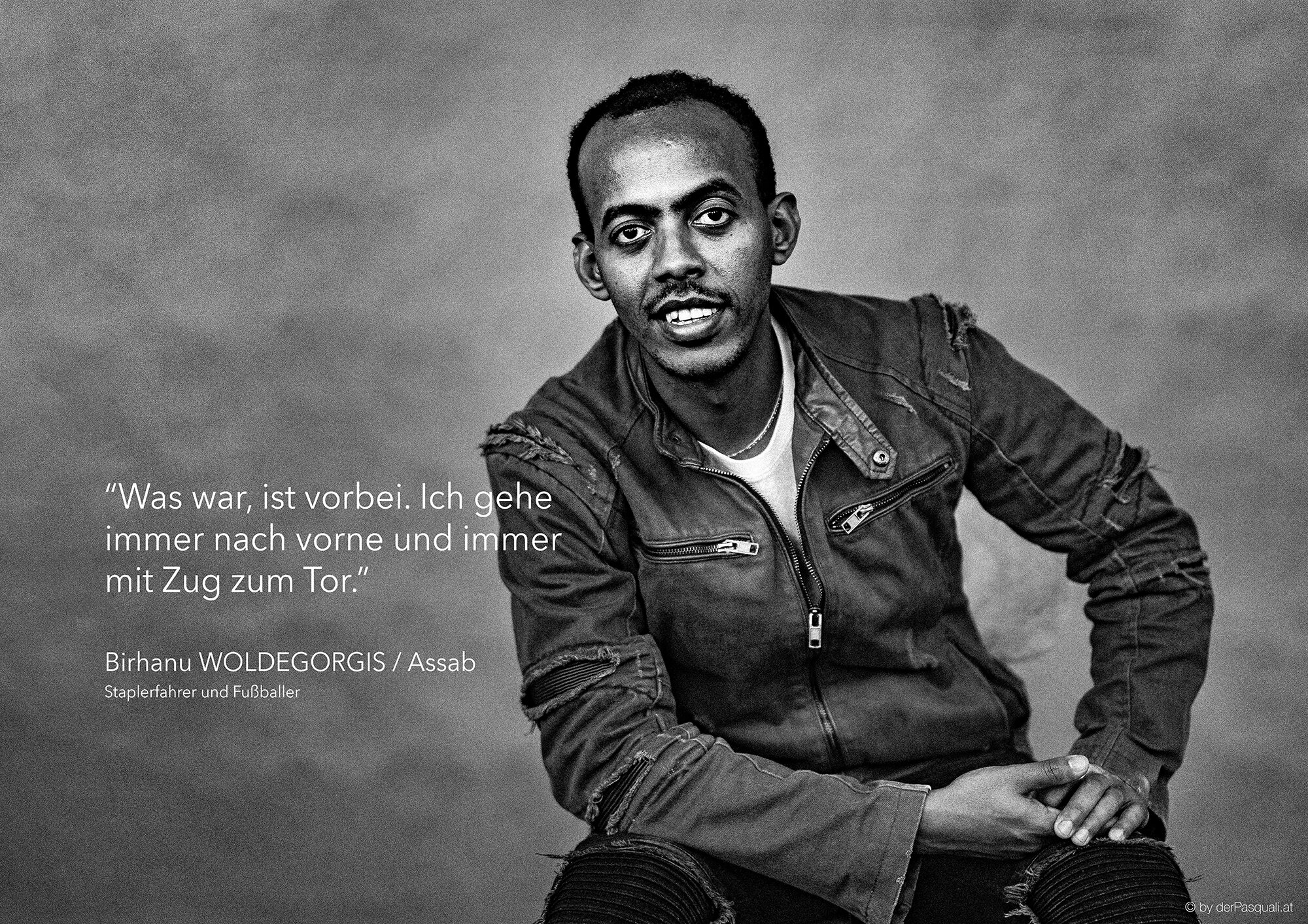
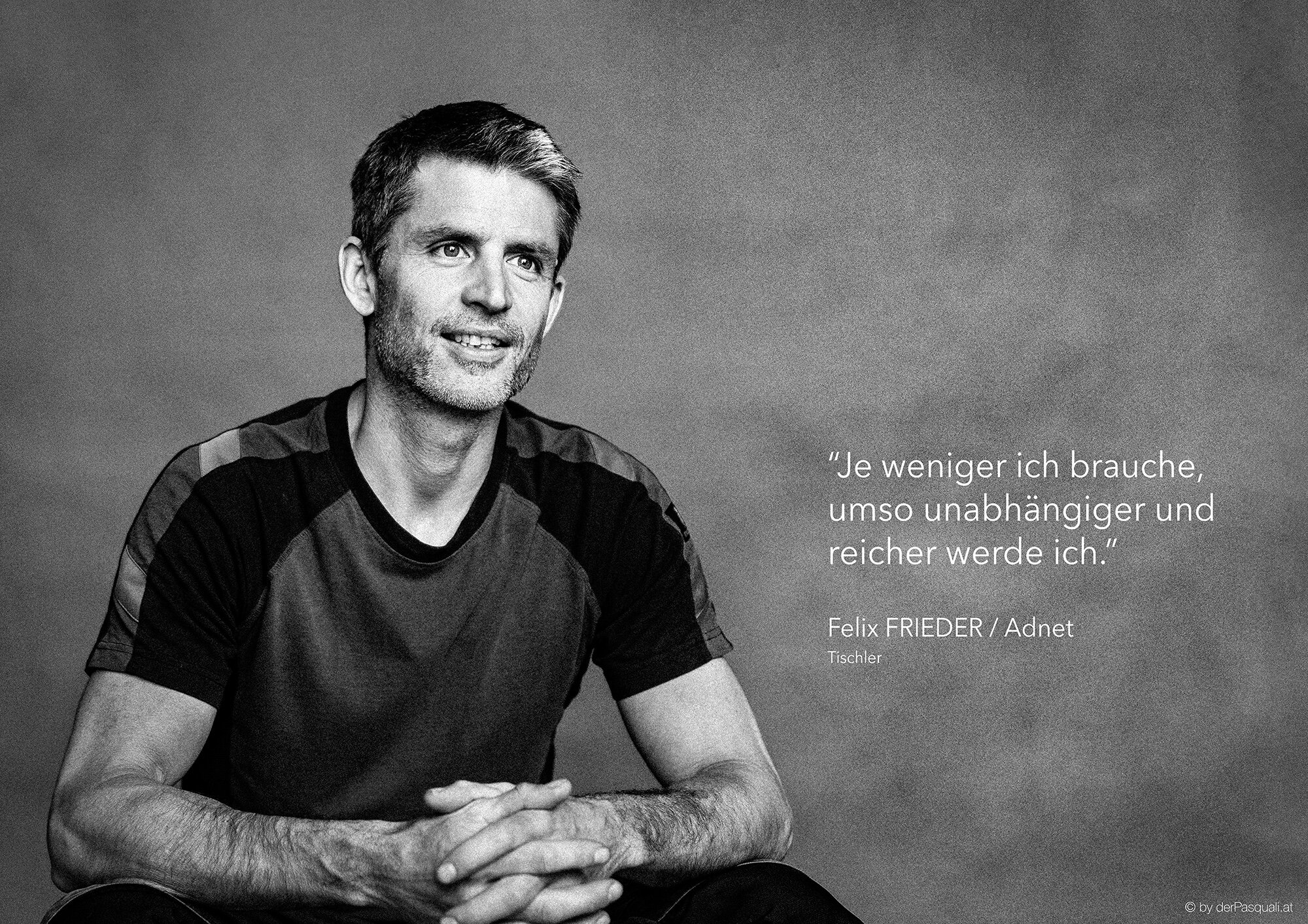

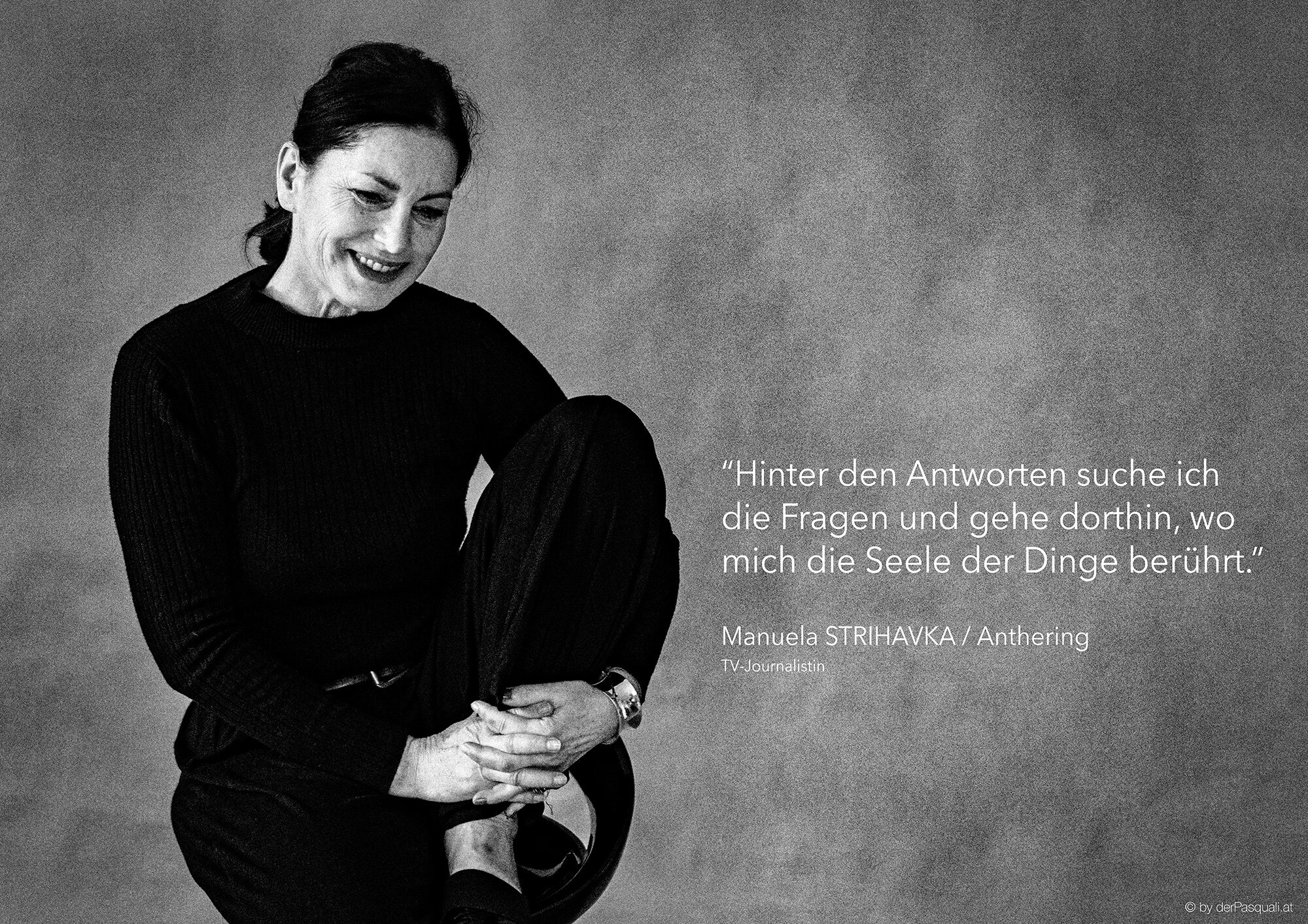
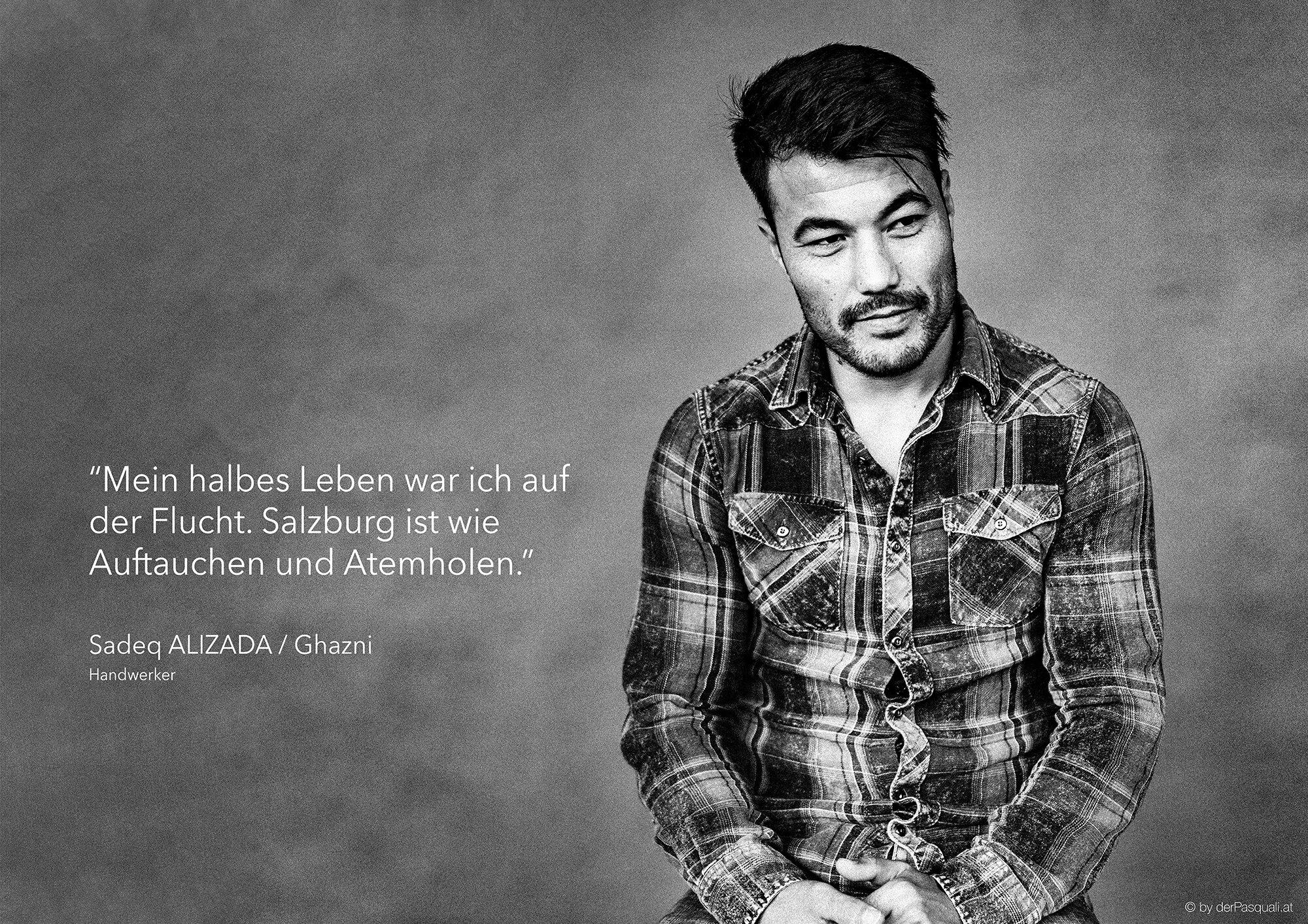
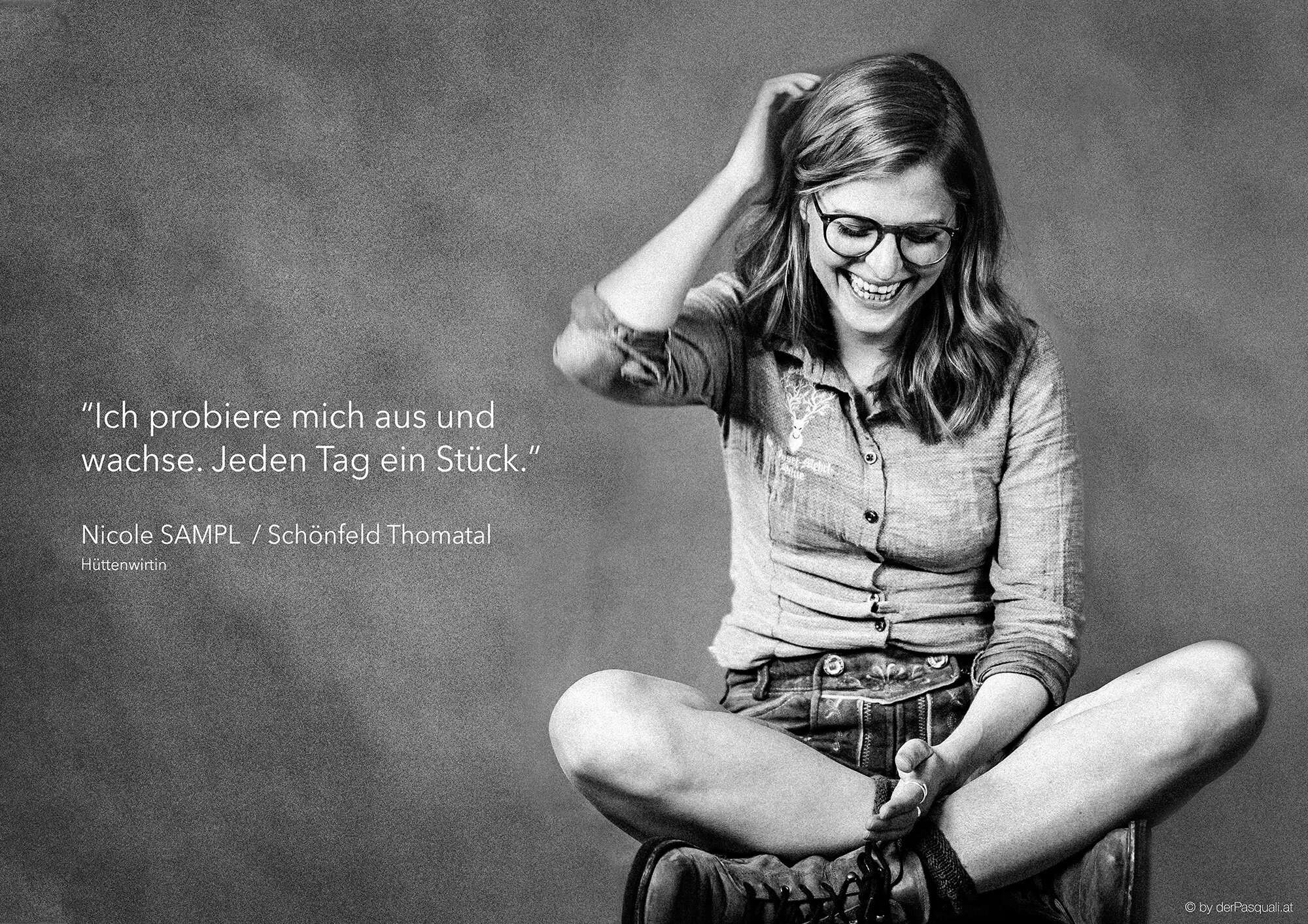
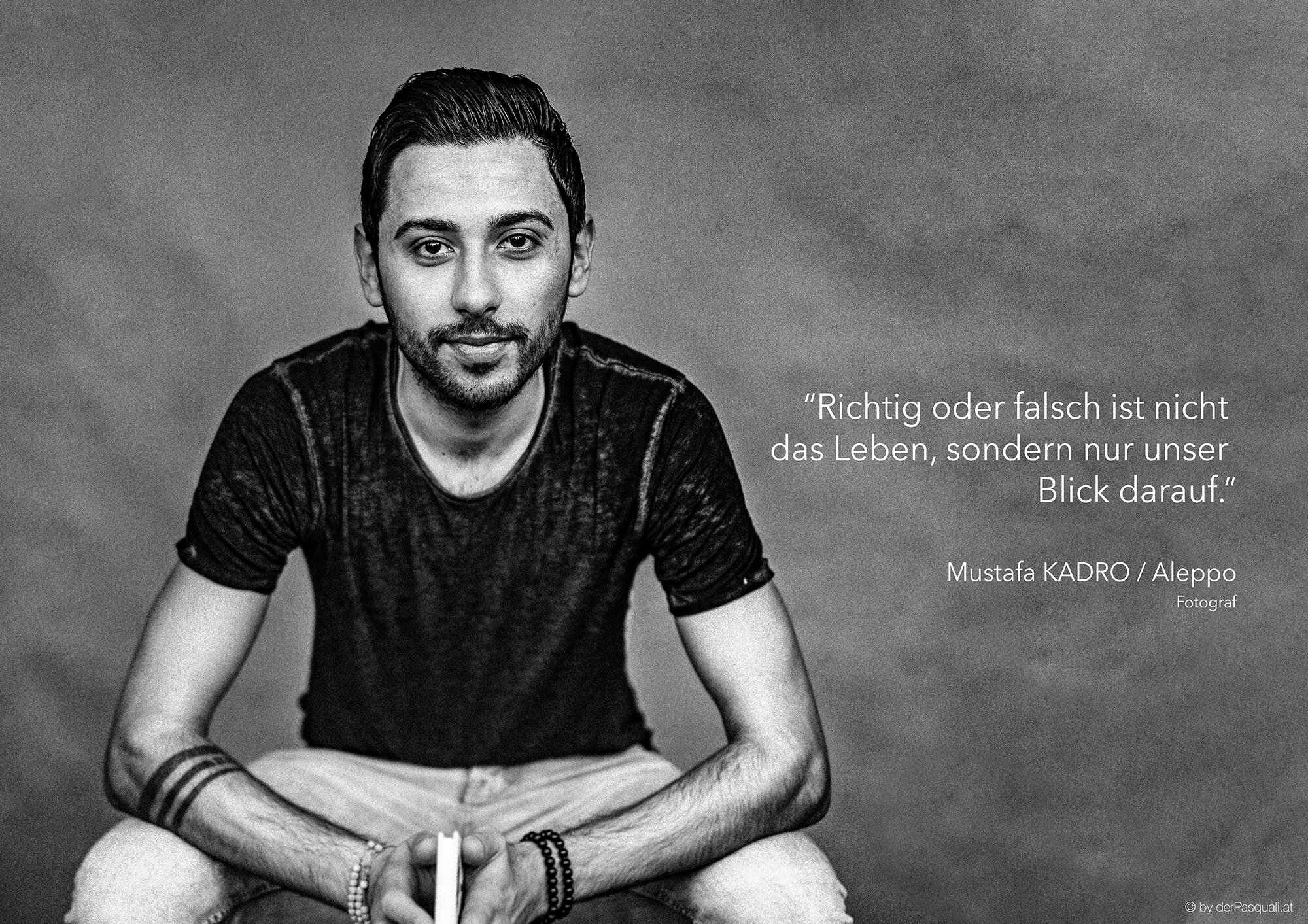
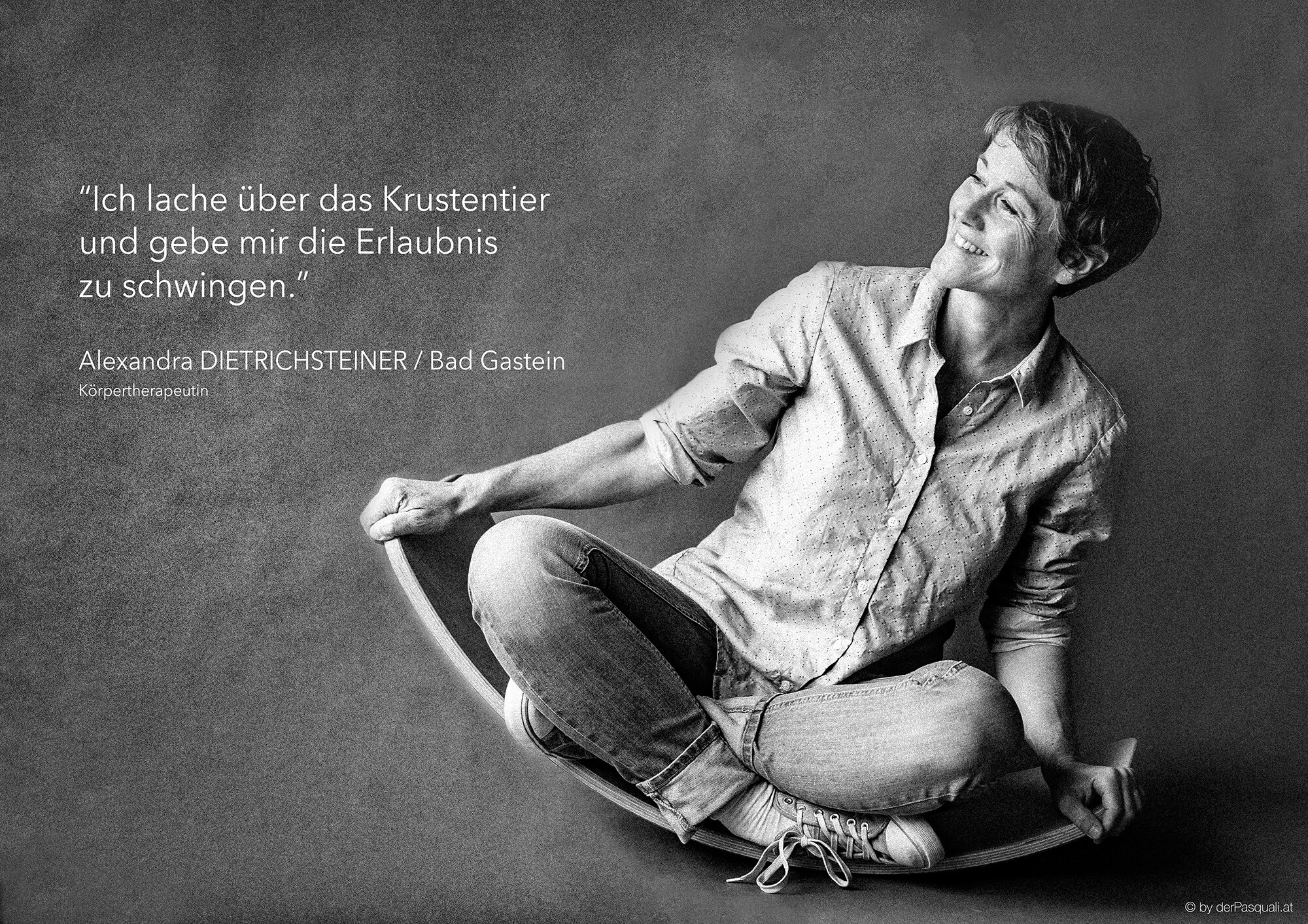
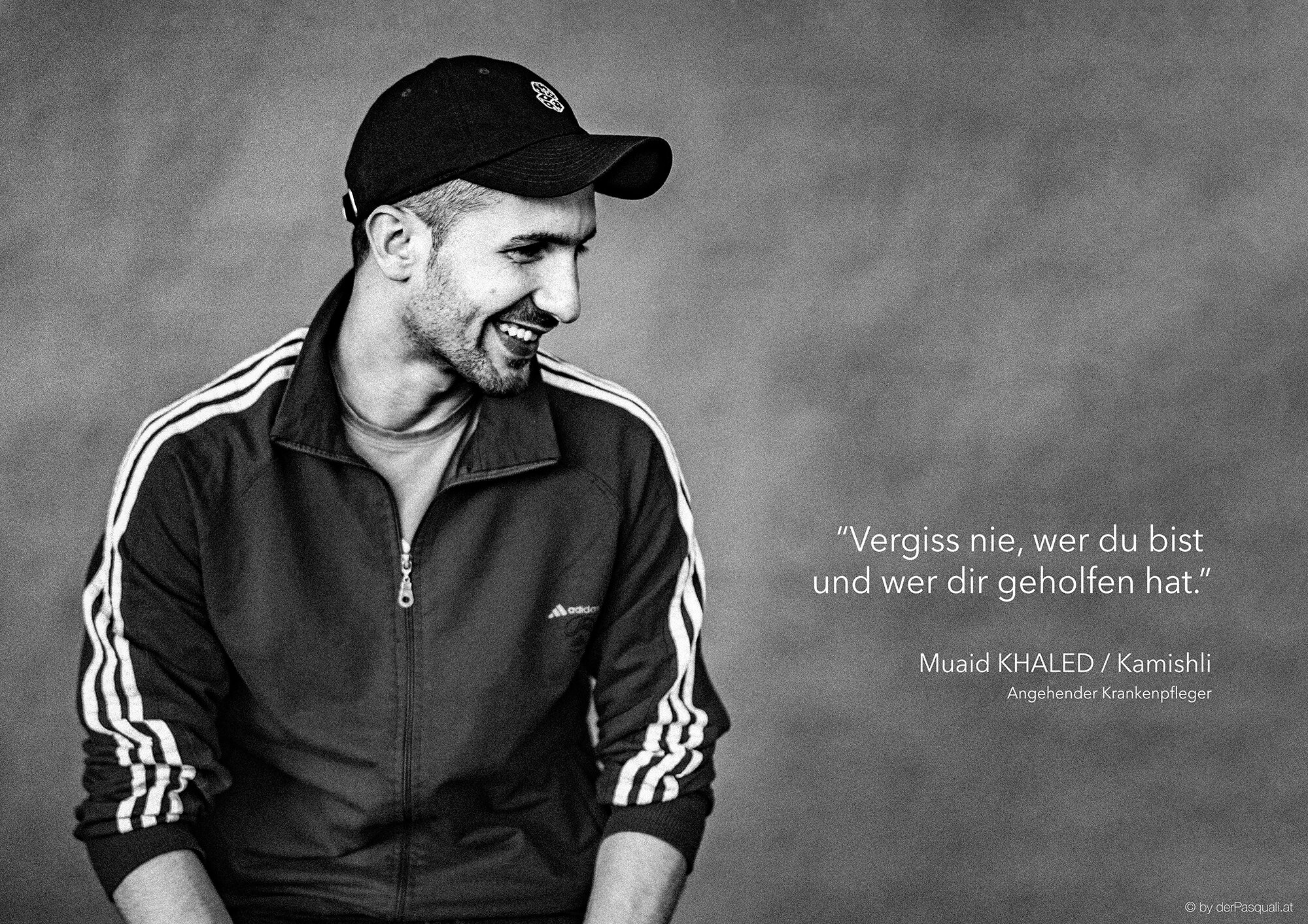
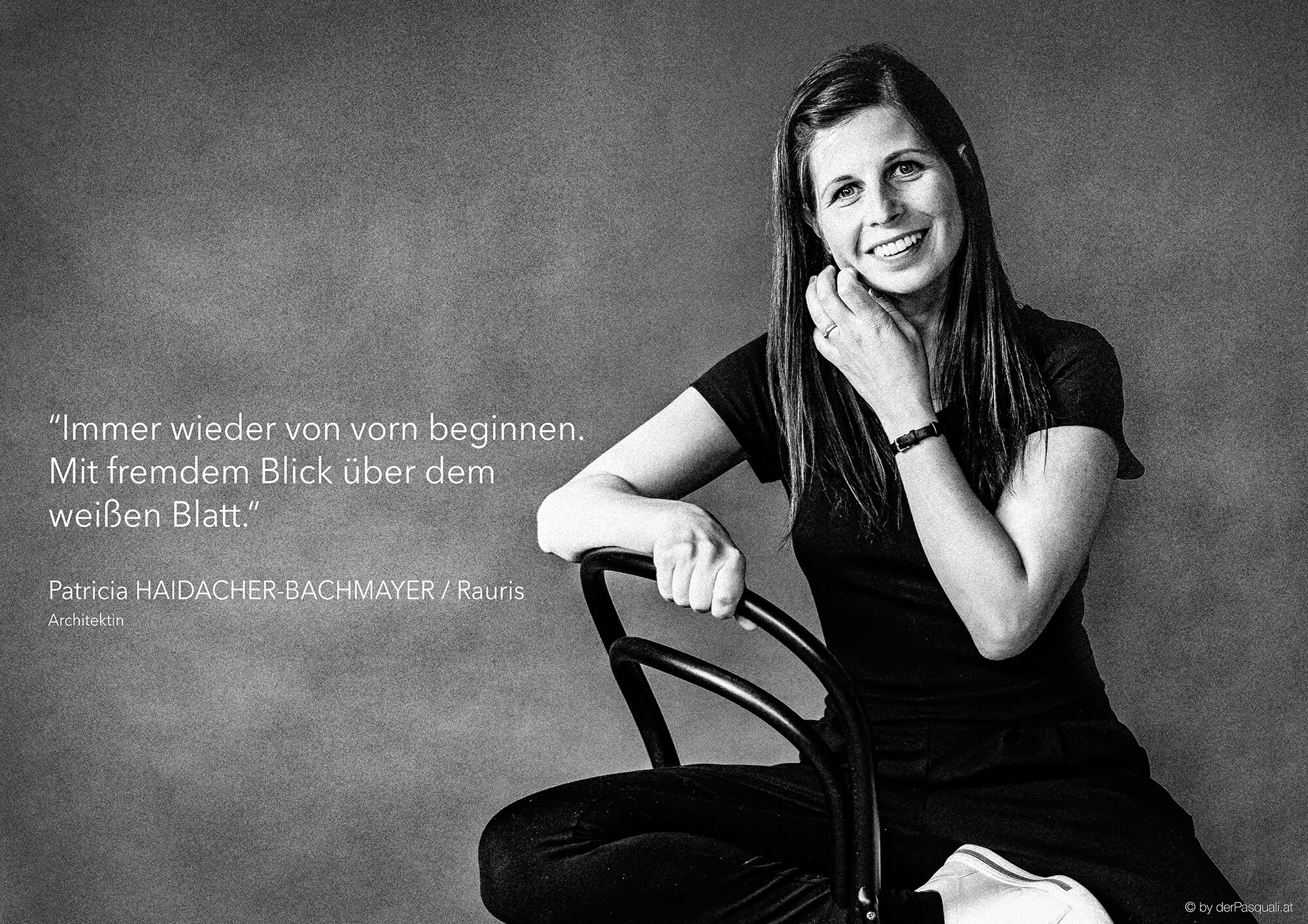
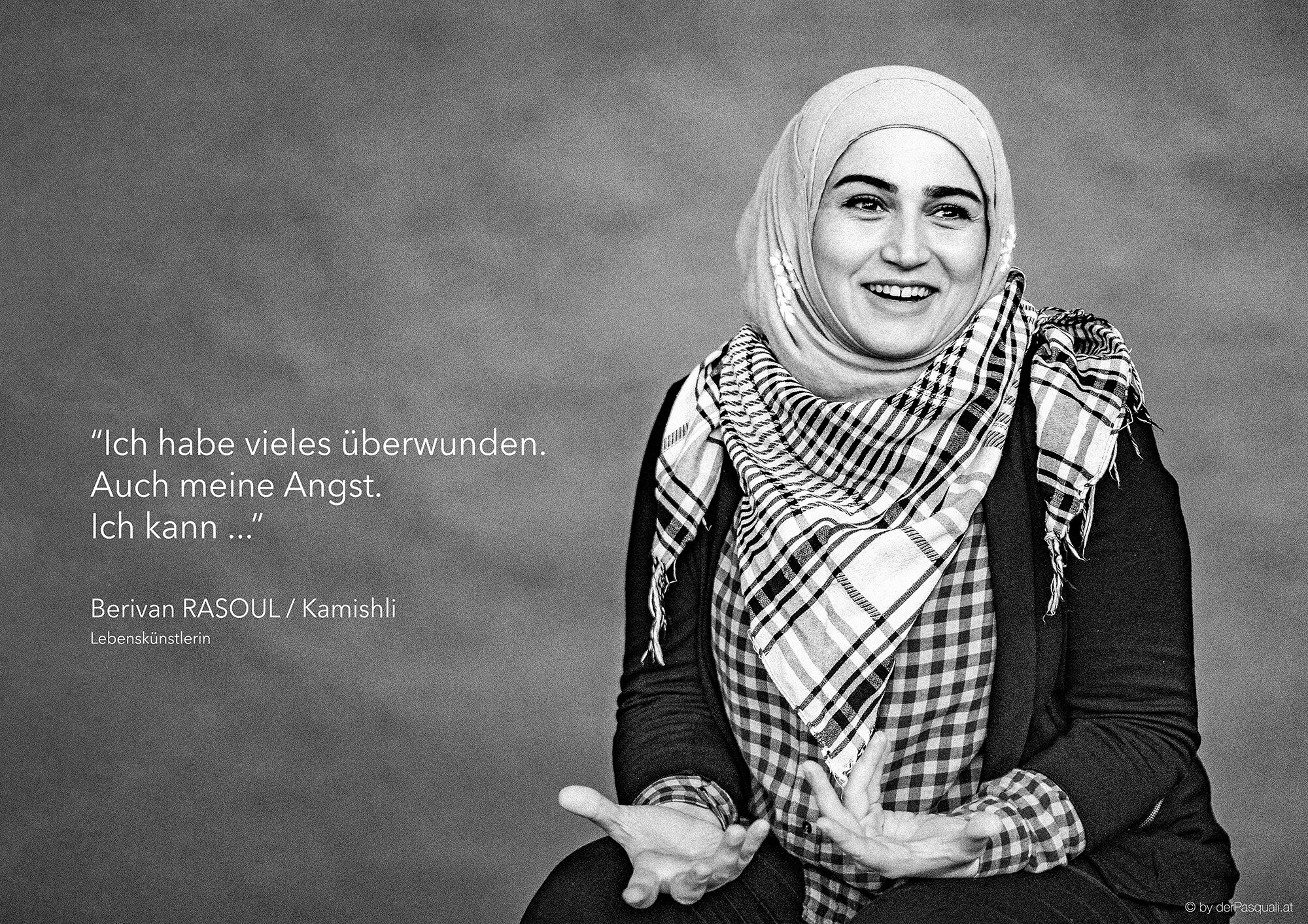
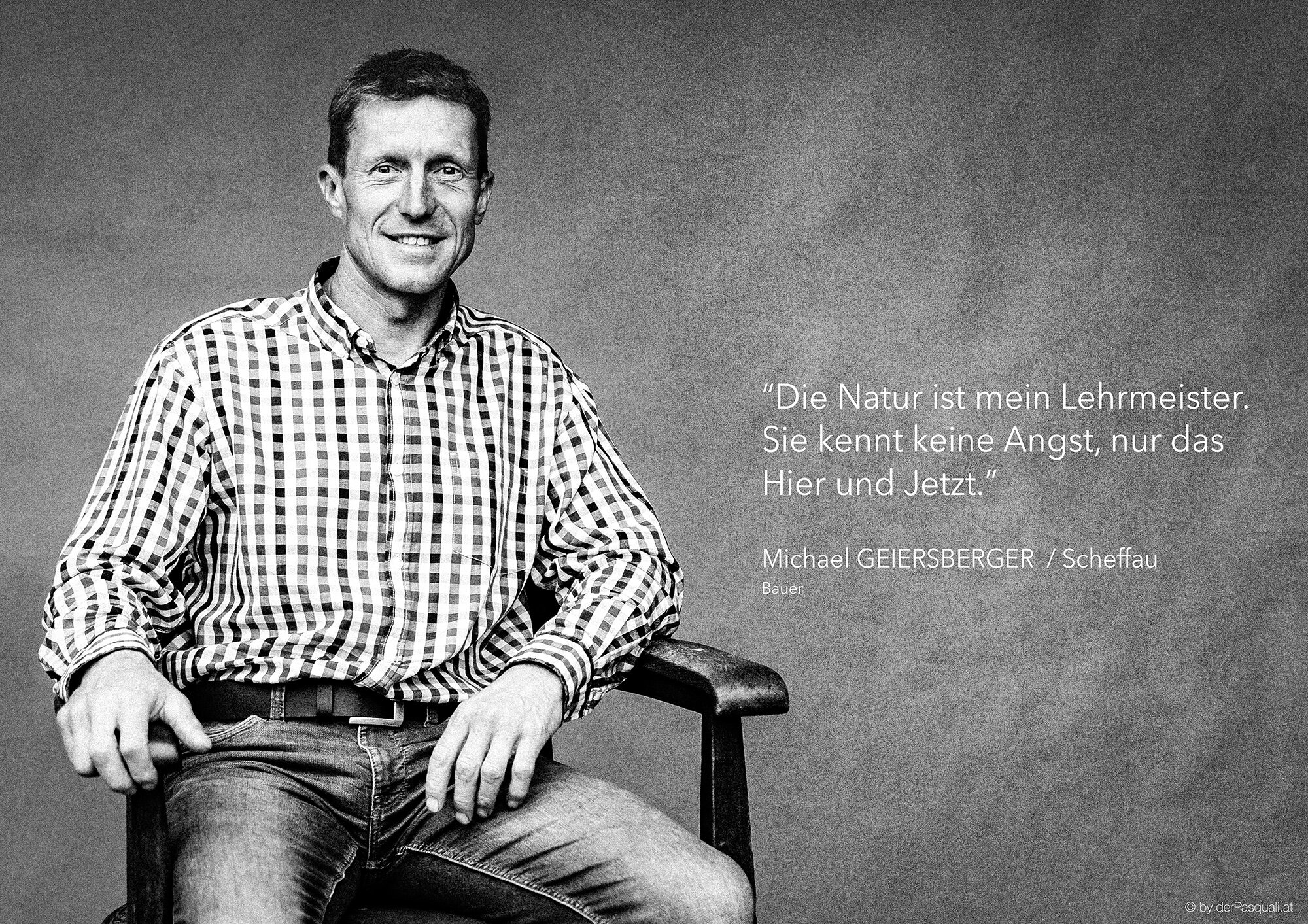
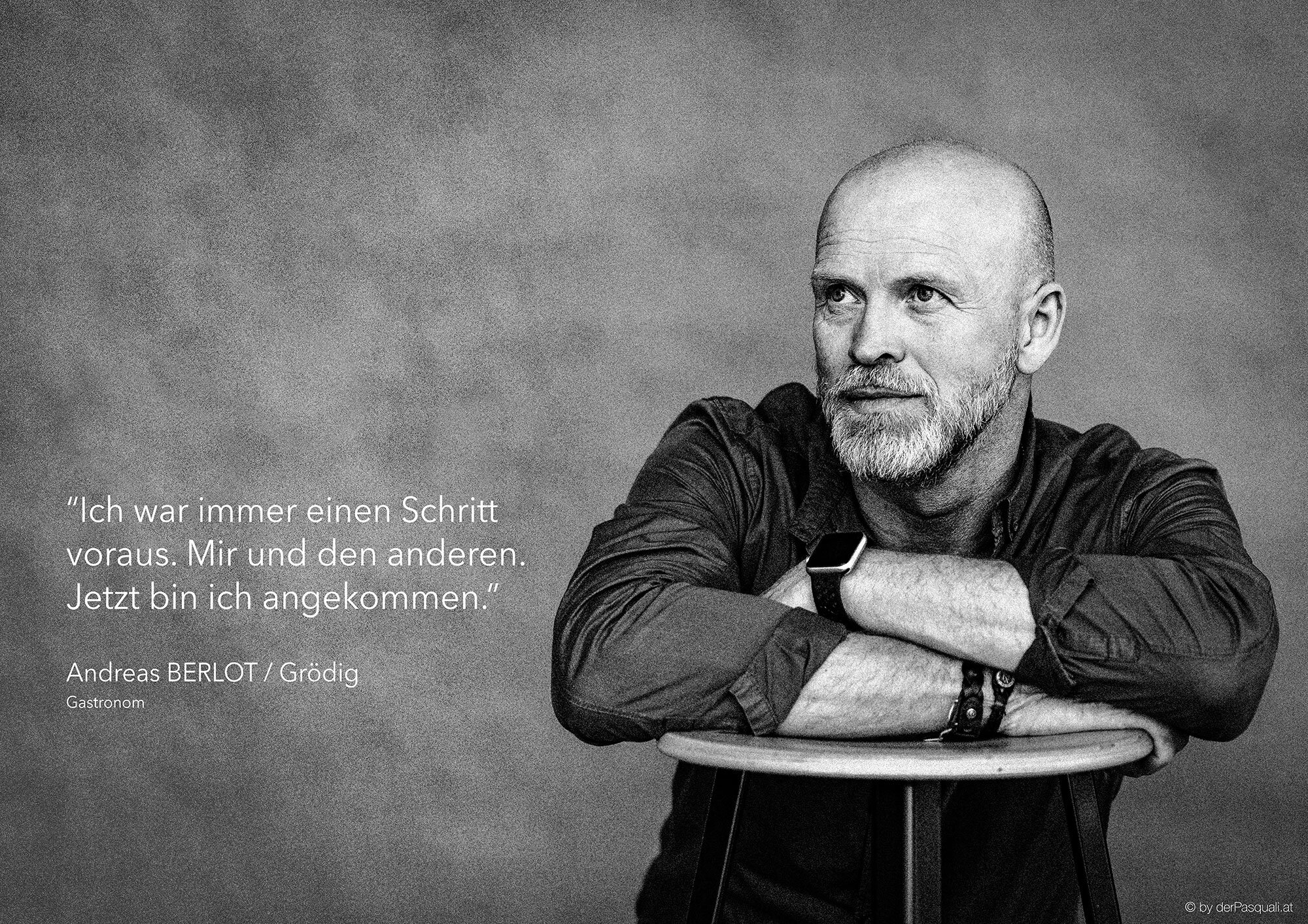
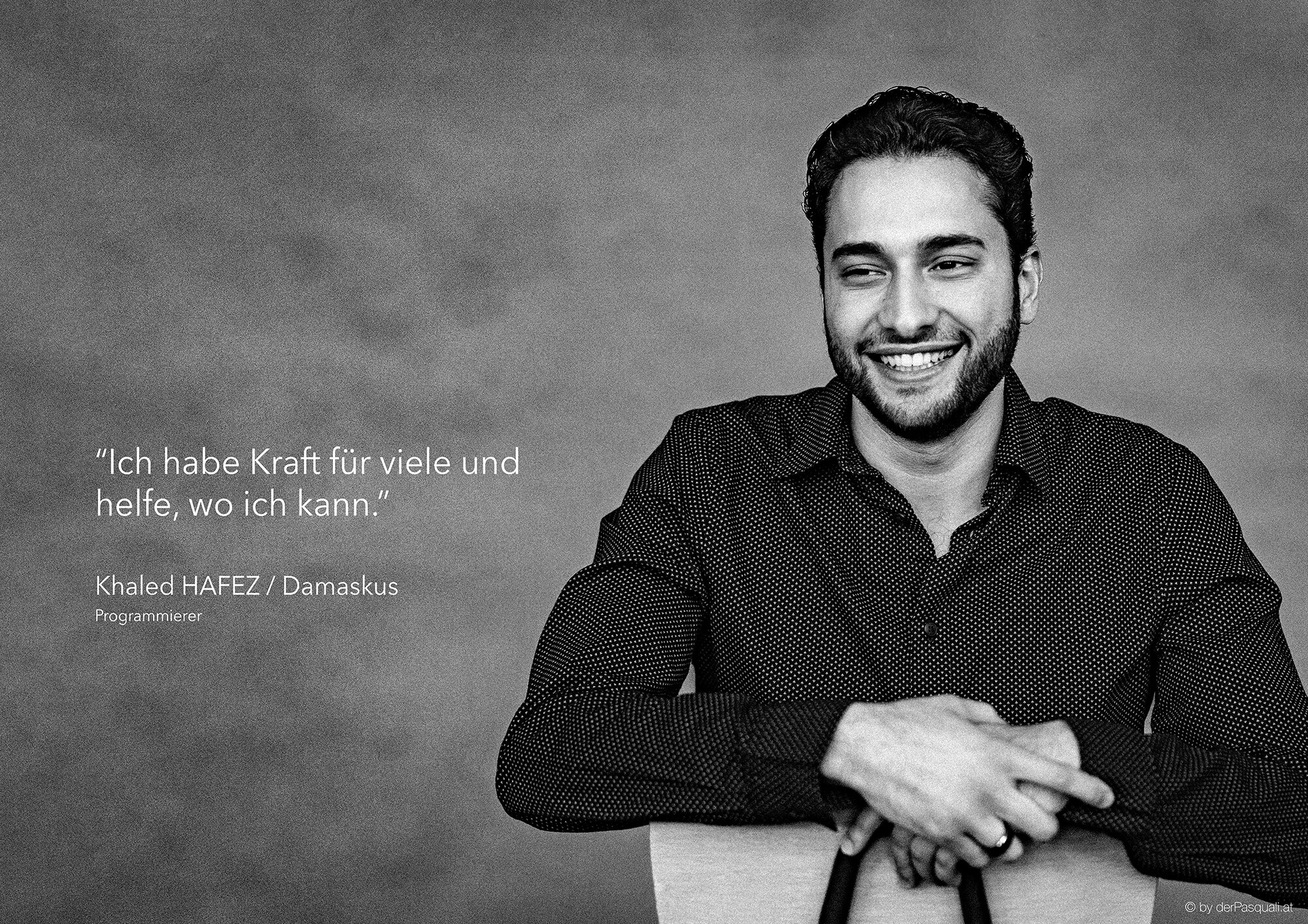
Brücken schlagen. Gratwandern.
Zwischen gestern und heute.
Wer bin ich?
In meinen Augen und in den Augen der anderen?
Wie verwandelt dein Blick auf mich das Bild, das ich von mir habe?
Wo beginne ich? Und wo ende ich?
Bin ich die Antwort schuldig oder mehr die Frage?
Der Weg, den ich gehe, wird erst sichtbar, wenn ich mich umdrehe.
Durch die Spur, die ich hinterlasse und die ich nicht mehr bin.
Endlich siehst du mich da, von wo ich dich sehe.
Visual Harvest
The wonderful Roswitha Schneider had an “eye” on us throughout the StoryCamp. And she did a phantastic job capturing the different moments, settings and the emergent quality of our time together. Enjoy!
Feedback for the StoryCamp
This year we took the chance to capture some voices and collect feedback for the StoryCamp in Lingenau. In a short questionnaire, we asked our participants to describe the event in a few words. We are touched and moved by what they had to say, but read for yourself:
Das StoryCamp war für mich persönlich nicht nur sehr lehrreich, es war verblüffend … Eine ganz neue Erfahrung mit vielen neuen Perspektiven, wertvollen Erfahrungen und unglaublich tollen Geschichten vieler wunderbaren Menschen. Dass dieses schöne Format vor meiner Haustüre stattgefunden hat, macht mich auch ein bisschen stolz!
Sarah Preuß
The StoryCamp gave me the chance to connect with likeminded people from all over the world, tell stories together, listen to theirs, expand my curiosity and discover a wonderful village full of great storytellers and magic places. I'll keep a lot of great memories and magic moments in my heart.
Ingo Angres
Wärme und Wohlbefinden. Begegnung und inspirierender Austausch. Lernen und Entwicklung. Es war zauberhaft!
Martina Eisendle
Das BST-StoryCamp öffnet seine Manege zwischen Chaos und Ordnung, dort wo sich bekanntlich die besten Ideen, schönsten Gespräche und ergreifendsten Erfahrungen finden. Ein erfrischendes Format voller inspirierender Persönlichkeiten.
Semih Morel
Ich kam als Fremde, die bis dahin nicht mit der Storytelling-Szene im Unternehmensumfeld vertraut war und ging als reich beschenkte Frau, die in allen Lebensbereichen durch dieses Camp und alle seine Teilnehmenden gewonnen hat. Besonders der offene und authentische Erfahrungsaustausch, die Menschen und ihre persönlichen Geschichten, hinterlassen bei mir einen warmes Gefühl der Fülle und eines zauberhaften Punktes der Übereinkunft.
Karin Hinterleitner
Das StoryCamp in Lingenau war für mich eine sehr bereichernde Erfahrung. Wegen der inspirierenden Teilnehmer, der offenen Diskussionskultur in den einzelnen Sessions und dem unkonventionellen Tagungsort inmitten des Bregenzerwaldes.
Friederike Hehle
Bereits die Anfahrt mit Christine war interessant und geistig anregend. Ich traf in Lingenau eine offene, kollegiale Stimmung, mit Möglichkeiten zum Rückzug oder um sich je nach Bedürfnis zu engagieren.
Meine anfänglichen Befürchtungen bezüglich Kontaktschwierigkeiten verblassten sehr schnell und liessen meine Neugier spriessen.
Fredy Schwyter
Es fühlte sich an wie eine große, kreative Blase, in der wir uns die vier Tage über befanden. Viele Inputs, schöne Gespräche und wertvolle Gedankenanstöße!
Katrin Preuss
A unique format with the following ingredients
* a rather small group of people (40)
* being together for in total 3 days
* beautifully framed by the facilitation of the BST Core Team
* made unique by the contributions of ALL particiapants during the session * the marvellous village Lingenau with all onsite places and people being a powerful Co-Facilitator
Susanne Conrad
Die Veranstaltungen von Beyondstorytelling sind für mich gesetzt. Es gibt eine Geling-, Lern- und Erlebnisgarantie. Man geht reich beschenkt aus den Konferenzen. Neue Methoden, mehr Wissen, spannende Kontakte und das ganze mit einer freudvollen Leichtigkeit. Fühlt sich nicht an wie eine Konferenz, sondern eher wie Urlaub.
Karin Kiesl
Ich habe selten bei einer Veranstaltung soviel mitgeschrieben, wie in diesen drei Tagen. Es war eine sehr dichte, intensive Zeit mit interessanten Menschen, die viel zu sagen und einzubringen hatten. Und ich bin mit dem Gefühl heimgekehrt, so viel mehr vom BST Camp mitgenommen zu haben, als ich selbst beitragen konnte.
Thomas Lutz
The experience of a real passionate and inspiring sharing community that helped to grow ideas, open perspectives and seed new thoughts.
Barbara Hunter-Lemke
StoryCamp Lingenau? Eine Heldenreise! Abtauchen ins Unbekannte, im Bedeutungsgewebe verloren gehen, Verbündete finden, das eigene Narrativ de- und erfolgreich wieder rekonstruieren, das Elixier finden und Rückkehr in die "normale" Welt – aber mit verwandelten Augen, Sinnen und Werten.
Patrick Kappeler
Around Pentecost I was very shaken by the awareness of the amount of change that was coming. In our lives, in our communities, in our immediate environment. I asked myself what role storytelling should play when so much can collapse. In the story camp I found traces in which I can set my steps and people with whom I can walk hand in hand. The future is today. It needs tribes, trust, connection, courage, rebellion, good questions, values, closure and openness on which everything is based, both at work and in private life. My "one-word story", with which I will continue to work from now on, is: Symbiotism.
Astrid Nierhoff
It's hard to capture in word something that engages the whole person, not just the mind. We have created a community in which co-creation happens effortlessly, inspiration flows and every story finds its place.
Katarina Veselko
Sometimes
you enter a space
meant to transform you
Kerstin Gollembiewski
A room full of ideas and inspirations that connect and become something bigger
Melina Garibyan
The StoryCamp was the most inspiring event of the year for me. Within the circus everybody could create their own theme-session resulted in interesting input and outcome. Everybody brought their creative souls, open mind and heart.
Carla Wijbrandts
Geschichten die be-geistern: Podcast Serie aus dem StoryCamp
Unsere lieben Kollegen Dani Rütimann und Patrick Kappeler von der Storytelling Akademie haben im Rahmen des StoryCamps Lingenau eine Reihe von Podcasts mit TeilnehmerInnen und Mitgliedern des BST Kernteams geführt. Die Podcasts decken unterschiedliche Themenschwerpunkte und Themenfelder ab und beleuchten so ein breites Spektrum des Arbeitens mit Geschichten und den narrativen Denkens.
Hier die bisherigen Podcasts vom StoryCamp in Lingenau:
Patrick Kappeler, Mitbegründer der Storytelling Akademie, traf sich heute mit der Psychologin Christine Erlach, die zu den Pionieren der Narrativen Arbeit im deutschsprachigen Raum gehört.
Christine Erlach hebt verborgene Wissensschätze, Werte und Haltungen und macht sie für Organisationen konkret nutzbar....
Wolfgang Tonninger sieht das Narrative als eine Brücke zwischen Kreation und Beratung. Aber auch als dialogische Grundhaltung, die ihn in seiner Arbeit mit Menschen und Organisationen begleitet.
Was das in seinem Alltag bedeutet, erzählt er uns im Aha! Podcast.
L'heure bleue an der wildromantischen Subersach! Patrick traf sich mit dem Organisationsberater, Coach und Facilitator Jacques Chlopczyk an der alten Bahnstation Lingenau und sprach mit ihm über die Entwicklung neuer Narrative und Metaphern für eine nachhaltige Zukunft.
Wohl- statt Wertschöpfung war das Schlagwort...
Ying Zhou inspiriert Menschen dazu, ihr individuelle Einzigartigkeit zu leben und ihr ureigenes Talent zu entfalten. Sie ermutigt zu Kreativität und Zuversicht, die Herausforderungen des Lebens in Komponenten der eigenen Talentschmiede zu verwandeln. So wie Muskeln erst durch Gewichtstrainings wachsen, wächst der Mensch erst an seinen Herausforderungen.
Heute sprach ich mit der StoryWorkerin und Prozessbegleiterin Steph K. Bachmair über das kleine "Opfer" welches alle Storyteller auf dem Altar der Verletzlichkeit erbringen müssen, um genuin Geschichten erzählen zu können, die Menschen berühren.
Ob auch Führungspersönlichkeiten in ihrer Rolle als Führer verletzlich sein müssen? Die Antwort findet ihr im Podcast.
Last but not least! Unsere letzte Perle aus dem StoryCamp Lingenau 2019!
Heute sprach ich mit Joanna Sell, Intercultural Narrative Coach, Trainer und Facilitator über die Faszination interkultureller Narrative und wieso ein einziges Wort manchmal eine ganze Geschichte beherbergen kann.
Wie sich Führungspersonen, Manager und Kommunikatoren in unbekannten Universen orientieren, bewegen und kommunizieren können, verrät dir unser letzter StoryCamp 2019 Aha-Podcast.
Die Podcasts der Storytelling Akademie werden hier veröffentlicht. Reinhören und folgen ;-).
We are human - a problem to be solved or a treasure to be sought?
Harvesting and reflection of the session Rehumanizing work in BST 2019: Storycamp Lingenau.
Permission to be human
I am grateful to have found a home in this community of storytellers, storylisteners, storyworkers, storycollectors, storyplayers and storybeings. I came to Storycamp Lingenau with my mind, heart, hands and eyes wide open. Motherhood has taught me not to get too attached to my expectations – and so all that was left was a childlike curiosity. In previous years in the BST 2017 and BST 2018 I have already recognized that this is my tribe. I belong here. That much was clear.
But my »I« had expanded. Both my baby daughter and my mother came along to Lingenau – and I wasn't at all sure how that would go. There was no schedule, no clarity, no plan. Just deep trust that if I belong here, we will make space for them, too. I shed my first tear on Day 1. I asked Wolfgang if my mother and daughter can join us for our common dinners, and he agreed immediately. »We can also sit somewhere separate if reservations have been made and the tables are set ...« I added apologetically. »Are you crazy?« he exclaimed. The idea of them not being fully welcome in our community seemed completely absurd to him – and that touched me. There was no question: there is space in this wonderful circus for me as a whole; not just my professional mind and contribution, but also me as a mother, as a daughter, as a human being.
How often does it happen that a business conference offers the opportunity to accept humans as they are? To talk about not having been able to sleep at night and jumping into the river at 6 am? To dance through the village? To stay true to our bodies, hearts and souls while tending to our minds? Where we can show up as we are, without the need to make an impression, where our story is appreciated and received openly, where we can be held?
How did we end up in a place where such experiences are so painfully rare? How come in a world inhabited by human beings (and human becomings), we have let ourselves be redefined as human doings?
More questions than answers
I proposed a session in the first day on re-humanizing work. I am called by transforming our workplaces from places that so often slowly drain our life out of us into places of creation where we can flourish and feel truly alive. In the session, we came up with more questions than answers.
What is a »human« organization? What makes a culture human? What do we need from the organization to be truly and fully ourselves? What makes a safe space?
What do we need to feel truly ourselves? How do we avoid living up to a different set of values as soon as we put our business attire on? How do we stay true to our values in an environment that feels hostile? How can an organization support personal growth and development of each individual, knowing we have different needs and interests?
What stands in our way? How can an organization be human if it needs to be pragmatic? How can organizations profit from personal fulfillment of employees? How do we »sell« the idea of »human work« to the decision makers, if profit is the main motivation? What are we afraid of? Who sets the rules of who we're supposed to be?
Is there a line? Is there such a thing as »too human«? How do we keep boundaries in a more human environment? And if we manage to create a safe container while we're working with the teams, what happens when we're gone and they drift back into old patterns?
More questions than answers; a harvest from the session.
And what role does story play in all of this?
Dehumanization is destoryfication
If humans are storytelling animals, it seems obvious that a human organization would deal with stories the humans bring into it. Brené Brown says »Stories are data with a soul.« And people without stories are just data – numbers. Re-humanization is the process that reverses the damage done by dehumanization. Dehumanization means that we see and treat people as something other than human: numbers, problems, machines, working animals, ...
Even the term we use for the people who are supposed to care for the employees – human resources management – invites dehumanization. Using people as a resource, thinking of them as a resource, is a powerful metaphor. Resources are precious, but they are something we can use up, exploit, run out of, consume. It's something that is valuable because a benefit is produced from it. »Human resources management« is a story in which humans are not a protagonist. In a human organization, humans would be not only protagonists of the story, but also its authors. Their value lies in the stories they create and live, and their worthiness is a given.
Dehumanization practices at work strip people of their story. We are expected to behave like machines: highly effective, unquestionably obedient, unbiased by context and emotion, indefatigable, infallible. Anything that is not contributing to the benefits we are supposed to produce, is considered a flaw or a disturbance. This is the sea we swim in. Even though emotional intelligence, life-long learning, work-life balance and other topics that imply that we are nevertheless not machines, are becoming buzzwords, the underlying hypothesis stays – the fact that humans are human is a problem to be solved not a treasure to be sought.
The treasure of humanity
Humans are not perfect. We live in stories, and the stories do often get in the way of getting things done. And yet, stripped of stories we lose our meaning. Meaningless work, doing things that are not aligned with out values, being treated as if we don't matter – all these things contribute to burnout, sickness and stress. We all need to feel valued and worthy to be able to contribute in a meaningful way. Future work skills are the competencies computers do not have – they are about communication, sense-making, understanding and co-creating stories, collaboration, trust. Only humans can read between the lines and capture meaning from data. We need our humanity to navigate the complex world we live in. We did not need to be persuaded; we know our humanity is essential to our most treasured contributions. We only spent a short time talking about why we need our organizations to be more human: to enhance engagement through “Glűck und Sinn”, to foster cooperation and trust, to move on from failure better, to reduce sickness, stress, absenteeism and fluctuation, to support natural human creativity, to free us from roles and expectations and make space for change, growth and innovation … So we know only humans can do these things; and only if they can tap into their human potential. But what is human? When do we feel human? When do we feel alive?
What is human
After much thought and a little bit of research, I believe two general practices come up at work that dehumanize us – denying our needs and partialization. Whenever our basic human needs are denied, that dehumanizes us. Whenever any of our inseparable parts needs to stay out of the picture, that dehumanizes us.
Firstly, to feel human, we need to have our needs met. There is a multiplicity of human needs theories, but most of them agree on the basics. We need to tend to our bodies with enough food, drink and rest. We need to be and feel safe and secure, both physically (our bodies will not be harmed) and emotionally (our hearts will not be harmed). We need relationships, to feel like we belong and are loved, appreciated and connected to other humans. We need to feel we are competent, successful at what we do and that we are growing, learning and getting better. We need to feel we have some autonomy and control over our lives and our decisions. And finally, we need to feel like we are contributing something, that we are true to what we believe in, that we are a part of something bigger than us. At work, it is common that even the most basic needs are put on a tight schedule, if not denied completely; relationships are shallow and transactional; our competence goes unacknowledged; our autonomy is severely limited; and we don't fully see the sense of what we do. All of that dehumanizes us.
And secondly, to feel human, we need to be acknowledged as a whole. Not only our minds come to work, but so do our bodies, our hearts and our souls. Our identities are informed by what we think and do (which are usually welcome in business environments), and also by what we feel (sensations and emotions) and who or what we connect to (our environment, context or system we come from and also our spiritual beliefs and experiences). At work, our minds are welcome, and some functions of our body – the ones that can produce what our employer needs from us. All the rest is often seen as superfluous or even problematic. Integration and wholesomeness also means space for the polarities, or better, shades of gray between the good and the bad, the light and the dark, the done and the developing, the achievements and the failures. In short, it means no part of us needs to stay hidden when we enter the office (because we all know that checking it at the door is not a real option).
We all lose, and yet ...
Let us not forget that organizations are made out of humans. All of us are human, from the top management in their suits and ties (and hopefully more and more dresses and skirts, too) to the workers in their dirty overalls. And all of us are losing in the system which does not let our whole selves to show up at work. The leaders are also not allowed to be whole – to show vulnerability, to make mistakes, to feel. It might be that more of their needs are met, but can they truly be alive in their role? Can they bring the multiplicity of their stories into the workplace? My guess is – no, most probably not. They may live a narrative of a successful leader, but that is often heavily influenced by the ocean of taken-for-granted beliefs than make the story thin and one-dimensional[1].
So how does this happen? In another session (the one in which we realized we want to dance with the Earth not all over it) we realized that a system persist because a system is stronger than an individual. Yet, a collective is stronger than the system. A collective can form a new narrative and re-author the future. It can transform a system through writing and living a better story. But we cannot create a collective if we don't have permission to show up, be seen and connect. So we're in a vicious cycle.
What are we afraid of?
But why? Why can't we just be human with one another, share our stories, realize we're all the same and better together and just work from there?
Well, it's not that simple. We can never know what it is like to be the other person. We cannot feel their pain or their joy. So it is easy to consider them separate, even lesser than we are. Emphatic story-listening is as close as we get to understanding what it feels like to be another human being. But empathy is always a choice, and it's a brave and vulnerable choice. We need to allow ourselves to open up to be able to do that.
Pandora’s box. From clipart-library.com.
Both dehumanizing practices that I described above have an underlying topic ... Humans are essentially vulnerable. We are not bulletproof, not all of our parts are great and solid, we are quite easily hurt and we are high maintenance beings. The organizations realize that – and tried to outsmart vulnerability. Engineer it out of the process to eliminate human error. Our brain was developed in a time when vulnerability was deadly and it still didn't quite get used to the idea that not everything and everyone in the world is a danger. So I'm guessing what we're afraid of is – death.
Not literally anymore, obviously, but our brain doesn't know that! The stories our brain is mainly invested in answer the questions »Who is a friend, who is an enemy, who is food and who am I food for?«. Lately in our society we come down to »What should we fear?« and »Who should we blame?«[2]. These have such an urgency that we cannot afford to form an alternative narrative until we feel safe enough. We fear our vulnerability and the vulnerability of others will endanger us, like it did when we still lived in caves. I remember being in a meeting with a client and suggesting a story-sharing exercise, and the management froze. »But what if they cry?« That was their concern. That a team member might cry, and then all shit would break loose and the Pandora's box would open and who knows might come out?!
The answer to the title question is: we don't know what we're afraid of – and that makes it so much scarier!
Circle of safety
Human organizations should offer us a circle of safety[3]. A circle of safety means that whatever happens, we will take care of each other and we will be taken care of. If we have a safety net, we can try out almost anything. Like my baby daughter wandered around and explored the world of our storycamp, because she knew that mommy is somewhere around, the other people are safe, and she can always come back. It's the same with us. Courage is a function of groups. We need to form safe spaces for the people at work where they can share their stories so that they can explore the multiplicity of who they are and what they can contribute.
Inspired by Simon Sinek, Leaders eat last. Authors own image.
A lot of our conversation in the session revolved around that. How do we do it? How do we as facilitators create microspaces that enable connections and invite alternative narratives and deeper, fuller, wholehearted stories? And what happens when we leave? How do we offer these spaces on a structural macro level in organizations? And bigger, how to we make organizations as a whole a safe space to be human?
We gathered a few ideas: creating shared rituals, where people come together regularly; offer common spaces where people can meet; in research and reports use the language of the people; foster playfulness and humor; normalize questioning and checking assumptions; introduce “check-in” in the beginning of a meeting or a working day; change the questions we ask to invite alternative narratives (i. e. “What excites you today?” instead of “How are you today?”) … These are just bits and pieces, drops of ideas that we shared with each other. It remains a field to explore - and yet one thing became clear to us. Story-sharing can become key in this practices.
Even the smallest place where one can feel safe can offer a huge relief. Having one relationship at work in which one can put down the armor and share their story with an nonjudgemental, deeply listening other, might be all one needs to survive in an otherwise hostile environment.
But we as story-workers want to dream bigger. We want to revolutionize work. Create a better world and better lives for people by eliminating the need for armor in places where we spend about a half of our awake time. By creating a new paradigm that might some day grow into the dominant narrative – a human organization.
The dream – a framework of a rehumanized organization
Surprisingly, the 120 minutes of the session did not suffice to solve the problem. Unfortunately, despite our heartfelt discussion and the multiplicity of experience we brought into it, we did not save humanity just yet. But we have started dreaming, and I hope we will continue.
What are the elements of our new story? What is the future of organizations, of leadership, of workers? How can we model a human organization, so it can be operationalized, measured, observed, taught, learned and practiced? We are not quite sure yet, but a spark has landed. We are not the only people carrying these questions. This is how one spirals out of a vicious cycle – by infecting more and more people with the new story. The system might be more powerful than an individual, but the collective is always more powerful than the system.
And so our hopes are high, and we extend an invitation. If each of us just held the space for one person at work, in which their needs can be met and their whole self seen... Just one. One can never know, what story might spark a revolution.
[1] The vocabulary of »thin story« and the ocean of taken for granted belief I borrow from Chené Swart, Re-authoring the world.
[2] The questions come up in Brené Brown's work around vulnerability and courage; i.e. Daring Greatly.
[3] See Simon Sinek, Leaders eat last.
Invitations to dance
The story of poetry, the poetry of stories
Sometimes
you enter a space
meant to transform you.Kerstin Gollembiewski
Lingenau is a poetic village. It invites the quick and messy scribbles of pencil on paper, trying to capture the moment's inspiration. Poems flutter around our heads and hearts like birds, and from time to time one loses a feather – a one-word story, a metaphor, a word play, a rhyme. Here and there, one of these feathers lands in the lap of a circus artist. And then, if we're lucky, the artist freezes the idea in writing, to share it with the rest.
Sometimes, it's just a distant memory of a lyrical story that's touched us once before, and we search through our mind (and sometimes the »world wide web« – now isn't that a wonderful phrase, too? The World Wide Web?) to find the words that had been said before. And sometimes, the verses fly away again to find another heart to land in.
These are some of the ones we've managed to capture and share.
Photo by Yannis Angelis
An emergence of the following poem by Stephanie Bachmair:
‚what makes noise noise and music music?
when meditation dances with prayer
gendarmes with villains
and the priest with fallen-in-love’ ones
then we moved
in the good direction
A playful, yet powerful invitation. It is a poem by Hafiz that came up in a session on poetry suggested by Barbara Hunter-Lemke. The image of a full table at a party, where there is enough for everyone, if everyone brings a little something, became a metaphor for our co-creation, for the space in which all of us can give and take, and the abundance of our gifts.
At This Party
I don’t want to be the only one here
Telling all the secrets –Filling up all the bowls at this party,
Taking all the laughs.I would like you
To start putting things on the table
That can also feed the soul
The way I do.That way
We can inviteA hell of a lot more
Friends.By Hafiz
With the table full, deep conversations sparking and friendships beginning to form, our stories begin to flow. The people here are special, because they listen. Really listen. Not just wait for their turn to talk, but stop and step into your story for a while. Walk with you. Let you enter their world as they enter yours. This poem was shared my Yannis in a big circle at the end of Day 2. It's a beautiful short story, written by Nayyirah Waheed.
Sharing stories, we expand. There are no borders, we flow out and embrace freedom of being endless, disrupting the order. Like a coffee stain.
This is a poem Stephi read in a big circle … It’s the only poem in German I’m sharing here, and we wouldn’t want it to be lost in translation. So here it is, exactly how it landed on paper in the moment of emergence.
Der Kaffeefleck by Stephanie Bachmair
I love how sometimes, poetic just sparks into life from throwing words into the air and catching them while they fall. This is how the following poem came to be: it originated in exploring the question of bringing together a multicultural team. Jacques, Stephi and I were walking up a narrow way through the woods on a hillside above Lingenau, freely associating. Just before we reached our next bench, Jacques managed to grasp some of the words we've been tossing around, and let them land in his notebook. (Jacques’ original can be found here)
Dancing on barbed wire
Mending broken things –
The grace of healingJacques Chlopczyk / Stephanie Bachmair / Katarina Veselko / Lingenau
I believe what enables such wonderful creations to come to life so effortlessly is the community. StoryCamp, to me, more than anything, is a community of people dedicated to listening deeply to capture the untold and letting stories emerge, and brave enough to take the quill in their own hand and write the stories we wish to live. And for that, we need to feel like we belong somewhere. In the final round, I said the treasure I found was being held. A circle of hands.
Photo by Andreas Liebhart
COMMUNITY
We are all longing to go home to some place
we have never been—a place half-remembered and half-envisioned
we can only catch glimpses of from time to time.Community.
Somewhere, there are people
to whom we can speak with passion
without having the words catch in our throats.
Somewhere a circle of hands will open to receive us,
eyes will light up as we enter, voices will celebrate
with us
whenever we come into our own power.Community means strength that joins us our strength
to do the work that needs to be done.Arms to hold us when we falter.
A circle of healing. A circle of friends.
Someplace where
we can be free.by Starhawk
We have a community. We have the strength do to what needs to be done. And now, the Call, shared by Yannis in our final round. To gather up our gifts and treasures and go do something. Change. Transform. Grow. And take the world along.
Did you get the call?
Did you get the call? I did.
Did you hear your name in the middle of the night?
That voice egging you on, nudging you to awaken.
The silent alarm vibrating through your heart,
bursting your confusion, this nameless knowing.
This tumult of soul seeking truths
Are there words for this disposition?
Come out, add to the dialog this hiding no longer suits you.
You’re on the brink of transformation
and you need to jump in or defy gravity,
and float into the collective of indie souls.
Or, into the cast of nameless and unidentified
seekers of change, your new family.
So go out.
Be the change.
By doing, sharing, creating.
Walk the walk and talk the talk in your gifted way, your language.
Paint the story, write the story, sing, dance, play the story.
Pass it on, teach it, grow it, word by word, by mouth.
Be the person you want to be.
Be the person you need to be.
Take your hat off.
Sit down and journal this pause.
Put on sneakers, grab a towel, and run this moment.
Pick up your mat, find space, and meditate this moment.
But however you do what you do, carry someone with you, forward.
Talk to them, touch them, share fears, share joys, speak ideas.
Collectively we cannot effect change by only watching.
We are the town criers.by DelRita Butler
We are now home. Back to our ordinary world, carrying all the treasures. One story ends here. And yet, we have received this call. We answered it with a passionate »yes«. A call to a new adventure. A bigger one, maybe. To change the world through stories, as some have humbly shared in our innitial burning questions. The world is reaching its hand out, inviting us to dance. So let's dance.
We are dancers
What is dance
if not touching the world in a new way
if not letting yourself be moved by another
if not listening to what your body has to sayWhat is circus
if not a collection of mistfits and freaks
if not finding a like-hearted brother
if not turning a flaw into the treasure one seeksWhat is story
if not hearing the whispers between words
if not the shortest distance to the other
if not gently voicing the unheardWhat is Earth
if not humanity's most precious chance
if not the passion of a Wild Red Mother
if not an intimate invitation to danceWho are we
if not a flock of whirling dancers
weaving stories with each other
exploring questions with no answerby Katarina Veselko
*Title photo copyright Roswitha Schneider. Thanks to everyone who contributed the poems and photos used in this post.
New Beginnings
This text is courtesy of Cristina Correa. It´s her story. We are happy to share it.
Eclipse
When I arrive home after BST Storycamp Ligenau 2019, my hometown Santiago was possessed by the eclipse madness. The second of July the moon covered the sun almost completely and we could see it with paperboard sunglasses. Eclipses were messages of the gods for some ancient cultures, bringing good or bad auguries. In astrology they are symbols of openings and closure. That is my feeling after this few extraordinary days in Lingenau. Something is completely changed and still the same about myself.
In that bucolic scenery at the foot of the Alps, I became part of a nomad tribe of jugglers and It felt like home. We were creating, in an open format, our way to fall in love with stories. We did that in many different sessions ranging from questions around politics, organizational change to questions concerned with the very foundations of what stories are.
The session that perhaps had more impact in my future was about how to enter in a world/story.
How to enter a story?
Wolfgang Tonninger was in charge of leading this quest, that at the end resulted in a quest for a very fresh beginnings for my self-fiction novel. We started with an article about the Californian wildfire that destroyed the settlement called Paradise. A tragedy that turned the settlement into ashes.
And the journalist made quite an entrance, literarily speaking, showing us the image of a man rescuing from the ruins a jewel of his wife. This indian firestone survived, while gold was melted. In just three paragraphs he caught our attention with a metaphor of religious imagery and the foundation of this city, built at the beginning of gold fever in that region decades ago.
Entering a story must be a sensual/essential thing, we all agreed. Then we started to share stories that we thought can be useful for this amusing exercise, and we speed up into a perfect circle in which everyone could participate (wich). That was for me the most precious jewel of my Journey in BST19 Storycamp Lingenau.
Re-writing the beginnings of a novel
At start I gave them some cues about the story. In the opposite of pitching, I just threw separated facts into the air. Instantly, the magic of storytelling did its job. My new german speaking friends were totally hooked up, making this story their own.
The novel centers around a woman in the search for her grand dad that fled the country as his sexual orientation was revealed, being gay in socio-political context in which there was no space for it, becoming a cheerished cook and an esteemed entrepreneur. The woman herself has just broken up with her boyfriend at that time. Searching for the traces of her uncle and a new beginning for herself, she reveals different aspects of her family story.
What is wonderful about these openings is that you don’t need to see the whole picture. You can feel the gaps just reading these different beginnings. This are some of the images that I will always treasure in my heart:
1. She is back from Pucallpa, Perú. She goes to bar and sees his boyfriend, chatting and drinking with a male friend. From thi very moment, she realizes he is gay.
2. Rudy is smoking, and the way he is sustaining this cigarette is kind of delicate, almost feminin. He presses the remains in an ashtray. Now she knows. From this moment, she revisits many other moments in his relationship and she thinks about what she never wanted to see…
3. What I did not know in the moment I was throwing my clothes into my backpack in this shabby hut in the jungle in Perú was that my grandfather did the same in that very day 55 years ago. He was not at Perú but in Santiago it was early morning, just after the military was marching in the streets once again and the political tension was rising. Even if my grandfather was using the political turmoil to enter Argentina as a political refugee, it was not the reason why he disappeared from the life and stories of my family. Last night, after another sad fight with Paolo I decided to head back for the south.
4. Impenetrable darkness. She listens absolute silence in the middle of a rainforest. The sensation of being lost. She want order in her life, but she had chosen poorly, throwing herself into the chaos of this silent jungle.
5. Shots are heard, there are soldiers in the streets. At the same moment a door knocking is heard and a woman yelling: "¡Jorge, open the door!".
6. Burned photographs of the family leads the main character to this one photo of his former boyfriend.
7. She meets the lover of her grandfather at a bar. They have an interview in wich none of them feels like talking.
8. Conversation with her grandpa. After a chapter about this encounter, she says: well, that never really happened.
9 .Does every journey needs a destination? Does a family needs its secret story? She is in the train looking at her own reflection in the window.
I can't reproduce all beginnings here in full length, but what is important to me as a writer, was how much different viewpoints and different ways of entering this story sets the stage for what comes next. The freedom to experiment with different approaches to set the scene.
For all our new fresh starts, we will never lose the thread. Now is my turn to take this inspiration further in the rewriting of my first novel story. Thank you Lingenauers!
Link to the Zeit article (paywall): https://www.zeit.de/2019/24/kalifornien-waldbraende-wetterextreme-zerstoerung-wiederaufbau-paradise
Versailles | Attorneys of maneuverability
Picture Credit: Andreas Liebhart
Versailles
The word came to me from a podcast I listened to on my way to the StoryCamp in Lingenau. In the podcast, three historians discussed the peace treaty negotiated in 1919 in Paris, ending what is commonly referred to as the first world war. The discussion centered on the parts of the agreement and the circumstances around it that made it one of the root causes for conflicts throughout the 20st century.
What captures me about the word is that it is still used as a shorthand to refer to a very complex story: the historians named a few references in which the word “Versailles” was used to describes situations in which a country or a political power was forced in a situation that necessitates a strong response in terms of counter-aggression. A reaction that was forced through the terms of a forced agreement. Effectively situating the responsibility for the aggressive response with the parties involved with the forced agreement.
A few days after the camp, the word lingers around my mind as an example of what one could call a “one-word story”, a term inspired by my colleague Joanna Sell. One-word stories in my understanding are words that are so soaked with a particular narrative that they become a shorthand for a whole story.
One-word stories
Without having searched for different examples, the notion of one-word stories reminds me of a quote from Julien Rappaport:
„While some community narratives are quite direct, many well-known narratives are coded as visual images, as symbols, as stereotypes, and as performances of behaviour so ritualized that we may be unaware of the narratives we implicitly accept and enact, [...]. Underlying much of what we know, and can recall, are encoded stories indexed by certain cognitive handles. These indices are like headlines in a newspaper account. They are cues to the underlying story. They affect both the target and the source. Overlearned stereotypes primed by adjectives or coded words are the handles to underlying stories (Rappaport, 2000, S.5)
So, one-word stories are basically these handles for the underlying stories: stereotypes come in that form. Large battles take on a meaning that resound universal tales: Waterloo, Hastings, Stalingrad. Social dynamics are framed in that way: the wave of refugees and so on.
What strikes me is the power of these one-word stories to frame a complete discourse or dialogue with one word. A word that can tip the scale of dialogue in one way or another by situating the conversation in an engrained, widely shared, image-laden narrative.
What´s in a name?
During a walk at the Story Camp, I shared a story with an old friend. A story about how I am reluctant to give a name to a certain situation. I realized that this reluctance was keeping my mind busy and made me unstable in how to relate to that situation.
Naming a story is an important part of narrative therapy and re-authoring practices. Naming a thing is making it real. Giving substance and form to something that did not have a shape. From an unnamed feeling or perception, we discern a Gestalt.
Naming is an act of creation which entails all the references that make up the web of meanings leading from and to the name. By naming we summon the context to the stage that the story will unfold on (consciously or unconsciously – but that´s another story).
But giving a thing or a story a title or a name has more implications than that: it is an important part in a process to relate to that story. Naming is the singular step that can make the difference between living into a story and the decision to live into it. The distinction between a story you choose to tell and live and a story that tells you.
It puts the story outside of a person or a community and gives it a live on it´s own. A problem becomes a problem story - ready to be told differently. A solution becomes a solution story – ready to be lived into.
Melting and freezing: From cold to hot stories and back again
Naming a story might turn that story from a cold into a hot story. A cold story is a story that we unconsciously live into, a story that impacts the way we are in this world without having awareness of it. These stories might be rooted in our biography, in our society or the organization we are with.
Hot stories are stories that we are conscious of, stories in the making, stories in transformation (The distinction of hot and cold stories is borrowed from George Lakoff and Mark Johnson, probably inspired by Claude Lévy-Strauss` distinction between hot and cold societies).
We need cold stories and metaphors. We need to have structures of meaning that guide us through the world. As sign posts in the land of possibilities. That we can rely upon while thinking fast. That we can rely on in exploring the unknown.
Every transformation moves between cold and hot stories. It is about “unfreezing” (Kurt Lewin) the clay the story is made of and shape and relate to it in a different way. Warming it up to form something new.
Attorneys of maneuvrability
When I started this writing, I did not know where it will lead me. Posting it on the slack channel for the StoryCamp, I got some valuable impulses about how to continue. About the complexity of the distinction between hot and cold and between freezing and unfreezing.
I will borrow a term coined by Wolfgang Tonninger in his first reflection on the StoryCamp: as people concerned with transformation and change, we are attorneys of manoeuvrability. Our concern is and should be about the flow of the story and restoring the ability to maneuver, to act, to set one foot before the other, unearthing the potential to remove obstacles for development and new insights:
In some cases, this involves naming a story so it can be left behind, to heal and to move on. In some cases, it needs a re-naming of an all-to-familiar story, to find a different opening, a different meaning in it. Sometimes it needs a name for a story not yet written, to clear the path, to open doors into the unknown, to think, feel and act differently.
Being present with the process of naming, re-naming and un-naming is the work. Opening cracks, so that light can shine. Opening passages, opening doors. Story-Work.
Tasting the Water of the Subersach
When I arrived in LINGENAU one day before the camp started I was full of creative tension. A tension which was fueled by one nagging question: How light and enriching and – most important – loved will be the baby we have been carrying with us for about 9 months?
The Subers Ach is a super “Sach”
This was the day before the storycamp started. We were doing some final scouting, some attuning, talking, laughing, swimming, connecting and finally deep listening to the Subersach and the woods voices in the night and alone.
Dann der erste Tag. Schwimmen, Kaffee trinken, Zähne putzen am Fluss. Bevor es hinaufgeht ins Betriebsame. Flipcharts werden geschrieben. Wir kümmern uns um die letzten Details, die so wichtig sind. Kleinigkeiten überall, die es vielleicht ausmachen werden. Egon schaut vorbei, der Hausherr. Und seine Frau, die Elsa, bringt noch ein paar Blumen für die Fensterbänke im Engel. Isabella und Sabrina und all die Heinzelweibchen. Our plenary room starts blooming. As you can see I like to switch languages since LINGENAU – continuously reflecting how meaning is made and celebrating the slowdown which comes along with. This is the one side. On the other side I started to acknowledge the translator in me who is discovering new traces to hit the point – playing with connotations and backstories. Storycamping for me turned out to be the embracing of detours – even when translating.
3pm. Registration. People are arriving. 4pm. The beginning and us finally jumping into the water. Welcome. Willkommen in Lingenau. Bienvenido en este pueblo de cuentas. I am overwhelmed how the narrative community is ignoring borders, continents. Can you see our baby? My name is Wolfgang. Wulfgäng. I will re-invent myself in front of you. Transforming into a treasure hunter, a collector of things which make my heart beat faster. Are you ready? To perform yourself through stories? To go beyond your expectations? To embrace the richness in this circus like camp and build on it? To connect? To transform as well?
“Story is a thing that does rather than a things that is.” Bryan Boyd
My beloved John Berger comes to my mind when I look at all the narrative explorers gathering in this room. And “the motorbike with its headlight zigzags up the mountain. From time to time it disappears behind escarpments and rocks and all the while it is climbing and becoming smaller. Now its light is flickering like the flame of a small votive candle against an immense face of stone. For him it’s different. He is burrowing through the darkness like a mole through the earth, the beam of his light boring the tunnel and the tunnel twisting as the road turns to avoid boulders and to climb. When he turns his head to glance back — as he has just done — there is nothing except his taillight and an immense darkness.”
Ich sehe die Lichtkegeln, die in der Nacht tanzen. Und höre die Musik von Puma und Hanno. Den Schmetterlingssong, der meine Hymne wird für diese Tage. Wir sind angekommen. Irgendwie. Bunt zusammengewürfelt auf einer Terrasse ohne Ufer. Atmende Silhouetten. Im Licht der Erzählung herausgeschält aus der Dunkelheit, die uns umgibt. Die Grenzen verschwimmen. Alles ist Zirkus. Alles ist angerichtet für die Überschreitung, die wir wagen.
Neuer Tag. Ich erwache am Fluss. Und nehme seinen Rhythmus auf, bevor ich ins Camp wechsle. Marketplace of ideas. Welche Fülle? Wieviel Ordnung in diesem Chaos? Es scheint zu gelingen. Wir öffnen uns hinein in Räume, die aus Dialog gebaut sind. We are opening ourselves into spaces built out of dialogue. Alles auf Augenhöhe. The butterfly is guiding us. Hear! and now. Ich lob den Tag, bevor es Abend ist. Schnitt.
“I like escalators because they never break, they can only become stairs.” Mitch Hedberg
The circus is moving (even my car is moving by itself!) as we are moved. And so many treasures on our way. The woman who jumps out of her garden and tells her story when the story bench is not working. The cautious sharing of moments. The holding space. The laughing together. The giggling corners. The bonfire whispering. The various beginnings. The door openings into the possibility land. Like the wife finding her husband with his young lover, or the empty room of the grandfather in Santiago de Chile 1972 with the sound of a marching mass as background, the girl jumping over the brick wall to attend her gym class, or the lost woman in the Peruvian rainforest: “Suddenly, I was totally lost. The path I was heading for the last hours disappeared. The jungle around me seemed impenetrable. And – what staggered me – it was a jungle without sounds. It was like the rainforest around me took a deep breath in this very moment.” Doors. Possibilities. Inadequacies. Misfits. Matchings. All over. The knots of a network of meanings I discover with my complices around the table.
Suddenly, I hear the word coincidence three times in a row. Coincidences? No! Yes! We are there. The world is opening. Secrets all over. Secret connections. Our stories are transforming coincidences into forks. Thats it. Deciding if the train heads to Rome or Paris. And bridging fragile meanings. Story as a bridge? Like the one from Negrelli down at the Subersach? A bridge which is hanging and carrying itself at the same time? I feel close to this bridge. Also because of its simplicity. And its cinemascopic openings in its middle. Windows from where the reality seems looking at me. Von wo sehe ich mich? Als eine sich selbst tragende Hängebrücke.
What do I wanna talk about?
Podcasting at the riverbank. With Patrick und Dani. I am neither problem focused, nor solution focused. I am a storyteller. I am an attorney of manoeuvrability. Ein Anwalt der Beweglichkeit. Geschichten sind weder gut noch böse. Aber es gibt Geschichten, die uns fixieren, einengen, und solche, die uns beweglicher machen, beflügeln. Wir können wählen. Und: Wir können zum Autor unserer eigenen Geschichte werden. Re-Inventing ourselves? Umschreiben, wer wir sind? Es reicht schon, wenn wir zu schreiben beginnen. Und zu gestalten. Im Spannungsfeld zwischen Erfinden und Entdecken uns ausprobieren und überraschen lassen. Listen to the “Go Betweens” when you read this ;-) – between discovering and inventing we find our selfs.
What did suprise me the most? I think it was in the sessions I attended. The moments when theoretical reflection naturally transformed into storywork. It was always like a miracle that happened. Smoothly and light like the baby starts moving. Us. And the organizations we work with. We work in. The communities we live. The world. LINGENAU a lab for experiencing transformation? A lab for Wanderlust?
Saturday. Afternoon. When the doors of the camp are closing I am glad that our circus of half-time astronauts, chansonniers kidnapped by aliens, salon owners, samurias, russion dancers, lion tamers, clowns, shape changers, … has no doors just openings.
How do we enter story? And how do we leave storycamp? I am setting sails now with the deep feeling that I am heading in the same direction my heart, my mind and my stomach want to go. Thats a great feeling. I look back to LINGENAU and see just faces. I see the faces and hear the stories whispering. I hear a whispering and feel my heart beating. I feel this beating and see LIN-GE-NAU. Thanks for happening. Thanks for surprising. Thanks for enriching. Me in my endless guises.
Back home, late at night, I am overwhelmed by the night sky. My kids are around me and good friends. My wife. On the mountain tops I can see the bonfires of the midsummer solstice like a chain of gatherings and celebrations. Could this be a secret measurement of what I’ve achieved? Again John Berger gently knocks at the door. I let him in and his quote touches my heart: “We are all storytellers. Lying on our backs, we look up at the night sky. Tracing an imaginary line between a cluster of stars we give them an image and an identity. The stars threaded on that line are like events threaded on a narrative. Imagining the constellations did not of course change the stars, nor did it change the black emptiness that surrounds them. What it changed is the way people read the night sky.”
Homecoming
Lost and found
Whereas the physical treasure chest of Bilbo and Frodo on the return from their journeys to faraway lands was filled with plenty of gold, gemstones, valuable scrolls and powerful weapons, my treasure chest looks much more mundane after I carried them up the stairs into my apartment: facilitation materials, a pack of flipcharts, 35 copies of the new book, a few new ones by esteemed colleagues and a large suitcase with dirty laundry.
Still sweaty from the four hours trip from Lingenau across mostly empty highways and under the blazing sun, I open the door to my terrace to let the air in from the outside. To cool down and feel the breeze.
I feel lost. I am tired and buzzing at the same time. The last days were so full, my mind and heart are still vibrating. And I don´t know what to do with that so late in the night. And even as I wake up the next morning, I just don´t know what to do with myself.
New and old territories
In the heroes’ journey, the homecoming part is an often-overlooked challenge. The protagonist starts her journey from the known world, exploring the edges of it and crossing into the unknown, reaching new territories.
And these territories are both inside and outside the heroine. In exploring the unknown world, she discovers new parts of herself, finding new resources, capabilities, learns skills, making connections, growing and adjusting to the unknown and the challenges it entails. After the journey, she is not the same.
Sometimes I think that all the cars, trains and planes that made travelling so fast and easy robbed us of a very important phase in travelling. We jump from one place to another, from one encounter to the next. Each one of them with the potential to let us grow and learn and start a new story. Yet, we are missing the time to integrate it. The time in between there and here. The time of the slow approach. The homecoming.
While we have been away, our known world stays the same. If not in fact, then at least in the image we carry with us on our travels. Arriving home means to recalibrate and finding a balance between the new and the old.
Maybe it just takes a good night of sleep and a quick look through our notes. Sometimes it needs a serious conversation with someone. Sometimes it needs the patience to let a story unfold: we are so used to have many things available at the click of a button, we sometimes overlook how small impulses can lead to important changes. Just like a seed needs time to grow, ideas and insights need time to unfold and integrate.
Treasure chest
Contemplating on the treasures that I carry from the Story Camp, I stumble upon the word chest: isn´t it our chest that holds and protects our hearts?
And yes, this chest is filled with many treasures: the buzzing of the conversations between people who never met just minutes after we opened the camp. The moment the empty agenda fills with topics and questions. All of them so exciting, all of them so relevant that I need to remind myself that there can a joy of missing out. Entering the first session on “What actually defines a story?” thinking I know too much and being carried away by the depth, insights and openness of the dialogue. Experimenting with telling stories in a many ways: sitting on and walking between the benches of Lingenau: deepening my connection to my fellow travelers, the village that is hosting us, the community that inhabits it and the storyteller in me. New encounters with wonderful people.
Poetics and politics
Sitting on the stairs outside our plenary room at the old guest house Engel, two words come to me. Now, they seem like a title for the themes that moved and captured me in the last days: poetics and politics.
I attended five different sessions over the last four days. Two of them focused on political topics: “Climate change – what´s the treasure?” and “Narration, Politics and Polarization”.
These sessions were both rich and challenging and the same time. Entering the realm of politics means entering the realm of diversity: different viewpoints, interpretations, values and feelings want to be heard and might compete for airtime, acknowledgement and attention. If every encounter has the potential to exemplify new ways of working and being together, these two sessions nailed it: the willingness to listen and to enter dialogue enabled us to make meaning together. To sit in the fire of diversity and let shared understanding emerge so we can harvest our collective insights.
The topic of climate change is so complex and all-encompassing that I often feel overwhelmed by it. Proposing the topic at the camp was a first tentative step for entering a true conversation about the topic. Feeling and testing how it is for me to talk about it. To find a stance and a language for myself in how to approach the topic. This first step was highly rewarded.
The session not only made me even more sensitive to the different sensibilities around the topic but also about the complex mesh of technological path-dependencies and social dynamics around: after all, we are discussion our way of living as a species. Two major points stand out for me from this discussion:
We need to talk about the treasure at the end of the journey of transforming the way we live as a species. As long as the conversation is framed as a fight and about what we need to be stopping, it carries the sentiment of despair and sadness. We will work against something. Yet, what if we can work for something? A vision that ignites because there is something to win? What could it be that lies at the end of this fundamental transformation? In our conversation, a new sense of interconnectedness was the answer: not only with our role in the ecosystem and the production of life on this planet, but also in relation to ourselves, the place we inhabit and our communities. To move from a production system that sees the earth as minable resource to a re-production system for life on this earth.
The narrative of fighting climate change resembles the “monster in the house plot”. We can only escape (sick!) or kill (how?) the monster. We were quite stuck with the plot for a long while in our discussion. What opened new avenues in our thinking was a metaphor shift as the foundation for a new story: If humanity has been dancing on the earth for centuries (at least in the west), exploiting its resources, we now have to dance with the earth, embracing and acknowledging our impact and the complex net of feedback loops and interdependencies.
The storyteller in me
In the last circle of the camp, out on the grass in front of the plenary, I was surprised by the words I said: that I never identified as a storyteller. That I never got really in touch with the power of the storyteller to create new worlds by creating and sharing a story. I feel different now as the Camp opened me in many ways for the craft and art of storytelling. From the first session on what defines a story, to crafting and co-creating different beginnings for a novel in session four.
Thinking about that now, I have to think of the first circle, right at the start of the camp, where I echoed the quote from Leonhard Cohen “There is a crack in everything, that´s where the light comes in” in the question I shared “Where is the crack?”.
In the following night, I couldn´t sleep and writing down my thoughts, the quote changed to something else: “There is a crack in everything, that´s where the light comes out.” Looking back at this, it seems like a sign for the exploration of the storyteller in me for the next days. Finding the cracks through which some light can shine.
And these cracks have been invited by the people opening different spaces in the sessions to follow. The moment where we moved from an inspired discussion around what defines a story to sharing the stories that move us opened me up. Through the stories shared by my companions, I was able to dig deeper, and find the emotions, conflicts and tension that move me.
And there was the wonderful walk around Lingenau, in which my body and my mouth were invited to tell stories. As the atmosphere is captured in yet another short film, I will only share one small poem that emerged while walking down a narrow path with two beloved friends, playing around with the concept of one-word-stories:
A few days before the camp, we sat down in the core team to capture the ideas and questions for sessions that called us in that moment. One theme that captured me, was the fact that we can tell stories in many different ways. Looking back at session four, it now seems that my call has been answered.
After sharing some beginnings of stories that speak to us, we set out to define new beginnings for a novel in the making by one participant. In the novel, a woman sets out to discover the story of her disappeared uncle while looking to heal herself from a painful split-up with her boyfriend at the time.
The proposed beginnings were as diverse as the people who proposed them: there were cinematic openings of the woman running through a silent jungle stopping suddenly at the end of a path that led nowhere or a wife knocking at the door behind which her husband is with his young lover with the sound of a marching mass of protesters as background.
I remember my joy and excitement before we went into writing these openings. The impatience to try it out. The joy of sharing the beginning I wrote. This joy is the treasure I want to keep. The lust to let some light shine.
There is a small drawing I made at during the first session. It shows a figure with a backpack. On the backpack, the word “Welt” is written. And maybe it is the image that brings together the two words poetics and politics:
Each poetic act, each story, however small it is, refers to a whole world. Each story carries a world with it. It is a seed for the creation of something new. Not all stories will blossom and flourish. But it is the poetic act of creation, the experimentation with different ways of narrating and describing the world that can create an alternative world.
And politics is about alternative worlds, about different visions where we will go from here. Putting yourself out there with your light and telling a different story takes courage. But I think we need more light, more courage and more acts of creation in this time. To find the treasures at the end of the journey.
Coming home
After I got up this morning, I picked up a ritual I did for the last few months. Some small exercises, a bit of yoga, a moment of stillness. This made me feel home in my body. In a few moments I will start to unpack my luggage. Find the place for the treasures, knowing that for some of the treasures, it will take some time to find their place in my life and work.
Co-creating Beyond Storytelling continues to be a wonderful journey. And coming home to my flat in Mannheim and leaving Lingenau also showed me that I have a home away from home. A home made up of a community that embraces openness, the aspiration for digging deeper and wider and taking unknown paths. A community in which trust and co-creation, connection and creativity, professionalism and commitment to detail and quality go hand in hand and form a virtuous circle. I came home.
Be gentle in your homecoming. Let it be a seed for new stories, new worlds, new journeys – inside and outside.
Ein Raumschiff im Bregenzerwald
Ende Juni ist es soweit. An einem Mittwoch Nachmittag. Tag Nummer Sechsundzwanzig des sechsten Monats im Jahr. Kurz nach Sommeranfang. Die Asche der Sonnwendfeuer wird gerade mal ausgekühlt sein, wenn wir unser Zelt in Lingenau aufschlagen.
Einem Dorf an der Grenze zwischen Österreich und Deutschland, das eine Stimme hat – und viele Geschichten. Lingenau erzählt ... heißt das Projekt, das uns gerufen hat. Unseren bunten Haufen aus Story-verrückten Menschen. Marketiers, Branding- und Film-Spezialisten, Organisationsentwickler, Coaches, HR-Dealer, Teamleiter, Führungskräfte, Unternehmenssprecher, Kommunikationsarchitekten, Künstler, Drehbuchautoren, Erzähler, Zuhörer. Menschen, die das Wasser, in dem sie schwimmen, nicht mehr länger verdrängen, sondern kosten. Und durch dieses Kosten auf eine Reise gehen, die ein großes Lernen ist.
Ich trage ein buntes Bild in meinem Kopf. Das Bild von einem Zirkus, das die Vielfalt der Zugänge, Kompetenzen, Angebote und Menschen, die wir dort erwarten, wunderbar transportiert.
>>> This artwork was made by young artist Jacques C. ;-)
Dieses Zirkusbild wird jedoch hartnäckig von einem anderen überlagert. Dem Bild eines Raumschiffs, das dort landen wird. Es bewahrt mich vor vorschnellen Vereinnahmungen und Idyllisierungen dessen, was wir selbstvergessen Landleben nennen. Da bleibe ich lieber zunächst in der Nähe des Raumschiffs, an der Brücke – wo die mich begleitenden Narrative mit denen des Dorfs und den Menschen, die aus vielen Teilen der Welt kommen, sich berühren. An einem Zwischenraum, der nicht belastet ist von vorgefertigten Positionierungen entlang des abgenutzten Stadt/Land-Schemas, sondern im umsichtigen Miteinander von Menschen entwickelt wird, die eine besondere Nähe zu Geschichten zusammengebracht hat.
Wir wissen nicht, was in Lingenau passieren wird. Was wir, als BST-Team und Veranstalter tun können, ist, den Rahmen sorgfältig zu zeichnen und bereitzustellen, damit dieser offene Raum zu pulsieren beginnt. Und die Geschichten, die wir in uns tragen, Beine, nein, Flügel bekommen.
Lingenau: Wir freuen uns auf dich!
Übrigens: Es gibt noch eine Handvoll Restkarten!
Für alle, die noch aufspringen wollen auf unsere illustre Zirkusgemeinschaft oder Raumschiff-Crew: Mehr Infos zum StoryCamp in Lingenau vom 26. bis 29. Juni 2019 finden Sie unter www.beyondstorytelling.com
Key Facts
Date: June 26th, 4pm - June 29th, 1pm
Tickets: We limited participants numbers to 40 tickets and we are nearly sold out. Make sure to book yours soon – also because the options we put on the hotel rooms in the village are running out with mid of may.
Accomodation: Please communicate directly with Sarina Berchtold from the local Tourist Office – Mail: tourismus@lingenau.at or phone: +43-5513-6321 – to get options and prices for booking. Your code word is #storycamplingenau.
Community: Meet fellow Story Workers from 10+ countries around the globe, working with stories across different professions and industries
Location: A temporary camp, set up in one of the first European Storytelling villages: Lingenau / Austria.
Purpose: Time to co-create, reflect and network through Story Circles, jointly hosted sessions and communal dinners
What else? Welcome package including some inspirations from our creative department
How much? 320 € + VAT including admission, three dinners, snacks and coffee
Co-Creation and Community: BST 2019 STORY CAMP LINGENAU
Dear colleagues and friends of BEYOND STORYTELLING,
the planning for our Story Camp is in full flow. The locations for the communal dinners are fixed, we know where the bonfire will be burning on the third evening and the welcome package is ready to go into print. Tickets are nearly sold out and there are just a few places left. Make sure to get yours!
We thought that with the selection of Lingenau – a village on the border between Austria and Germany – we will have a more local event. This is not the case, as people from Chile, Pakistan, the Netherlands and Sweden also booked their tickets. As with all polarities, emphasizing one end of a scale often leads to unexpected events on the other end of the scale. We love it.
As hosts of the Camp (an open format as you know by now) we walk the "chaordic" path between buidling a frame and inviting everyone to co-create the content and the agenda. Such an open approach relies on the openness, the intentions and the aspirations we bring to it. Here, we share what makes us as BST core team so excited about the 2019 edition of BEYOND STORYTELLING
Read the full newsletter here.
Setting Up Camp
Dear colleagues and friends of BEYOND STORYTELLING,
As people who share an interest and a passion for stories, we also search for metaphors and images that guide us in conceptualizing what we are trying to do. The old proverb “images speak louder than words” certainly holds true in trying to bring an idea to life. Not only is it a question what story we want to live into, but what pictures will support us in bringing it alive.
When we conceived BEYOND STORYTELLING conference almost 4 years ago, we had a wonderful skype meeting. In that meeting, we argued and shared what this event can mean for us. The image we came up with was that of a wandering court of the king.
Half trading station, half court, half circus, these illustrious gatherings attracted merchants, traders, knights and common folks from around the known world – among the royal entourage with their doctors, chiefs and cooks. Setting up camp for a few weeks or months these gatherings were an important spot on the map, hubs for knowledge exchange, strategic consultations, building and deepening alliances. Before they vanished again.
BEYOND STORYTELLING CAMP LINGENAU somehow encapsulates the essence of that image. So far, participants from Germany, Switzerland, Austria, the Netherlands, Pakistan and Greece have registered. From June 26-29 we will set up camp and “make place” for a few days – a temporary community to share story, co-create around our burning questions and partake in the exploration of new ways of working with stories with companies, communities and individuals.
Together, we will create the agenda around some key building blocks and shared spaces. We will inhabit and fill this temporary space with our stories and considerations. Our explorations and co-creations. Before we leave – enriched and spirited by the knowledge and community we found. Read the full newsletter here.
The art of inviting the new - Laura Martin on Listening
This blog post was created by Laura Martin, on of our supporters at BEYOND STORYTELLING 2018. Enjoy:
The quality of the story depends on the quality of listening. And listening is inviting and holding space for the story to emerge.
A story wants to be invited with a gentle and honest invitation. This invitation is a question - a question like a door through which the storyteller is entering his or her own story. And depending on the question the path of the story leads to different places - the way we ask questions shapes the story that is to be told. What if we would put more emphasis on the questions we asked?
In Rhea Wessel´s workshop about constructive journalism we listened to stories of turning points in our life. The death of a beloved one, a painful illness, or a traumatizing moment – difficult stories that we live through; painful to remember and hard to talk about. “What gave you confidence during these times? What is the most valuable gift that you got out of the situation?” With these questions we invited different layers to the story and looked for moments of personal growth and new findings about own purpose. And we heard moving stories – stories about moments of vulnerability and loss that opened space for discovering own braveness and reconnecting to own strengths and about heroes and angels that accompanied us through tough times.
But it is not only about the invitation. Once invited the story needs space – to grow and unfold, to dive deep and reach high. This space is created by the listening. Listening like little grandchildren waiting for granny´s good-night-story to be told – with wide open eyes, and ears, and hearts. Not to lose any word that is being said and ready to experience the story with their whole beings. No distraction, no side-thoughts. This kind of listening which goes far beyond content is creating and holding space in our busy world for the story that wants to emerge. Without mastering listening on that level, we will not hear the great stories that are waiting to be told.
In Jodie Goulden and Raquel Ark´s workshop about listening we collected these attributes of a great listener.
And now thinking about the future – which future do we invite by asking questions like “how to solve the “refugee crisis”? Or “which country is wining this year´s football world cup?” And what future could we invite by asking differently. “What is giving us hope in these times of disruptive change and how can we create more of that in our collective action?” “What is it that we as humans are learning in these times and where do we have to adjust our routines to integrate these insights?”
And then if we would really listen with all our attention, all our curiosity and all our empathy – creating and holding that space for the new that is wanting to be heard. I´m sure we would feel a glimpse of it, of these other future possibilities that want to be invited and be given some space.
How can we use our human capacity of collective sense making to master today´s challenges together? What are we learning in these times of disruptive change about our very own inner longing and how do we integrate it in the solutions we create?
My key questions and learnings:
Which stories could we invite by asking different questions right now in the present? Do we ask for how to solve the “refugee crisis” or how to
What kind of stories do we invite to emerge? Do we ask for the most aufmerksamkeitsergende facts?
The quality of the story depends on the quality of listening.
A question that shapes the door through which the storyteller is entering his or her story.
And a story needs space – to grow, to unfold and to dive deep.
What I learned as a facilitator from a Change Conference which transforms itself "in the moment"
It happened again! Being back home, it still wakes me up in the middle of the night. 3 intense days of immerse learning, connection, and emotions at the 10th anniversary of the Berlin Change Days Conference. Once more, I left this conference slightly transformed. I left with the feeling that I did a step forward regarding my personal growth. And this is for me the ultimate success factor for an event; you leave different compared to the way you entered.
This year I was there as a facilitator and I would love to share the gifts offered to me from this unique experience as a co-journeyer with the two other co-facilitators, Esther, Mary Alice and with the participants:
1. Don’t do it alone. Co-facilitate and host yourself at the same time.
When there is an intense process combined with an expectation for a rich outcome, no matter the duration of the event, a facilitation team is the best constellation in order to create essential transformation results. There were moments, no matter how present I have been in the “Here & Now” that I needed to breathe, even for a minute. I needed to host myself in a way that I find again my ground. But how could one host themselves and take a respite when they are in the middle of the fire? This happened to me only when I took the courage to turn to my co-facilitators and say: “Please could you take over my part for a minute? I need to breathe.” And it felt so appreciative for them to ask for their support. It may sound like a selfish act at the moment but I realized that a selfless care for the participants simply doesn’t work. It is necessary to include the nurturing of one’s self as a facilitator at the moment that is needed.
2. Creating and holding a safe enough space is heavily influenced by the relationship of the facilitators.
What a great learning! I was not aware of it until some participants approached me and said: “Yannis, we feel safer to open up as we experience the loving and nurturing relationship you have with Esther”. “The way you two facilitate the whole process creates an amount of trust that allows us to bring our courageous self in”. I was deeply touched by that and I reflected on how we as facilitators have created the strong bond of our relationship: Frequent meetings, hard work with appreciation to each other’s ideas, mutual respect, acknowledgement and honoring of our cultural differences, testing our courage edge together out in the real world beforehand, and creating a ritual about the way we meet in our diversity. All the above-mentioned provided a safe enough environment for us to operate. So, it seems like a parallel process has taken place: The moments of deep connection during the preparation time had informed our onsite facilitation practice and impacted the participants and the “space” accordingly.
3. Invite people to an impact-full social intervention related to the theme of your event (if possible). It is transformational in all levels.
Most of the times we go to a conference and we learn and experience onsite. There may be times that we invite externals, for example, organizations, to bring in their case studies and work with us together. But, how about taking the conference out of its 4 walls, to the city for example, and create a public intervention, even for a short time? This is what happened with Berlin Change Days this year. The theme was Courage and Corporate Activism so we offered participants an invitation and support to go out in the city of Berlin and reach or even overdo their courage edge. What happened was magic! 130 participants, self-organized in groups interacted with people in the area of Prenzlauer Berg in various ways. Deep listening hubs, stories invitation circles, inspirational panels, free group-hugs offerings, lunch box gifts, and much more. When participants came back we asked what happened inside them and what happened out there. It became obvious that for each one of them, a new part of Self was born and that the Prenzlauer Berg neighborhood was not going to be “the same” anymore…
4. Offer the Graphic Facilitator a voice; not only a pen and a roll of paper
Graphic facilitators are an indispensable part of an event if we want to leverage collective harvesting. They seem to work a bit in “isolation” in respect to the field of action, having most of the time, their back turned to the audience, however with attentive ears. This year at Berlin Change Days, Kristel Bodensiek did a fantastic harvesting. As most graphic facilitators, she worked “at the edge” of the space and the process, so her view becomes very important as she moves in and out of an imaginary boundary. We invited her at the closing of every day not only to “re-draw” and make us feel included in the flow of her scribing but also to speak out her perspective and embodiment on what was happening in the room. As the spot light turns on her voice and her artefact at the same time, participants have the unique opportunity to reflect on their learning paths from a different perspective as well.
5. The place is an ally. Treat it with respect and it will pay back.
The place where you operate and co-exist with the participants as a facilitator, plays a big role on how the process that you have designed will evolve. It may sound bizarre but the place has an identity, it “breathes” with you, it becomes sacred in times that participants open up from a place of vulnerability, it can be hospitable or disturb a process according to how it is “treated”. In one word it has a presence. For example, if you decide a circle for a set up (which is wonderful by the way and also accentuates the place), then try to avoid any “noise” in the room like, bags, coats, cups of coffee under or beside the chairs, food, etc. and ask participants to kindly contribute to that. Every morning, use a ritual in order to “clean” any concentrated energy left from the previous evening. If we consider that one of the circle principles is to take care of the well-being of the circle, then caring for the place that hosts it, becomes essential for a healthy process.
6. Story as a priming of the field invites possibilities for further collective action.
Most of us have experienced in our lives the power of stories in terms of enhancing connections with others. Story works as a container and an enricher of our emotions. I also find pivotal to invite Story-Work in our professional initiatives as it further supports sense making and by that influences our decision making.
At Berlin Change Days, we introduced Story-Work during the first day, in the format of “Stories of Courage”, in order to prime the field for what was planned to follow the next day: The invitation to participants to go out in the city and act from a place of challenging their courage edge. During the storytelling process we invited the participants to step in the practice of deep, unconditional listening of the other, a rare quality in today’s organizational sphere. If a core quality of a facilitator is to be present and attentive, then story is the most appropriate vehicle because story requires and engenders presence. And if we think of love as a change model, then presence is integral as we can only feel loved in another’s presence.
Social Presencing Theater meets Storytelling: Re-authoring futures through the body
Sarah Bhandari, one of our supporters shared this wonderful reflection on the workshop by Ivanina Reitenbach und Nadja Roder-Winkel:
What does it mean, this small innocent word “beyond” that implies a whole paradigm shift and another age to come?! What is Beyond Storytelling?
The term “storytelling” itself already expanded its horizon of meaning drastically in recent years. Today it includes not only an ancient tradition of wisdom and knowledge transfer within communities but also corporate branding strategies and marketing campaigns. Sometimes romanticized, sometimes abused, the term “storytelling” flatters in trendy new clothes through all spheres within society and thus is about to lose its value by inflation. Has it become one of todays’ buzzwords in our for-sense longing world? Anyhow, there is no need for bitter- or sadness, evolution keeps on flowing and consciousness growing. So, what is the new emerging now, “beyond” the story telling?
This overarching question was the call of the conference and invited for exploration. The contributors were providing their individual and unique answers, without anyone ever explicitly indicating to having found the truth. Instead of telling a new, next story to believe in, the space for answers was held open. Open to find one owns’ answer, to experience one owns’ answers.
My personal answer got highly inspired by the workshop led by Ivanina and Nadja.
In a smooth and fluid combination of meditation and movement, of silent, peer and group reflections, We become aware of our body – and the abundance of sensations within. Invited to go further, We expand our focus to the outer world – the ground, the air and these other highly sensitive entities, (called persons) - all together in that same space. In a nonverbal interaction of encountering by position, gesture, eye contact, We practice to simultaneously sense our inside and outside. A room full of stories. Silently told by going away, sitting down, approaching, accompanying, breathing deeply, relaxing, opening. Bodies speaking to each other in their own language, feelings arising and sinking, minds trying their best to be mindfully.
I understand:
I: ‘I’ is much more than I’ve thought. ‘We’ is much more than We’ve thought.
II: ‘We’ are influencing each other all the time.
III: there is always a silent story underneath.
Next level. In groups of four, We individually visualize a realistic challenging situation in our life and express it through a body position. The others respond to it – equally through a body position.
Bodies having conversations again, this time with a topic. And honestly, these were horror stories. Crampy, closed, frightened, stiff, etc. Did my position really cause these positions?
Having experienced the effects triggered by one owns expression of the challenging situation, one now can adjust the original position towards the challenge and transform it.
Ok cool, looks better, feels better, better thoughts follow.
I understand:
IV: others reflect my position in their individual way.
V: I can adjust my original position, which effects my inner attitude.
Next level, We are getting warm in this practice. Same group, same realistic challenging situation. But this time, We gained resources – Curiosity, Compassion and Courage. Coming back to the last adjusted position, I let each virtue be embodied by a group member and place them where it feels right according to me. That’s how it feels to be an empowered ‘I’, my virtues/the group members serving me, all controlled by me. Great. But now, my “virtues” become alive, meaning that each of the group members places themselves where he/she feels to be at the right place as this specific virtue in this challenge system. Moments of adjusting movements until everybody has found a new spot that feels right to all within the system. The energy changes completely. Everybody is invited to say one word or sentence, that translates the current sensations into words. ‘I am here’, “I see you”, ‘safe and alive’, ‘I am strong’, ‘there is joy’, etc. The power of these embodied words weave a flying carpet and the limitations of roles dissolve: I and the WE is getting empowered simultaneously, reflecting back, spiraling up. WOW. We are flying in coherence and limitless.
I understand:
VI: it is less fun and less energy, if I control the others positions
VII: bodies can find consensus very quickly without exhausting discussions/ or compromises
VIII: coherence within myself and the group feels BEYOND.
Thank you Ivanina and Nadja. This was both healing and encouraging.
Our bodies told ourselves new stories and inner collective wisdom was expressed almost without any words spoken. We need more of that. Everywhere, let’s go beyond!
A Reader's Travel
First it was not more than a vague idea. About a book that is able to prolong and enspirit the conversations we will have during and after the conference in Hamburg on a different level. Nothing heavy, nothing academic, but something very human. Something that can provoke, surprise and make us laugh. A pillow book, one can open and crossread between night and day dreams.
Then the team jumped up the READER TRAIN and the project picked up pace. We started to collect, to choose, to sort out and to outline a bigger picture. And over time the monomanie in our heads has started breathing.
Now that the conference is already an event we have to turn around to see it on our timeline, we feel that the READER´s time is just coming – as it is being passed on and read now also outside the participants circles. And as our baby starts coming around – from New Zealand to Canada, from India to the US – we think that the time has come to offer it as a PDF, publicly and free for everyone who is interested and caring. Here is the link for download!
By the way: I found my feather last week. Of course, in a rocky terrain. Have a look. The new READER will be co-written with this feather.
StoryUp your Artifact – Open Session Harvest 2018
The open sessions at BEYOND STORYTELLING offer a space for exploration of topics, themes and methods that is filled by our participants and colleagues. The topics and themes for these sessions are proposed on site – to accomodate what is emerging during the conference and enable spontaneity.
This year, Astrid Nierhoff and Mélina Garibyan, from the StoryAtelier, offered another take on their "StoryUp your Artifact" process, inviting everyone to partake in a process reflecting our theme "Re-Authoring Futures" and co-creatively developing a short visual artifact from this.
Here is what the session was about in Mélina´s words:
During our open session „StoryUp your Artefact " at the Beyond Storytelling Conference in Hamburg we invited participants to join us for an artistic live body performance. The prompt was to think of a precise moment in life where they „re-authored“ their future, to build their story and to break it down to its core-sentence. We asked the participants to record an audio-file of their core-story and to embody it in a collective body sculpture.
The session offered participants a moment of awareness for an important, changing moment or special people in life, that planted a seed to grow.
The performance was recorded on the roof-top terrace of the Design Offices in Hamburg and edited „on the spot“ by Mélina Garibyan.
The StoryUp-process is made to create a dynamic and connecting group experience, where each participant can concentrate on important events in life, to explore different creative forms of expression (body performance, writing, acting, singing, drawing) to express the idea, to receive constructive feedback within the group and to create a collective story through the collage of all stories in the editing of a short video.
And here is the wonderful result:
At BEYOND STORYTELLING 2017, they also offered a "StoryUp your Artifact" session. Check out the small interview and the movie they created in 2017.
Hamburg - one month later
First, it had the shape of an idea. Then, it became a location, a structure, a content. At the end, it was “a place to gather”, the relationships we have been able to build. When I am re-membering the conversations, the laughter and the secret insights carried by and made possible through this community @BST18 it feels painfully far away from a reality I am thrown into again – not having found my feather yet.
Europe. What a sparkling and sad name. The bewitching Phoenician princess, kidnapped and violated by conquerors, murders, dictators, slave traders and transnational companies to serve their inhumane interests. Protected and encouraged by illiterate and blinkered politicians in Rome, Munich, Vienna and Budapest who stand up to defend the prosperity gained on the back of others, proudly erecting the walls of a new fortress called Europe and cutting the last rescue bridges for refugees.
The wonderful and sharp-witted writer Christoph Ransmayr has recently called Europe “the heart of darkness”. In his speech he tells a story about his quest for the last Gorillas in the border region between Uganda, Ruanda and Kongo. A small wispy girl in a shredded dress, barefoot in the middle of nowhere, hefting a massive water can through the wildness without an obvious destination passes the travel group while changing the tires of their truck. This was the first encounter of being seen from far away. The second one was finally with a silverback, after hours of an arduous ascent, not less mysterious than the first one. He “looked at us, so long and deep down into our souls – or whatever Europeans might hold in their chests – that we suddenly felt like one of them.”
It is a different story about Europe. It’s a sliver of a story about the power of community.

